The Art of Osteosynthesis







Foreword — Marco Gadola, Chairman of the Board of Directors / 4
Greeting — Dr. Lukas Engelberger, Councillor of the City of Basel / 6
Forever Young — Portraits of Medartis’s founding fathers Thomas Straumann and Willi Miesch / 8
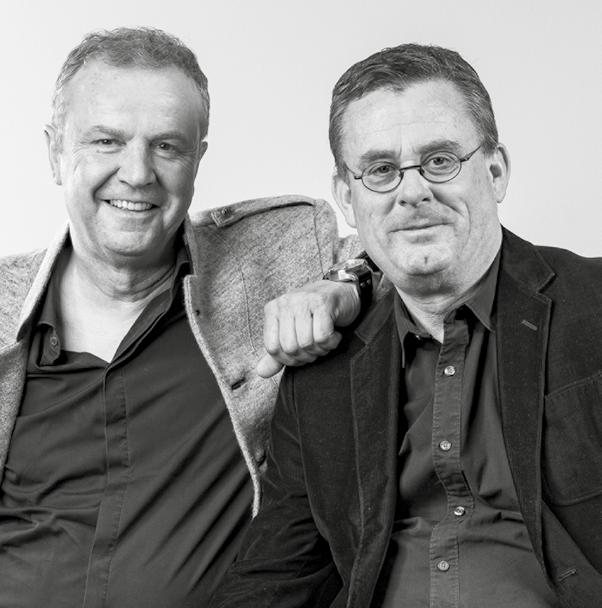
Medartis 360° — Behind the scenes at the headquarters / 16
25 years of Medartis — The company history
• 1997 – 2004: Headfirst / 28
• 2005 – 2017: Into the extremes / 42
• 2018 – 2022: Entering new realms / 64
• Christine Hasler: Start it up! / 36
• Thomas Alge: "Are you talking about setting up your own subsidiary?" / 38
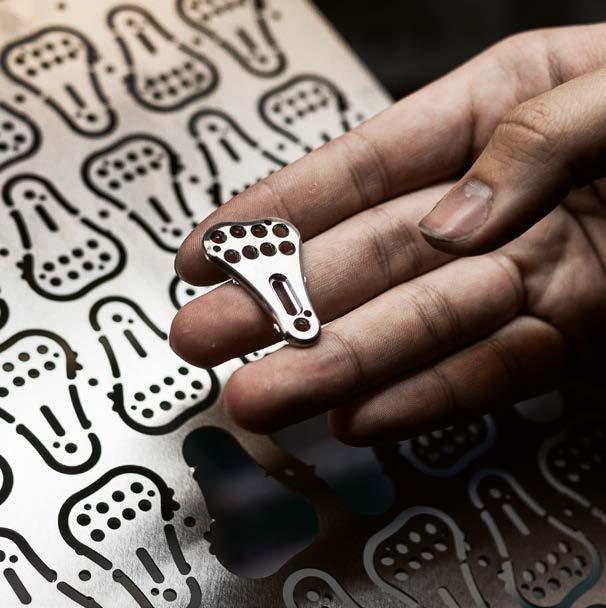
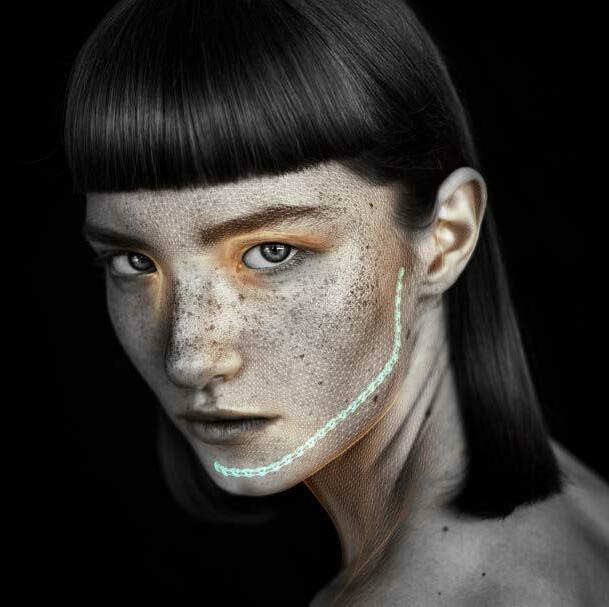
• Susi Walliser: Found the Dream Job / 54
• Kylian Jaworski: The Million Dollar Pitch / 74
• TriLock: On the right track / 40
• SpeedTip: Careful: extremely sharp! / 56
• CMX: Tailor-made / 72
Future prospects — Three young talents on
future
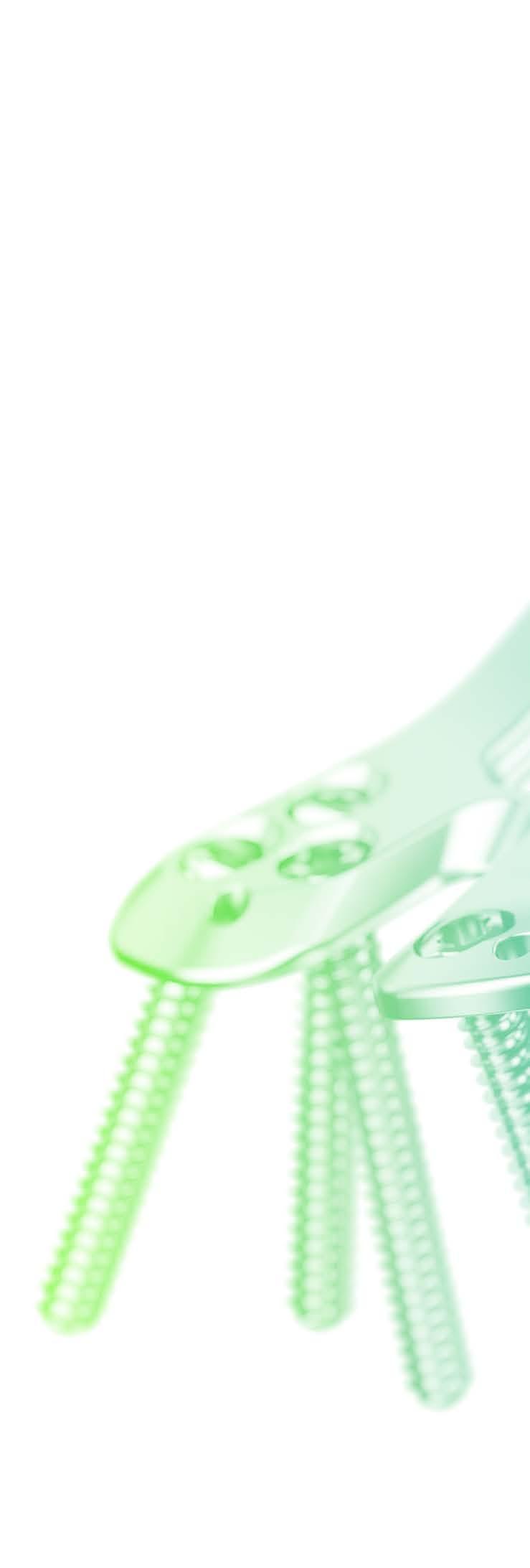

Medartis /
Testimonials — Customers and partners
/
Visions — CEO Christoph Brönnimann meets artist Heinz Julen at the foot of the Matterhorn /
— 25-year-old Medartis
speak about their
/
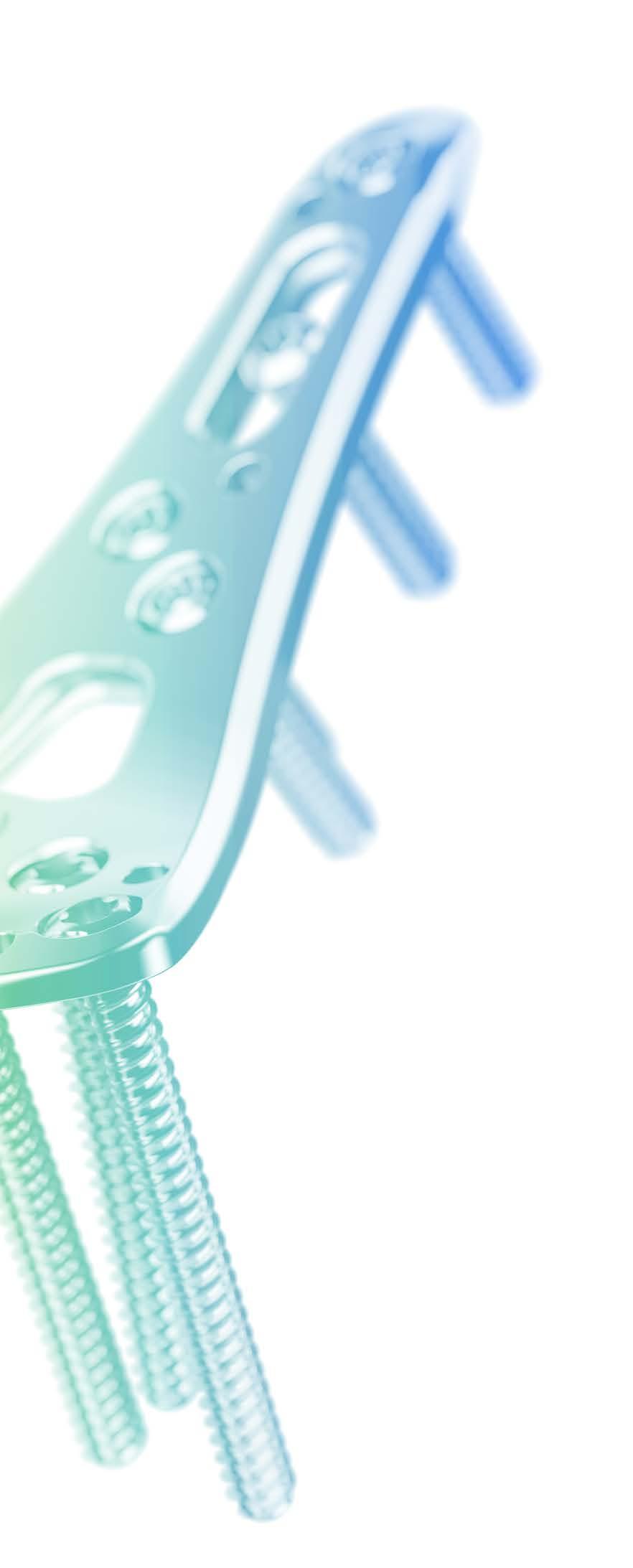

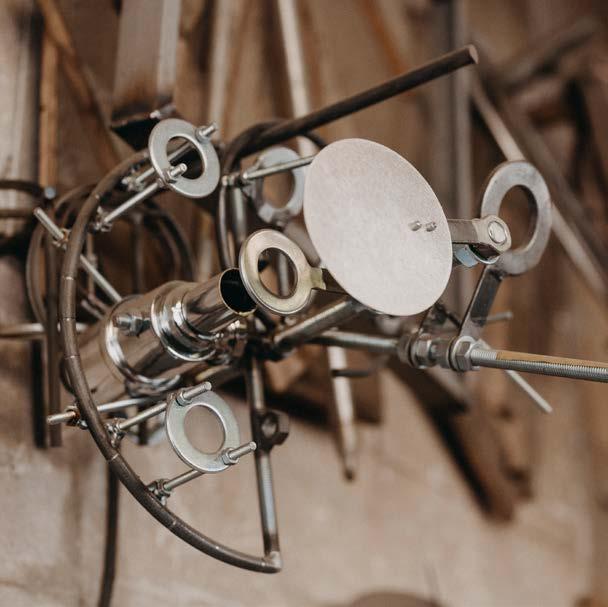
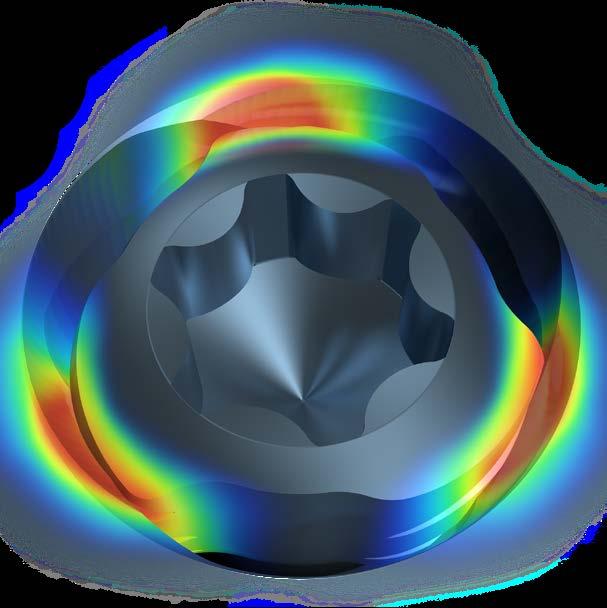
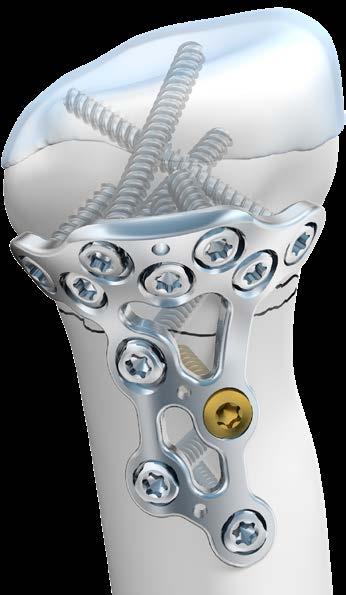

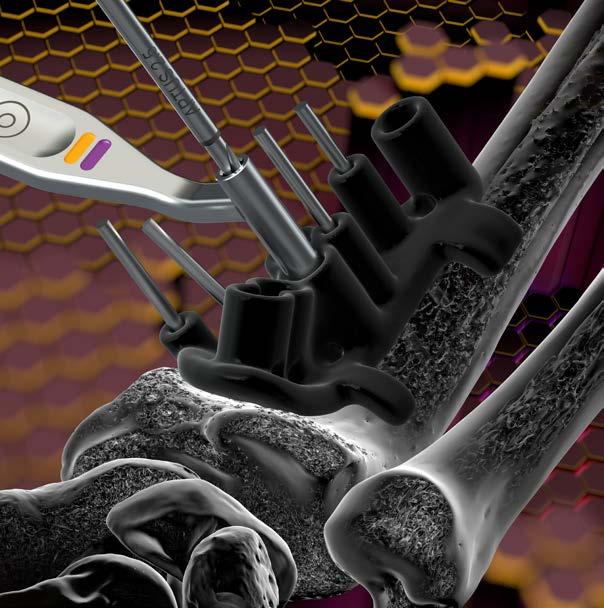
I am extremely pleased and proud to have been given the privilege of contributing the opening words to our 25th anniversary publication. The project team, under the leadership of Fabian Hildbrand and Patrick Christ, wanted to tell the company’s his tory in a creative and modern way, using a variety of sources. Specific experiences are described, anecdotes told, products in troduced, employees portrayed and visions for the future outlined, while avoiding navel-gazing. Nevertheless, we cannot en tirely do away with some digital elements. The content is rounded off with some QR codes to audiovisual contributions.
Let’s take a brief look at the past 25 years. The Medartis success story began in 1996 at a trade fair for oral surgery in Zurich. Our company founder Dr. h.c. Thomas Straumann had the opportunity to acquire a modular oral and cranio-maxillofacial surgery system from a Swedish neurosur gery manufacturer called Elekta that had the apt name MODUS. Elekta, feeling the pressure of the stock market at the time, wanted to focus on its core activities.
The initial talks took place at the trade fair and a year later the purchase agree ment was signed.
The years that followed were intensive and characterised by a pioneering, in novative and improvisational spirit. The company founder Thomas Straumann, together with his best friend from his youth Willi Miesch, and with the help of Dominik Ellenrieder, consistently ex panded the initially very small business, using their abundant passion and energy. At first, they focused on developing their own direct sales channels in Europe; and then, in 2004, the business was expanded with additional product lines. First prod ucts were added to the area of the upper and then to the lower extremities; and later, in 2005, the company started its own production.
Throughout these years, precision, quali ty, and a keen focus on the customers have been the hallmarks of Medartis. It is this unique combination of the passion for top manufacturing quality with an eye for de tail that still forms the foundation of our company today.
After doing intensive research, we revive these exciting times and bring it to our readers in this book. Those who recall the humble beginnings tell their stories and first memories. They give us a hint of the reasons why it took so long for Medartis to realise economic breakthroughs. They also talk about how important it is for technological leadership to keep in close contact with its users, i.e. the medical profession, and how this principle has been part of the Medartis DNA from the very beginning.
Despite the pandemic, 2021 was the most successful year in the history of Medartis. But we won’t rest on our laurels. Rather, we will concentrate on continuing to adapt our company to the challenges of the fu ture – and we will do so in the spirit of our founders: with humility, passion and the necessary openness to new ideas.
I am convinced that Medartis will contin ue to write success stories for the next 25 years, thanks to its talented and com mitted employees. I would like to take this opportunity to thank them for their great commitment and loyalty.
Many people – clients, employees, or busi ness partners – have been with us over the past 25 years and have contributed signifi cantly to our success. This anniversary publication is dedicated to them. We look forward to a successful future together.
We hope you enjoy reading it.
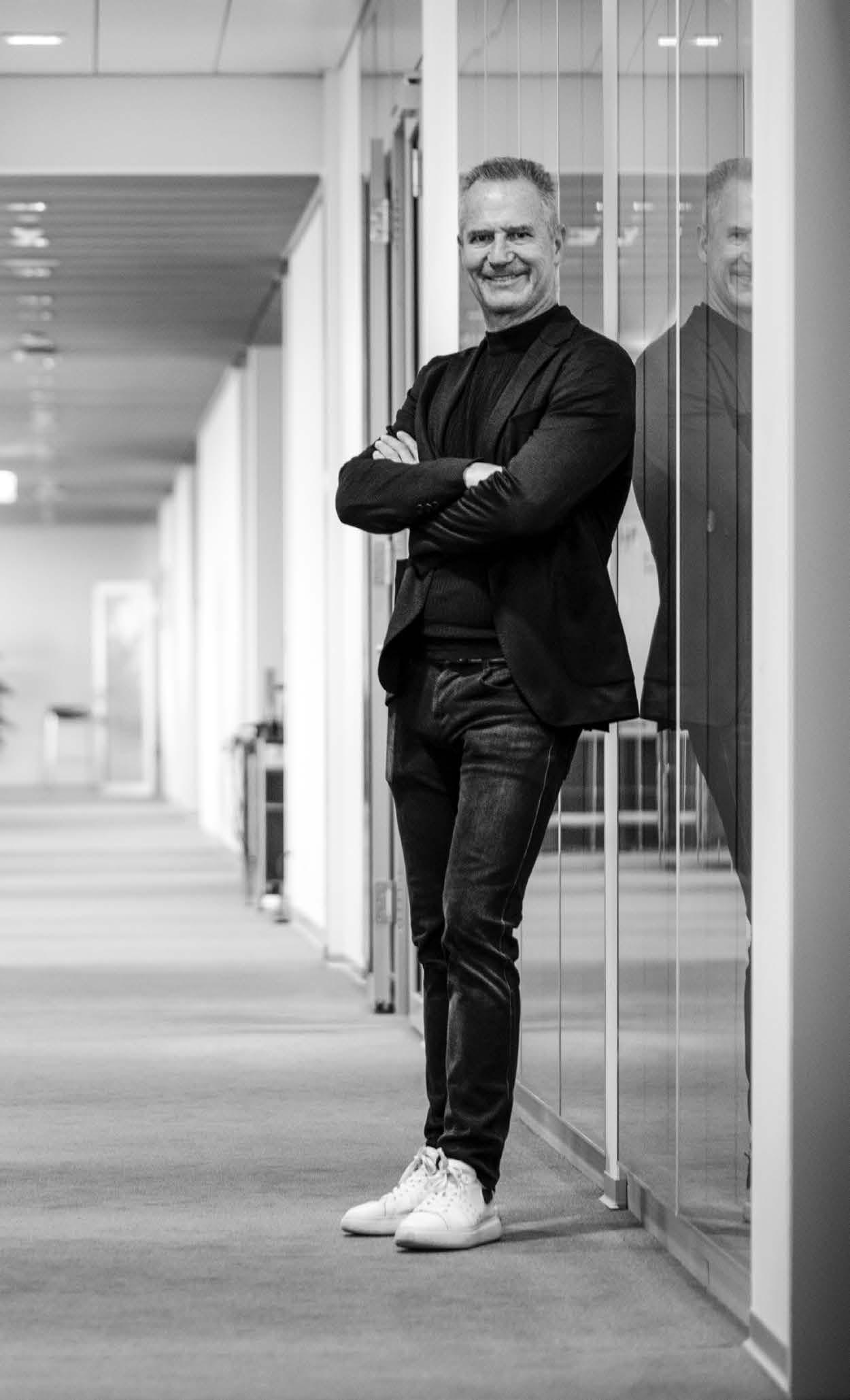
On behalf of the government of the Canton of the city of Basel, I am very pleased to have an opportunity to congratulate Medartis on its 25th anniversary. Founded and grown in Basel, Medartis has become a renowned representative of the regional medical technology industry. In the meantime, twelve subsidiaries have been added abroad. A total of more than 700 employees are responsible for the manufacture and marketing of over 5,000 products. In 2021, Medartis generated a turnover of almost 160 million Swiss francs – a considerable achievement in uncertain times like the present!
Dr Lukas Engelberger, Head of the City of Basel’s Department of Health and President of the Conference of Health Directors
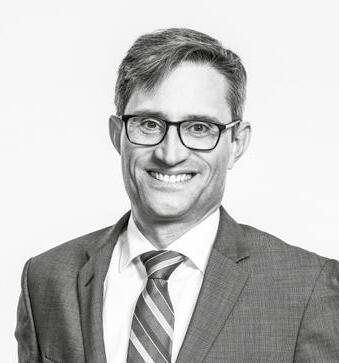
What makes Basel the most dynamic economic region in Switzerland and one of the most productive and innovative in the world?
At 25 years of age, Medartis has out grown its infancy, has put its Sturm und Drang (storm and stress) years behind it and has arrived on the business scene as one of the big players. The basic values of Medartis have not changed in a quarter of a century: The company stands for Swiss quality, innovation and close cooperation with its customers. With these values, Medartis is in the best of companies in Basel, as we are proud to be the home of many a top player in the life sciences in dustry, here on the banks of the Rhine.
Liberal labour laws, attrac tive corporate taxes, an efficient administration and political stability are strengths from which the companies in our region benefit. There are around 32,000 talented people in the life sciences in the Basel region, some of whom work for Medartis. However, there is more to a strong business location than just economic competence. The added value is captured in the name of Medartis, as it contains the word “art”, which communicates that it is also about creative skills. It is thanks to these skills that Medartis was able to become a leader in international medical technology over the past 25 years.
Medical technology is the basis for firstclass medical care. That is why I am grateful that companies like Medartis develop products and solutions from Basel for the benefit of patients all over the world. I wish Medartis every success for the future – here’s to another 25 innovative years!
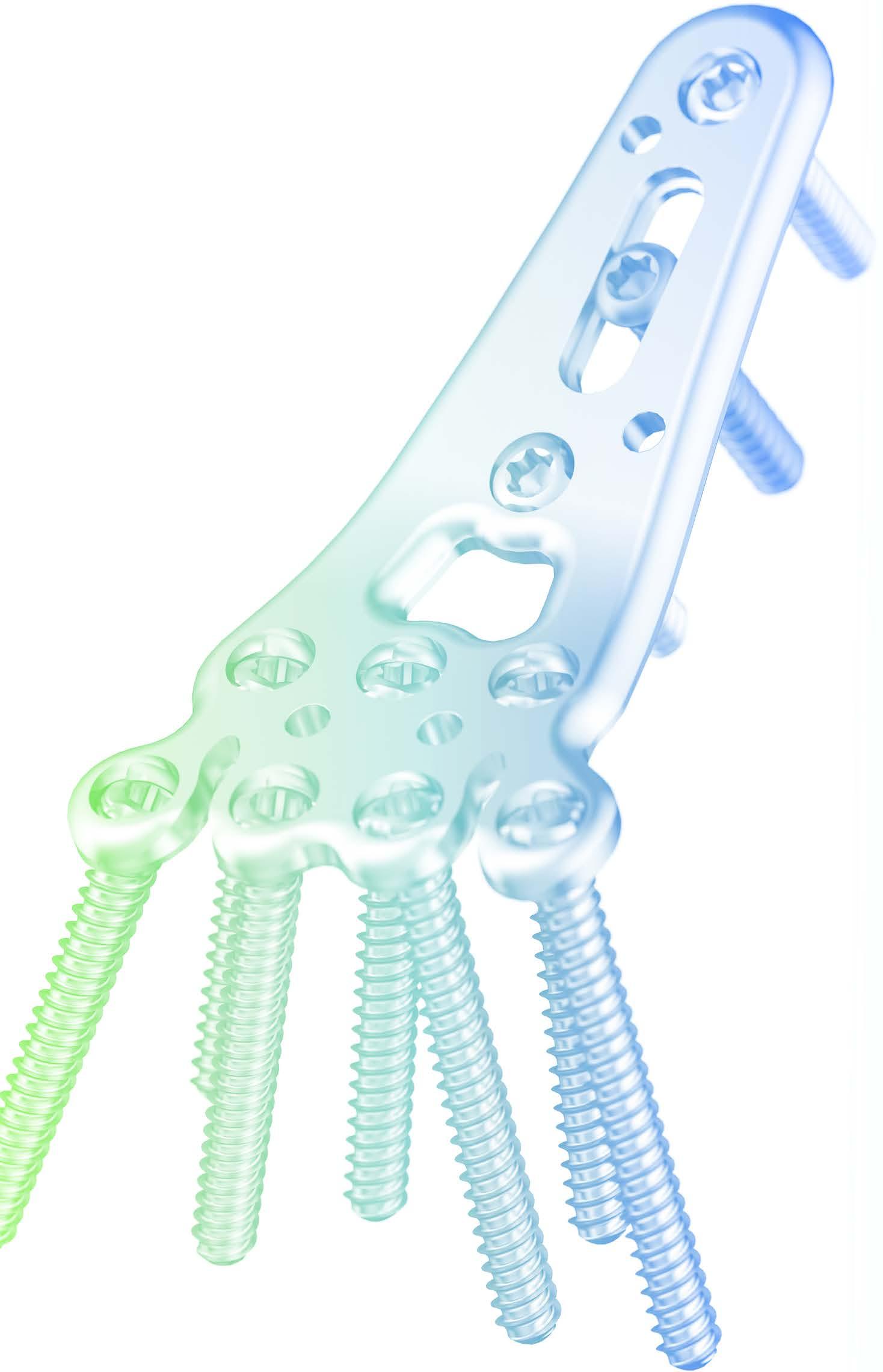
“Youth is like diamonds in the sun, and diamonds are forever” from the song “Forever Young” by Alphaville, 1984
Long before Thomas Straumann and Willi Miesch became entrepreneurs of Medartis in 1997, they were best of friends. They did their apprenticeship together, pimped their motorcycles, pulled boozy all-nighters and sometimes made their parents’ and bosses’ blood boil. They were just two lads from the Basel region who chased after their dreams and believed they could one day conquer the world.
It’s 3 a.m. and the alarm clock is ringing. A quick shave, then the loud sound of a 44 Dodge Wagon Car is heard outside the flat. Willi Miesch puts on a second pair of trousers, a third jacket, military boots, a pair of gloves, a scarf and a cap, then steps outside. It’s freezing cold. Wrapped in army blankets, Tommy Straumann is sitting behind the wheel of the open army Dodge and waves hi to his friend Willi. Miesch gets in, then the two of them thun der off into the dark night.
Thomas “Tommy” Straumann and Willi Miesch met as apprentices at the Straumann Institute. The company, famous for its surgical metal implants, was on the verge of an international breakthrough at the time, while other traditional precision-mechanical companies in the Walden burgertal valley were struggling – such as the Oris watch factory in Hölstein, which had to close down in the autumn of 1982 as a result of the quartz crisis. 140 employees and 20 appren tices were suddenly out of work, including Willi Miesch. Thanks to his excellent references he
immediately found a new apprenticeship, two towns away at Straumann.
Thomas Straumann still remembers the first time he saw Miesch. The prototype workshop radio was playing Felicità by Al Bano and Romina Power. But then the master teacher, Sylvian Schäuble, turned off the radio and said: “That’s the new guy, Miesch Willi, he’s from Oris.” Straumann was immediately impressed – by Miesch's head of curls and even more so by his self-confidence.
Eight precision mechanics were employed in the prototype workshop at that time. There was an unusual hierarchical set-up between the two ap prentices: Willi Miesch was new at Straumann and a year younger than Tommy Straumann, but he was ahead of him professionally. After all, he was already in his third year of the appren ticeship, while the CEO’s son had just started. Before that, Straumann had struggled through to the 12th grade at the Rudolf Steiner School in Pratteln . His father, Fritz, hoped that his only son would somehow obtain a university entrance qualification and be able to apply for higher education.
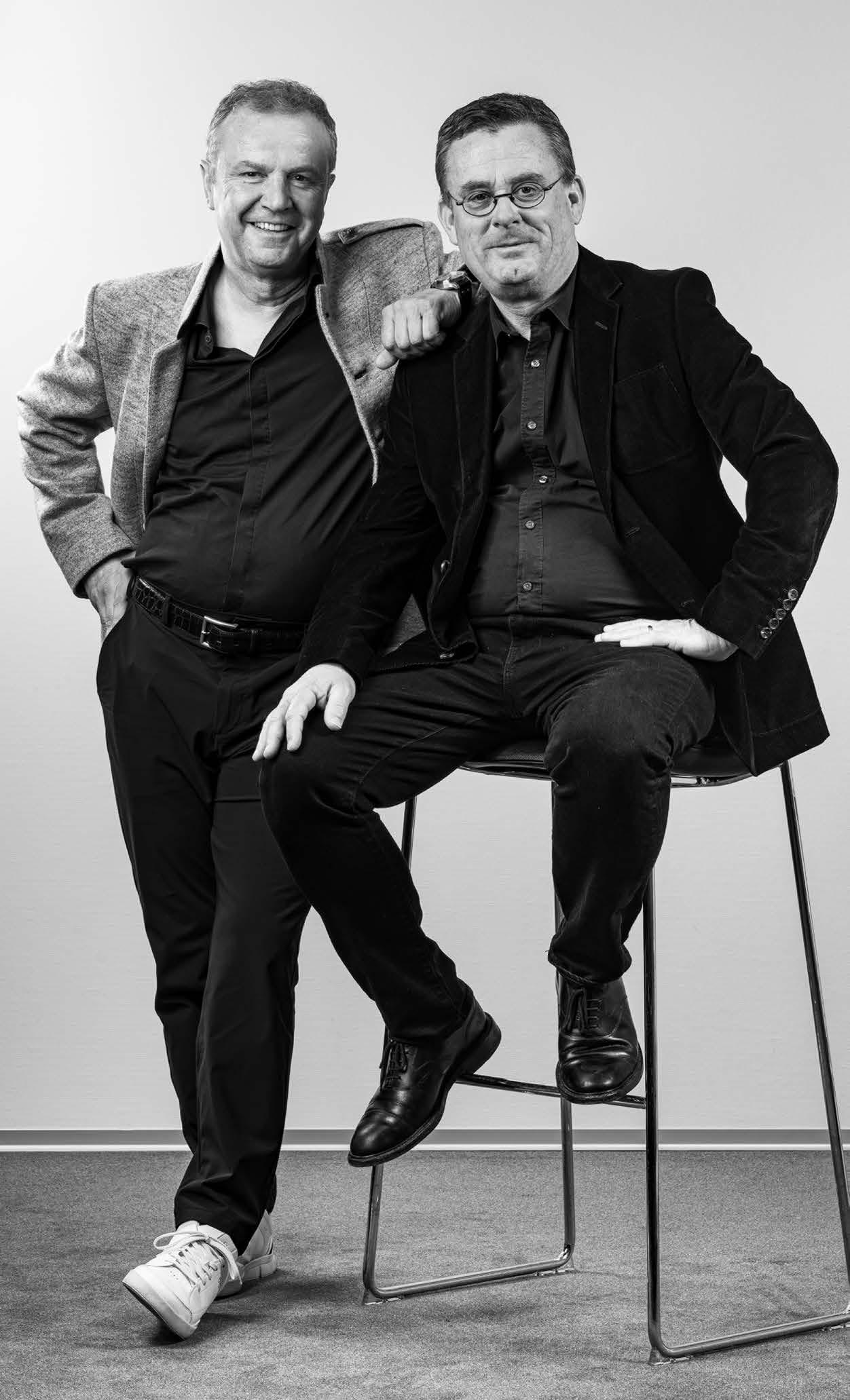
Practicing from a young age: 17-year-old Thomas Straumann at a course by the Association for Osteosynthesis (AO) in Davos in 1980. The AO was the most important scientific partner of the Straumann Institute AG.
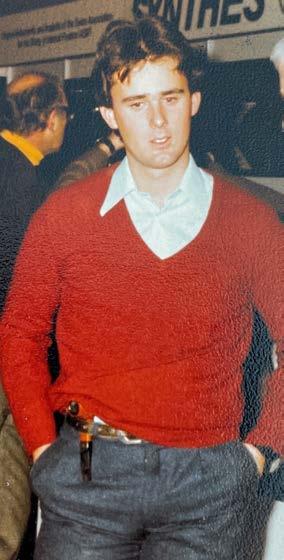
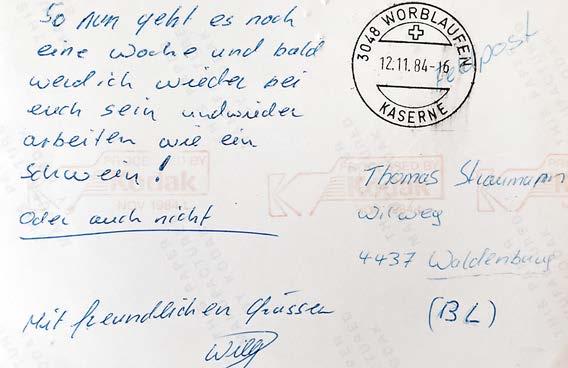
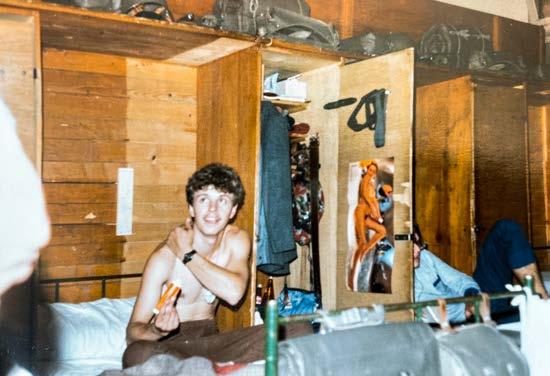
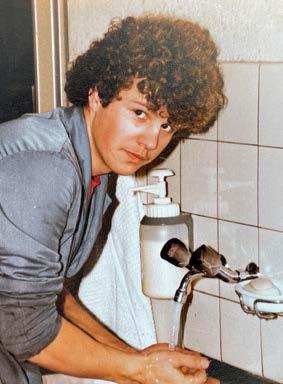
Thomas Straumann and Willi Miesch met as apprentices at the Straumann Institute and quickly became close friends. Willi Miesch sent his friend a photo postcard by post from his time as a recruit in 1984: “So now it’s one more week and soon I’ll be back with you and working like a dog again! Or not! Kind regards, Willy”
The “new kid on the block”: In 1983 Willi Miesch, who was highly gifted with technical skills, started as a precision mechanic apprentice at Straumann after his first apprenticing company, the Oris watch factory, had to shut down its production in Hölstein due to the crisis.
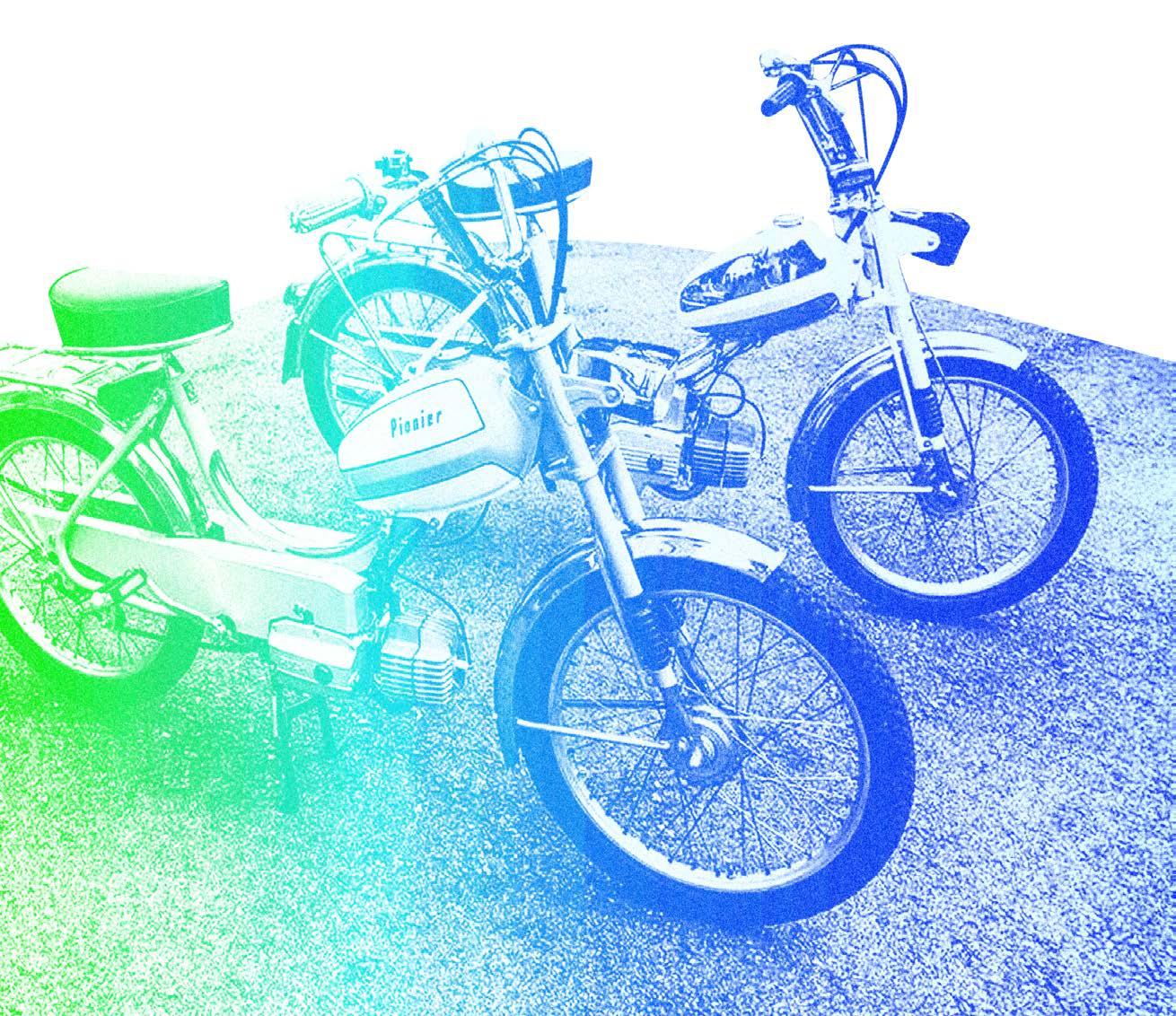
Straumann and Willi Miesch can put their skills gained in their precision mechanic apprenticeships to great use, for example, for their hobby of souping up their motorcycles.
This hope was not fulfilled, however, and since the Straumann household was not known for handing out rewards to slack ers, Thomas Straumann, as an apprentice in his father’s business, like any other new kid on the block, had to fetch snacks for his colleagues, sweep out the grinding room at the end of the working day, and, on top of that, stand guard for the young er but higher-ranking friend Miesch when the latter sneaked off to the broom closet for a quick nap.
In the workshop, the two learnt the ins and outs of precision mechanics from scratch: turning, milling, drilling and grinding metals – skills that could also be put to excellent use in their free time. For example, when pimping their motor cycles: opening the air filter, optimising the carburettor, drilling out the intake manifold, cleaning out the exhaust pipe, working on the pistons ... This is how the lives of the two were rapidly picking up speed, even though it was still unclear where the journey was going. Straumann and Miesch were crazy about motorbikes and fast cars, used to stay out all night in Zurich and Basel, spent their skiing holidays in the Straumanns’ holiday flat in Davos, and were passionate about collecting militaria. They would drive to Thun every year in their self-restored Dodge Wagon Car to the so-called “Army-Gant”, where the Swiss army used to sell old materials.
And if they were very lucky, they were allowed to fire off an entire round of ammunition at the Sand-Schoenbühl shooting range where differ ent targets were set up, made of varying alloys, testing their resistance. Notably, the Straumann Institute and the Swiss Army, who regularly commissioned the Institute with this kind of work, assigned this task to them officially. Nev ertheless, one of the Army captains once com plained to the two youngsters: “You’re making more noise than a whole military company!”
Then Thomas Straumann discovered a new love: a Hungarian shepherd dog and of course he took his best friend, Willi, along with him to the breeder. Only then did Miesch realise what kind of calibre of animal they were dealing with: a fully-grown Kuvasz weighs over 60 kg and reaches belly button height! Suddenly a puppy
jumped up at him and wouldn’t let go. In the end Straumann and Miesch drove home with two puppies, one for each of them. Two brothers for two friends – with great hearts for animals.
When Straumann got married in 1985, Miesch was his best man, and when Straumann became a father a year later, Miesch was the baby’s godfather. There was – even to this day – only one year in which the two had almost lost touch with each other: when Fritz Straumann sent Miesch to the USA in 1987 for personal development. There, the aspiring mechan ic was to refine his English skills and familiarise himself with a new type of just-in-time production at the partner company Synthes in Colorado Springs. Miesch enjoyed the big wide world, the huge cars, the American way of life. He only missed three things: “Cervelat” Swiss sausages, “Thomy” the mustard, and Tommy his friend. All three were waiting for him in the arrival hall at the Zurich-Kloten airport when Miesch returned to Switzerland after spending a year abroad.
At the age of 25, Thomas Straumann got married and became a father. He had continued his education at the Basel Management School and was attending the Commercial Management School of the KV Baselland. Nevertheless, he was still undecided about his career. Should he catch up on his school-leaving exams and attend a technical college?
Or maybe even study veterinary medicine?
Or continue his career in the family busi ness? But where was his place supposed to be in this company – with a brotherin-law who was in charge of operations, with three older sisters who were all involved in the business, and with an overbearing father who had not yet learnt to trust his son’s entrepreneurial skills. “Tommy was under a lot of pressure at the time,” recalls Willi Miesch.
On 7 September 1988, the Straumann family suffered a heavy blow. Thomas Straumann was completing his first solo flight in a Piper Arrow when he received a message from the control
tower telling him to land immediately and report home. A little later, he rushed across the tarmac to the nearest phone. His sister answered in a shaky voice: “Daddy, has died.” At the age of 67. A heart attack. And if Thomas Straumann was a dreamer up to that point, he now became a doer.
After the funeral service in the church of Waldenburg and the burial of Fritz Straumann, the bereaved families were faced with a major question: What should happen to the Straumann Institute AG, which had developed into a group of companies with numerous subsidiaries and a turnover of over 100 million Swiss francs? The core business was still the development and manufacture of screws and plates for the surgical fixation of fractures, known as osteosynthesis in professional circles, or “bone locksmith ing” in rural jargon.
The Straumann family decided to sell their prof itable business – not to the highest bidder, a foreign med-tech group, but to the ambitious managing director of the business Rudolf Maag. After having secured the financial backing of various banks, Maag ventured into the buy-out. Starting in 1990, he successfully continued the osteosynthesis business under the name of Stratec Medical.
The proceeds from the sale enabled all the heirs to make a fresh start, including Thomas Straumann. More clearly than ever, he saw his chance to build something of his own, something visionary, some thing that might even bring a posthumous smile to his father’s face. He saw a major development potential in the hitherto little-noticed field of dental implants – as did his brother-in-law, by the way. But the brother-in-law had graciously given Straumann the lead. “Your name is on the roof of the company building,” he said, “so you should continue to run the company.”
As a result, the heirs separated the dental busi ness of the Straumann Insitute AG from the as sets sold to Rudolf Maag and gave it to Thomas Straumann. Straumann thus became a young entrepreneur, inheriting 25 employees.
The death of his patron also hit Willi Miesch very hard. Fritz Straumann had always kept a benev olent eye on the talented carpenter’s son, chal lenging and encouraging him as if he were his own son. Early on, Miesch had the opportunity to work with leading surgeons and pioneers in the field of osteosynthesis. And often, together with his friend Thomas, he would accompany Fritz Straumann on business trips and confer ences abroad.
With the sale of the osteosynthesis busi ness to Rudolf Maag, however, the profes sional paths of Willi Miesch and Thomas Straumann separated, as Miesch now became an employee of Stratec Medical. He continued his career under Rudolf Maag and studied part time until he grad uated from the technical college in Baden. He wrote his final thesis on Computer Integrated Manufacturing, focussing on the use of information technologies at the new Stratec plant in Mezzovico (TI).
In 1994, Miesch received a job offer from the upand-coming Swiss bicycle manufacturer Villiger, which had just bought a second bicycle factory in Chemnitz in eastern Germany. Villiger wanted Miesch to be the head of production and a mem ber of the management board – an offer that a young man of not even 30 couldn’t refuse.
The professional distance did not affect the friendship between Miesch and Straumann. They would call each other several times a week. They spent their time doing things together, like sailing or hiking with their dogs. When Miesch became a father for the first time in 1996, he asked Straumann to be his son’s godfather.
At that time, Thomas Straumann was already a shooting star on the Swiss entrepreneurial horizon. His decision to invest all his energy and a large part of his fortune into the rapid development of dental implants proved to be spot on. The market was growing by around 20 per cent a year, and Straumann and the then Swedish Nobel Pharma, later Nobel Biocare, were in a neck-and -neck race at that time. Straumann was more deter mined to expand the company’s product range with innovations developed in close cooperation with leading physicians from the International Team for Implantology (ITI).
Driving together in Fritz Straumann’s red Porsche 356, the patron of the Straumann Institute AG. Fritz Straumann supported Willi Miesch like his own son Thomas and used to take the two friends regularly with him to conferences, trade fairs and on busi ness trips.
Willi Miesch and Thomas Straumann in 1985 at a training course of the Association for Osteosynthesis, followed by an aperitif.
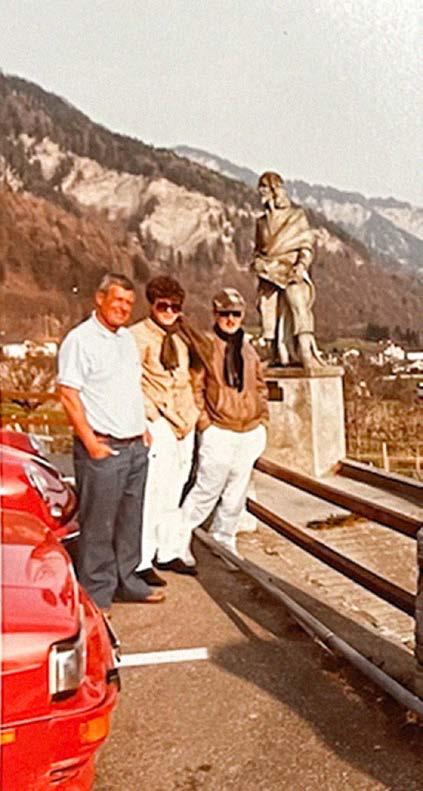
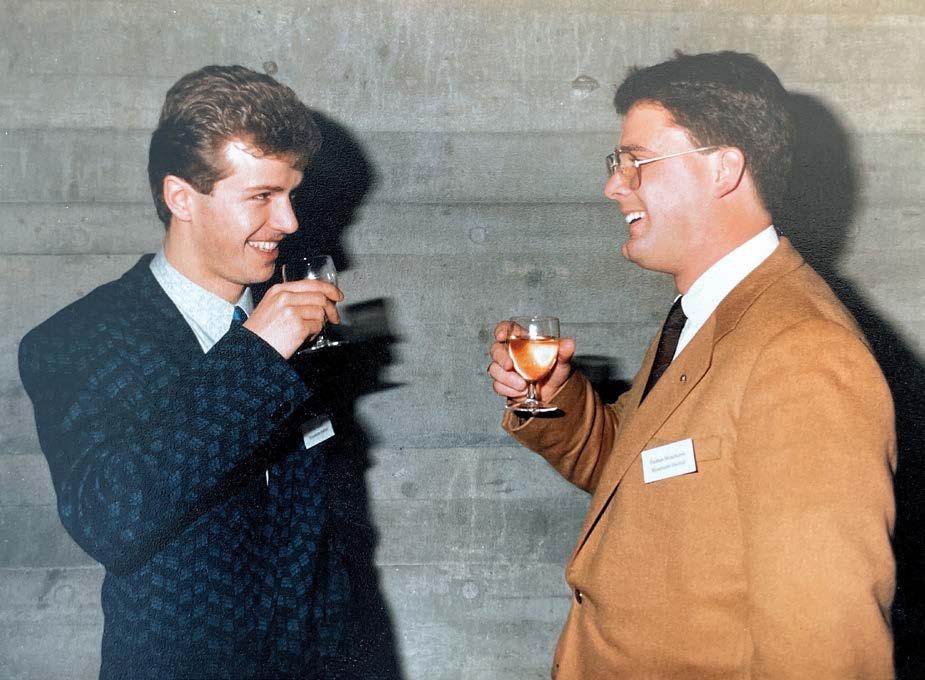
Over-comers of every obstacle: Thomas Straumann’s restored Dodge Wagon Car, 1944 edition.
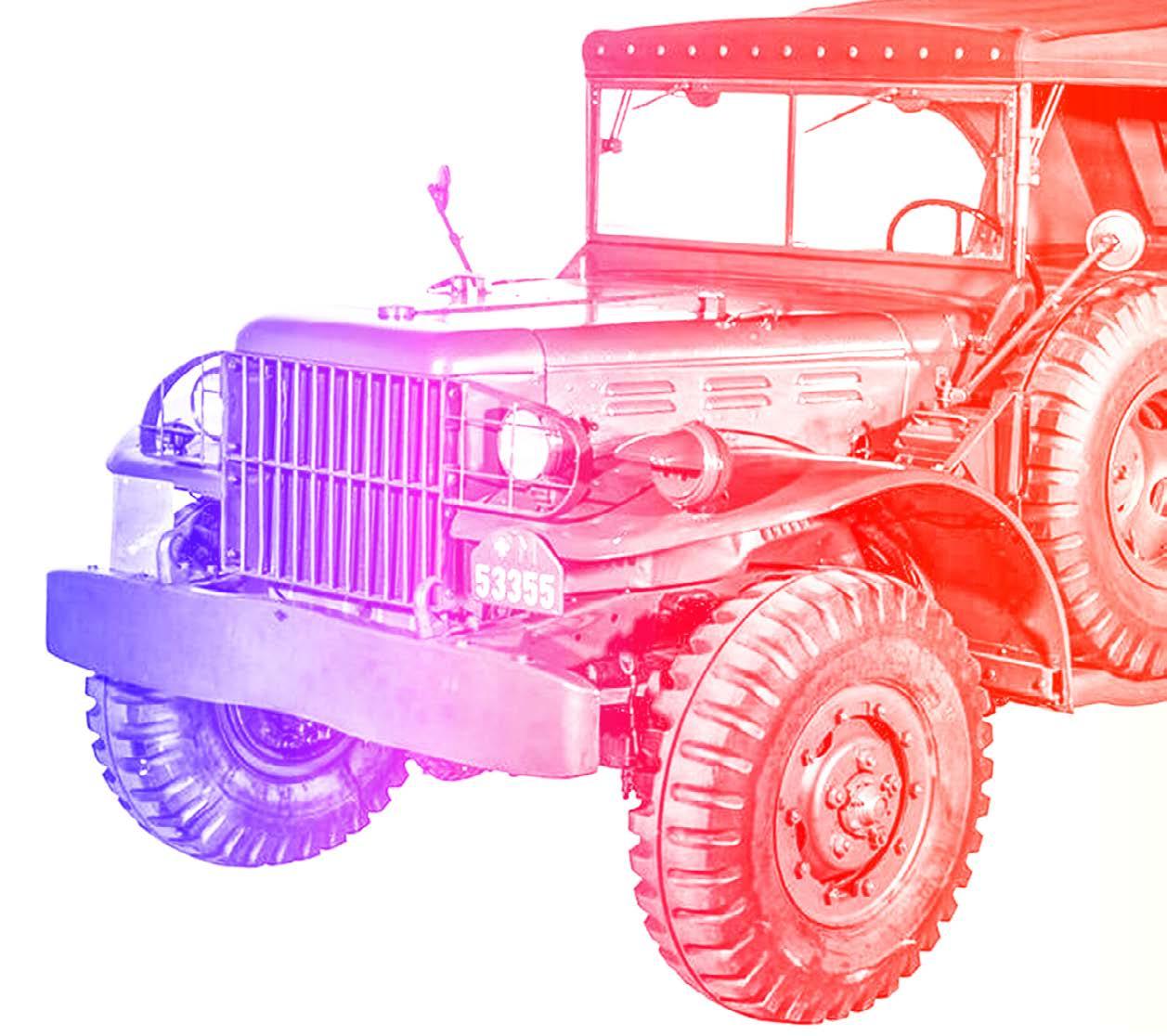
The Straumann Institute in Waldenburg around 1990. Thomas Straumann’s parents’ house (1) can be seen at the top of the picture, and directly below (2) the villa of his grandparents Fanny and Prof. Dr. Reinhard Straumann, who founded the Straumann Institute in 1954.
Thomas Straumann attended primary school in the Waldenburg schoolhouse (3) in the 1970s.
Directly behind it, the first buildings of the Straumann Institute (4) can be seen, including an extension built in 1967 (right). The annex also housed the prototype work shop where Thomas Straumann and Willi Miesch completed their poly-mechanical apprenticeship in the early 1980s.
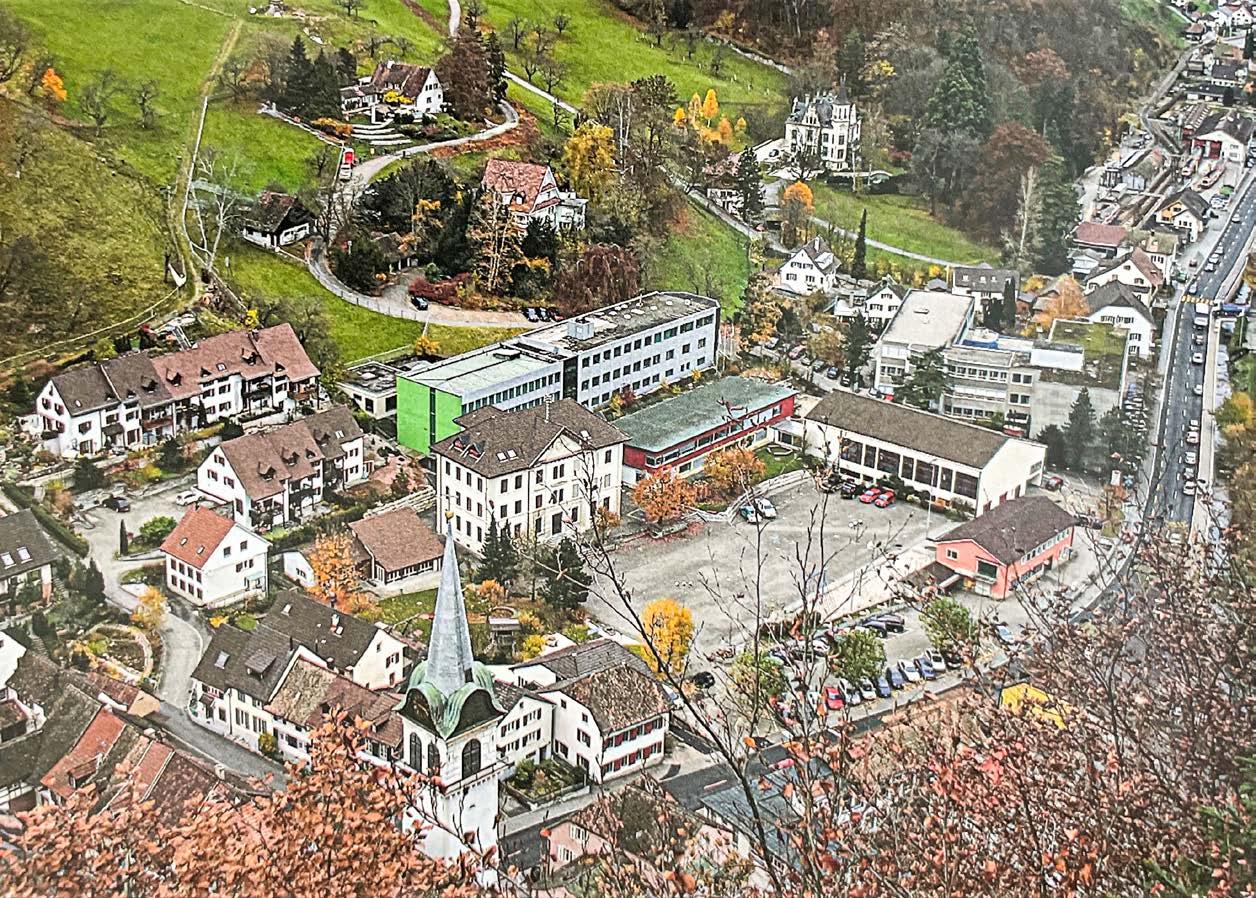
In the shadow of this building is the garage (5), where the two friends spent their free time pimping their motorcycles.
In the course of the steady growth of the Straumann Institute, addi tional company buildings were erected in 1972 and 1984 (6).
In seven years, Thomas Straumann had built up a global company that was larger than his ancestors’ group of companies. 25 employees had grown to 450, and the turnover was more than 100 million Swiss francs. Thomas Straumann had proved it, to himself and to a few others. He could now sit back and take a deep breath. But he did the opposite.
What drove him was a return to osteosyn thesis – initially limited to mandibular and maxillary surgery, where his Straumann AG had the necessary know-how and distribution channels. In 1996, at a trade fair in Zurich, one of his employees came across a colour-coded, modular implant system for oral and maxillofacial surgery. MODUS was developed by a German sub sidiary of the Swedish medical technology group Elekta. Thomas Straumann was enthusiastic and saw MODUS as the first ideal domino to kick off an entire chain of development in the field of osteosynthesis. But the others in his company were less enthusiastic.
The company was preparing its IPO (initial pub lic offering). It wanted to use new capital to ac celerate its growth even further – a plan that was causing much excitement among institu tional investors and market analysts. The only thing was: Straumann should not get bogged down and unsettle investors with a costly entry into a new field of business.
So while his reasoning said no to oste osynthesis, Thomas Straumann’s heart said the opposite. “You are still young! Believe in your dreams! Dare to try some thing new!” After all: Thomas Straumann knew at this point how to build up some thing, how to realise your dreams with much perseverance and the necessary cap ital. He called Willi Miesch on 4 August 1997.
The two of them arranged to meet at the Mövenpick Hotel in Egerkingen, ordered a beefsteak tartare and a beer each. Then Straumann put a few brochures and a small black suitcase on the table, opened it up and turned it towards his friend. Miesch’s eyes lit up instantly when he saw the MODUS colourful sparkling screws and plates. There it was again, immediately, this fascination with preci sion mechanics and osteosynthesis.
On 3 November 1997 Thomas Straumann bought the patents for the MODUS system from the Swedish company Elekta for 7.5 million Swiss francs. On the same day, together with Willi Miesch as managing director and partner and the investor Jürg Eichenberger, he founded Medartis AG.
And so a new era began.
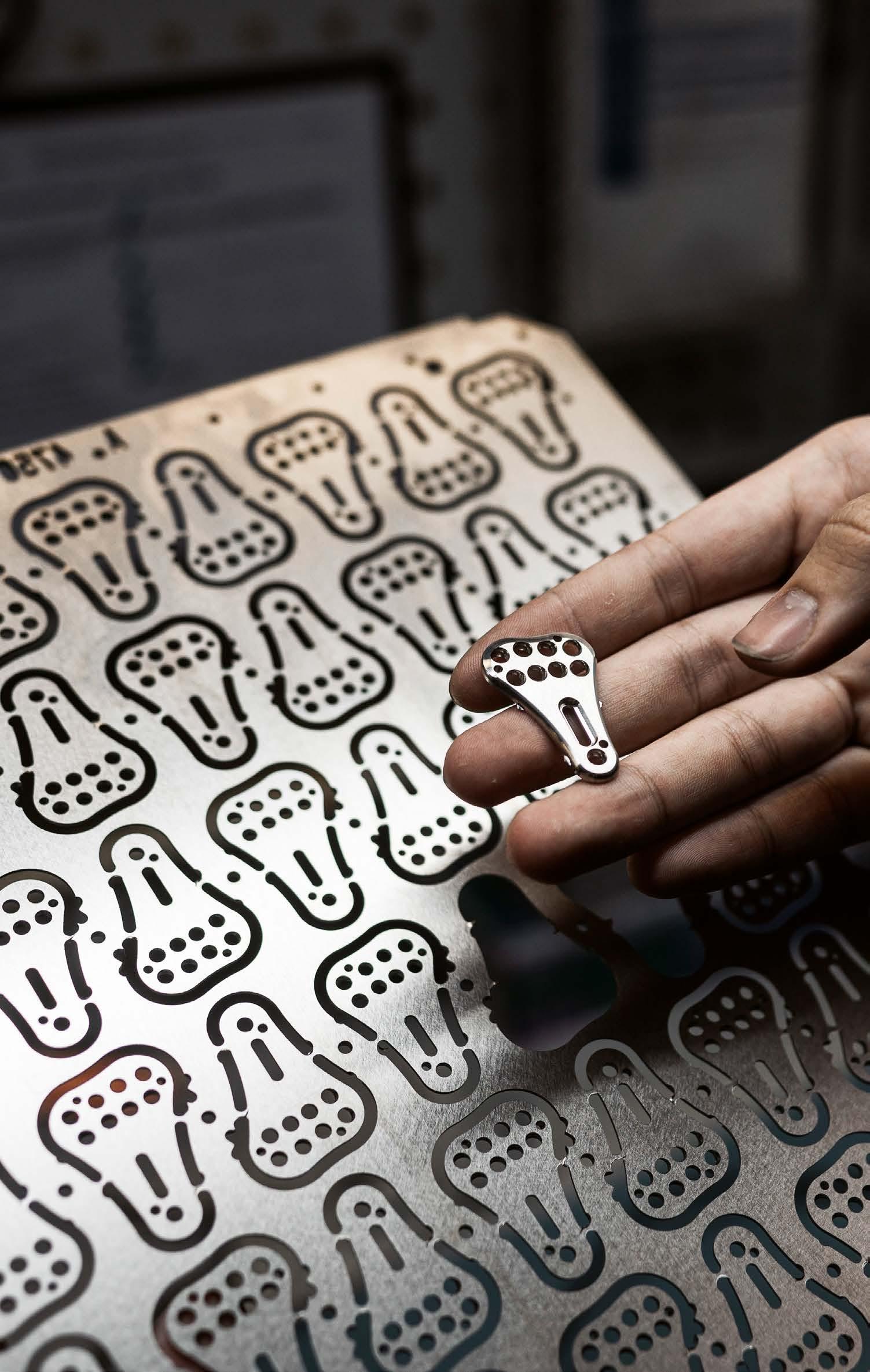
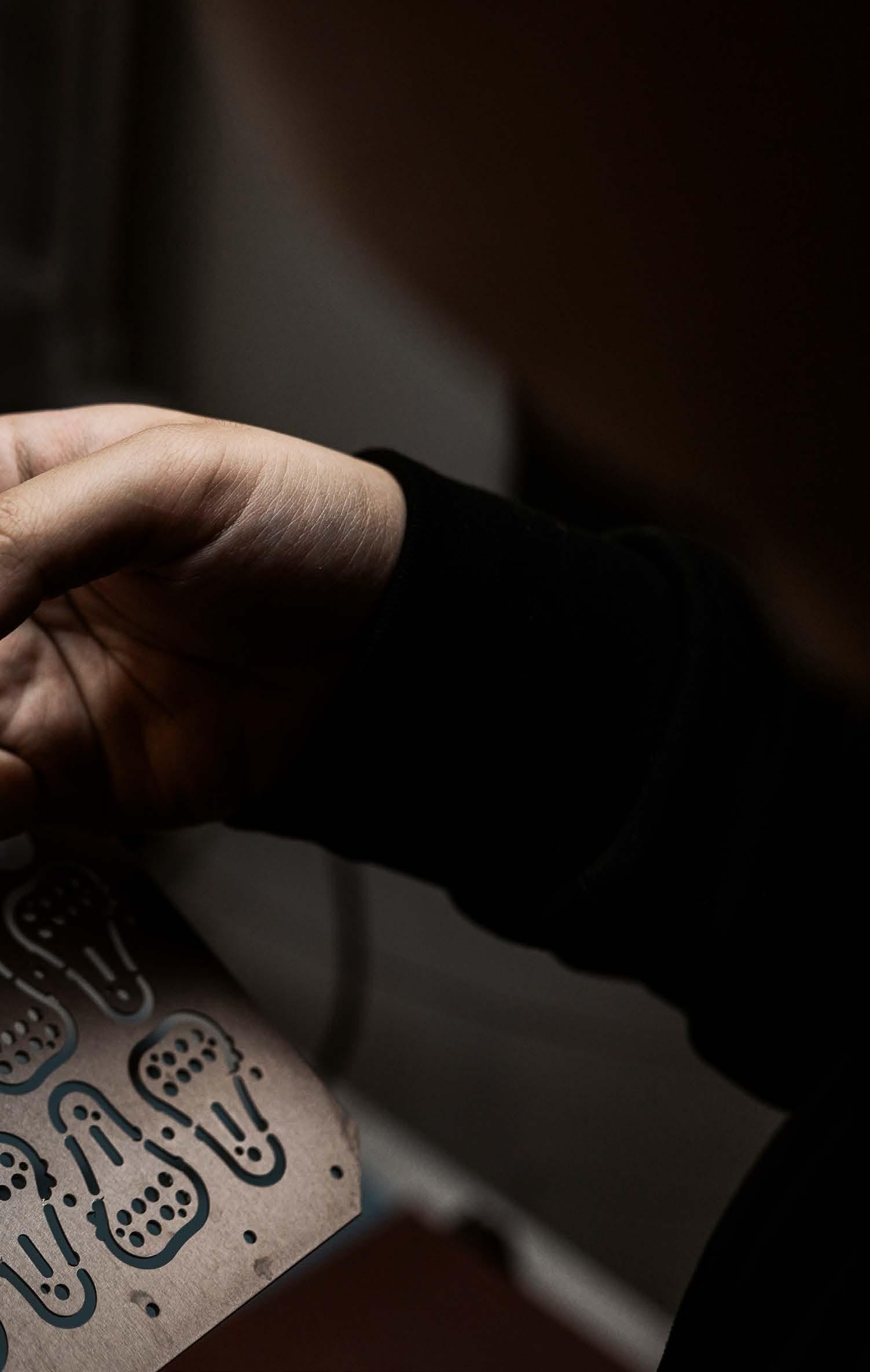
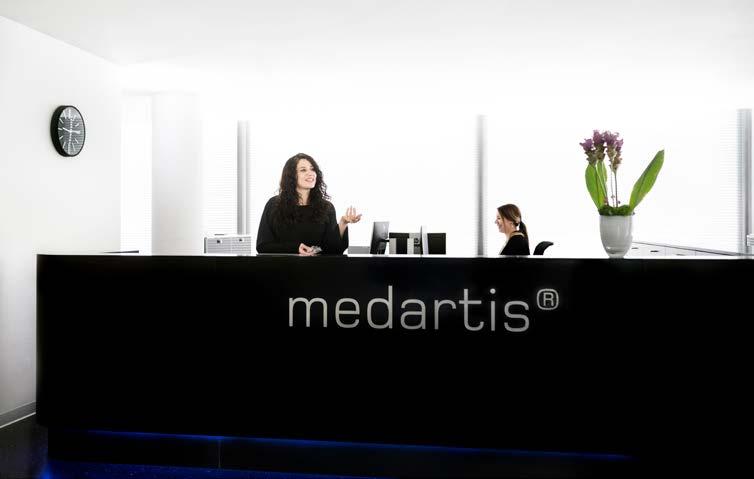
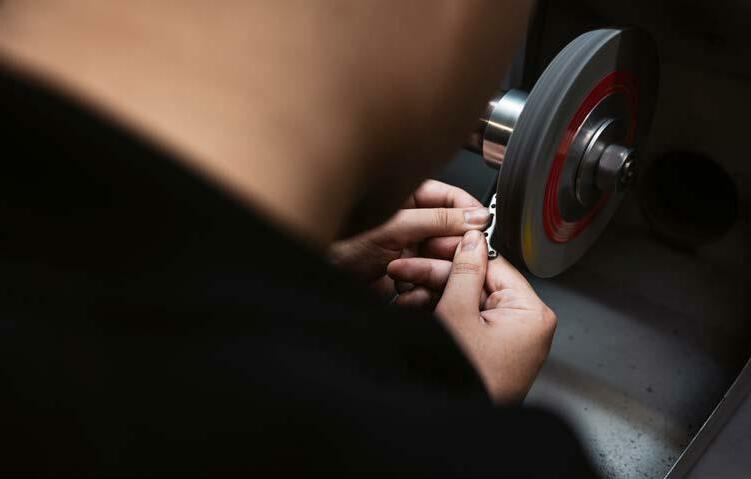
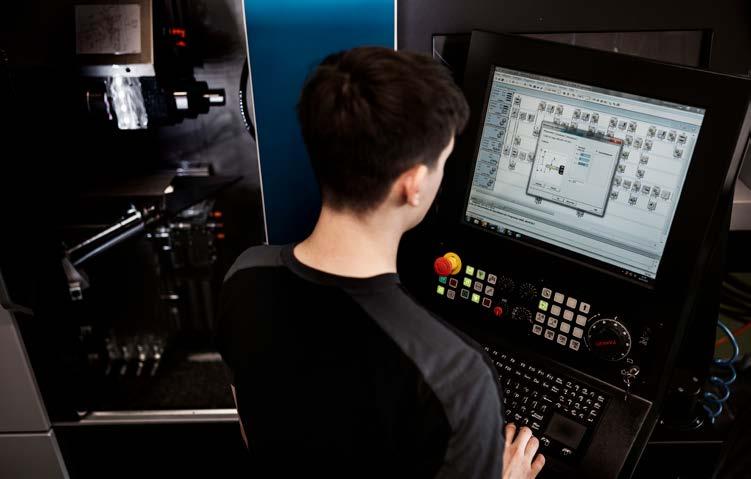
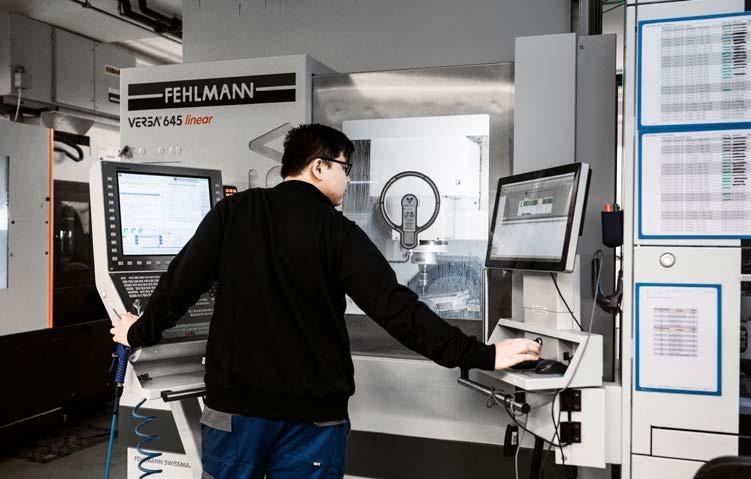
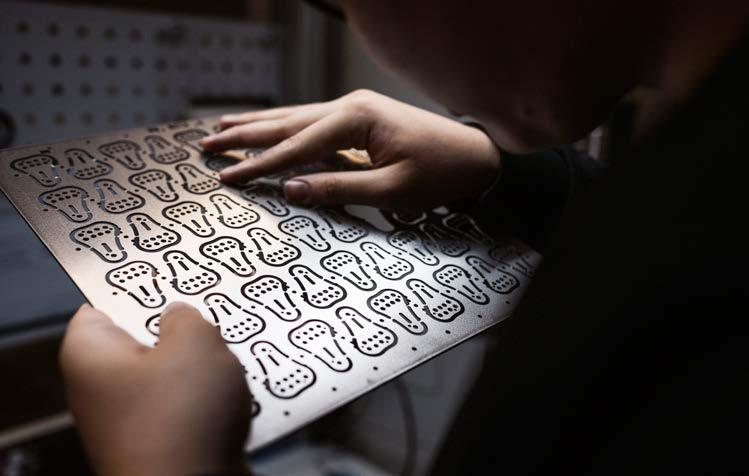
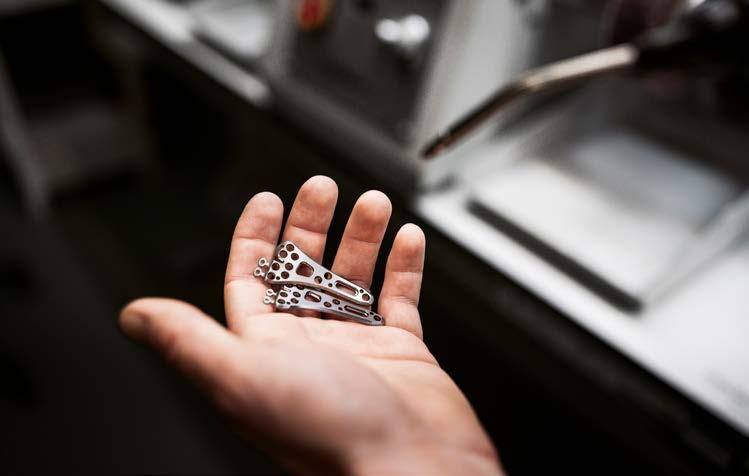
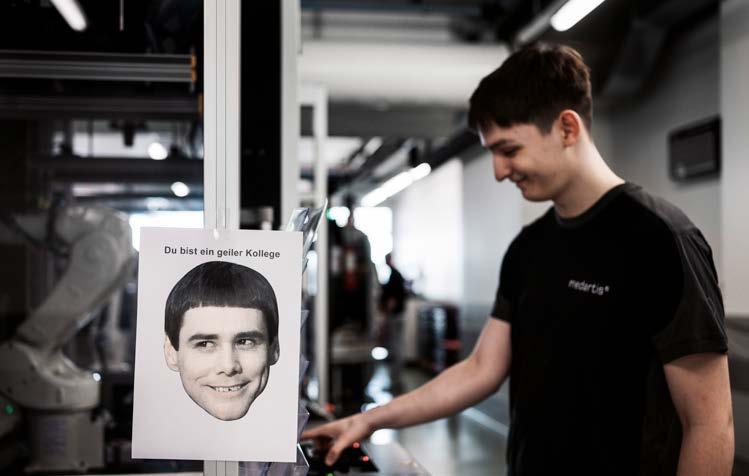
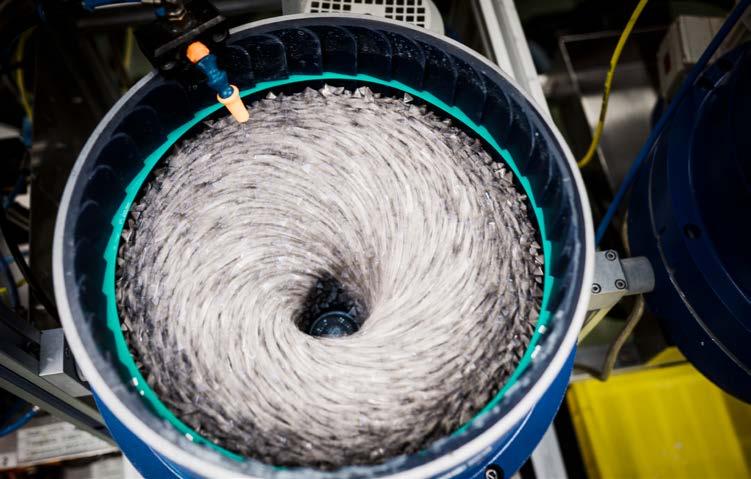
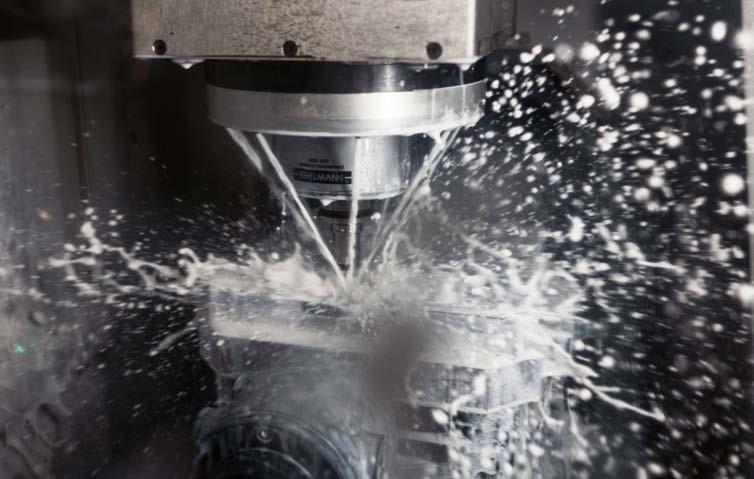
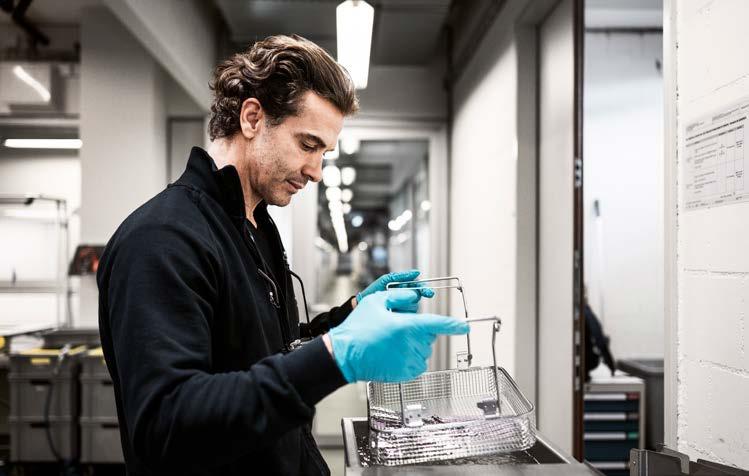
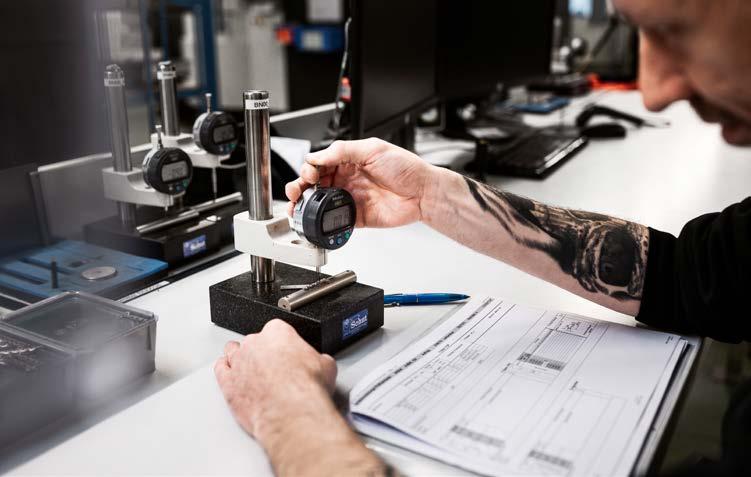
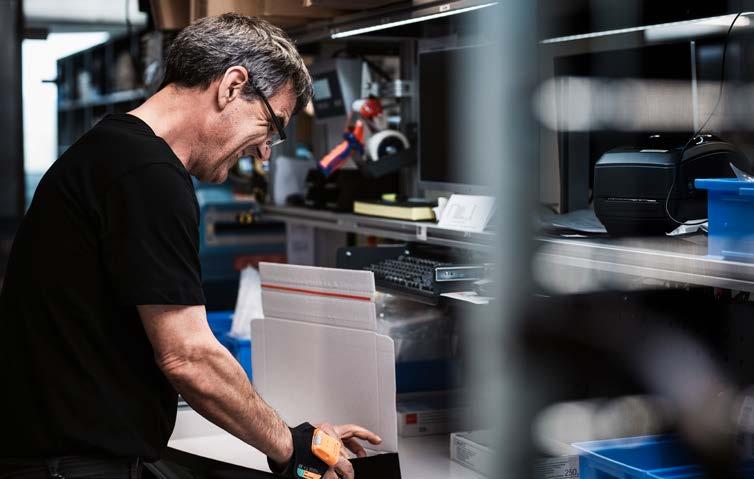
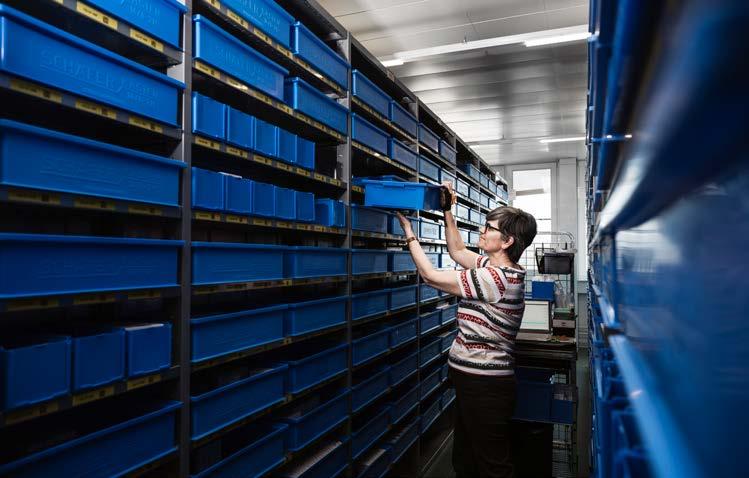
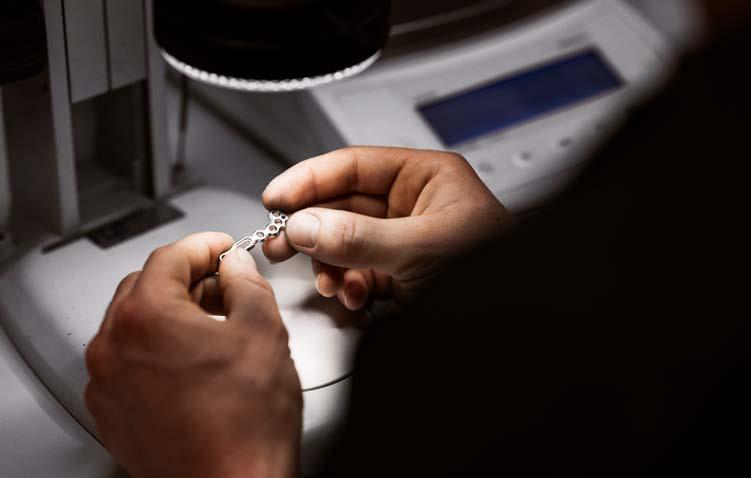
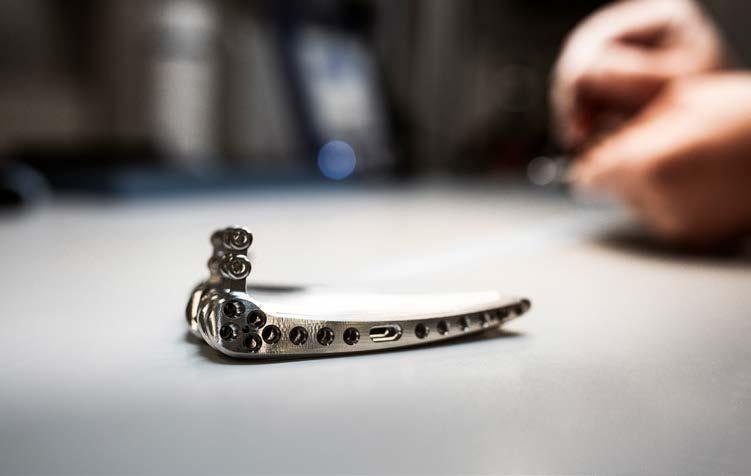
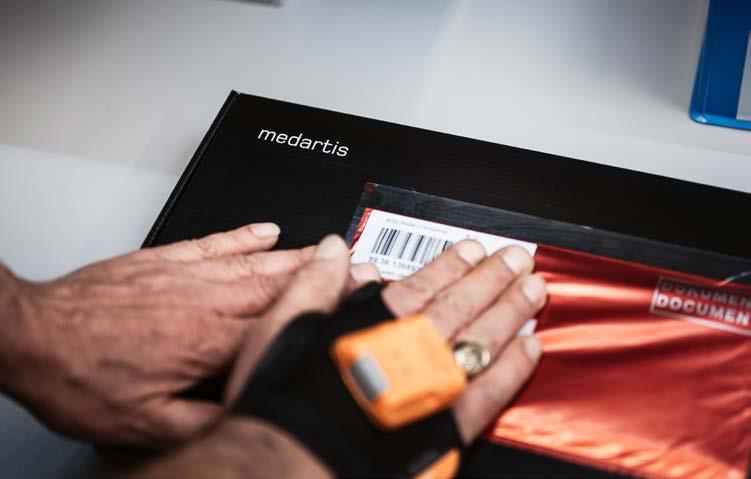
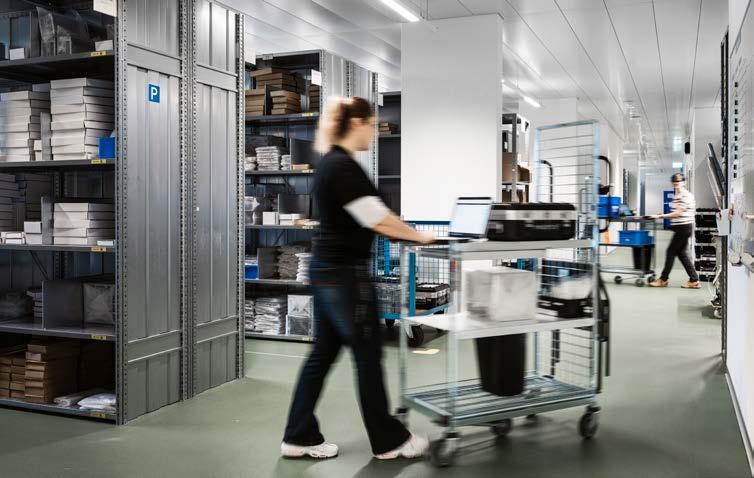
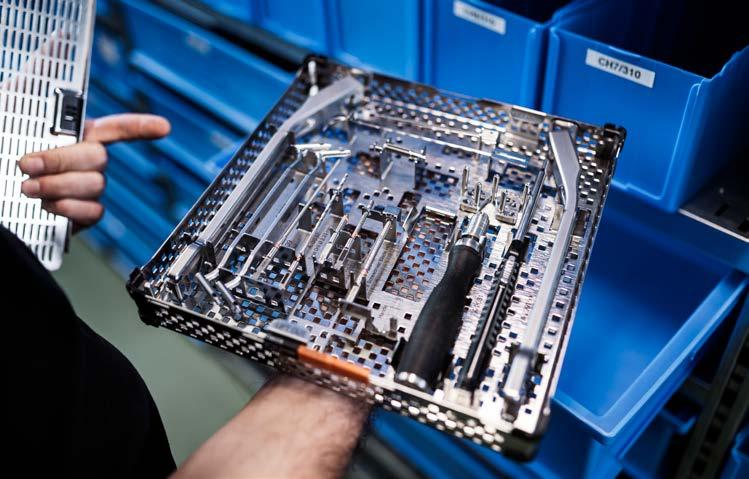
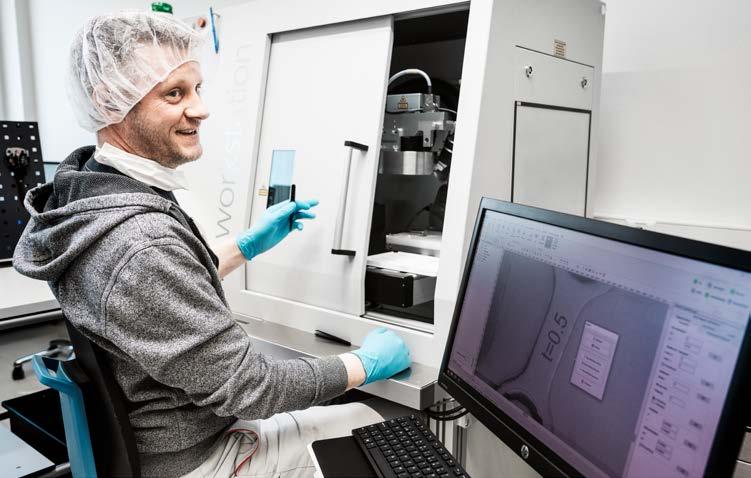
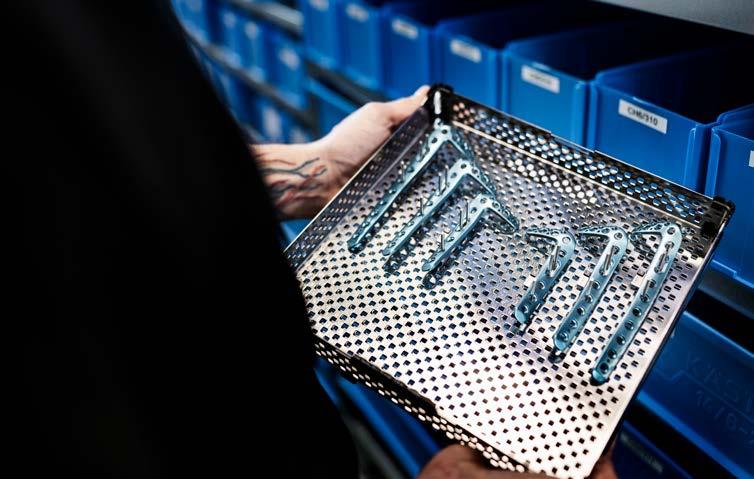
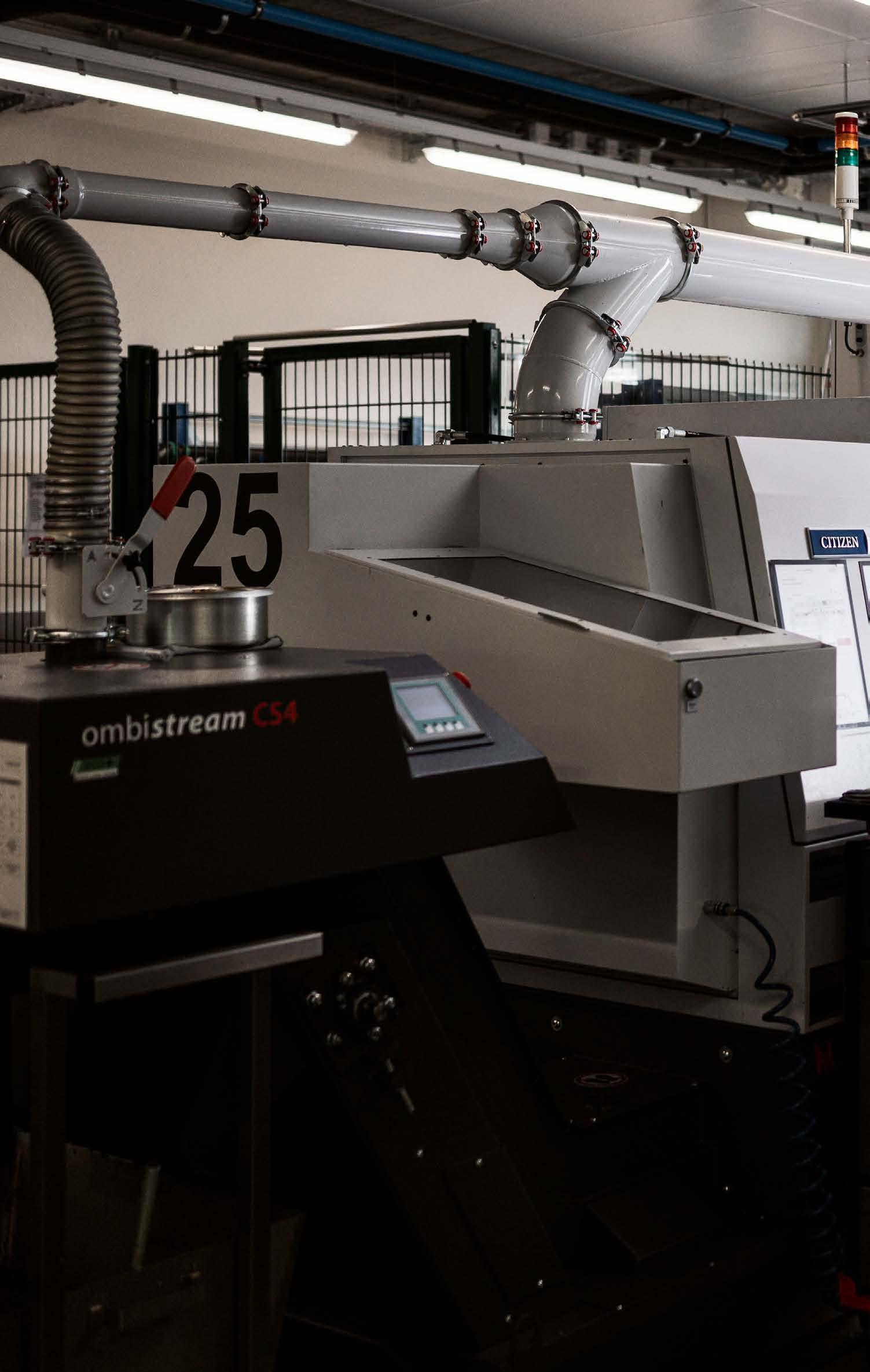
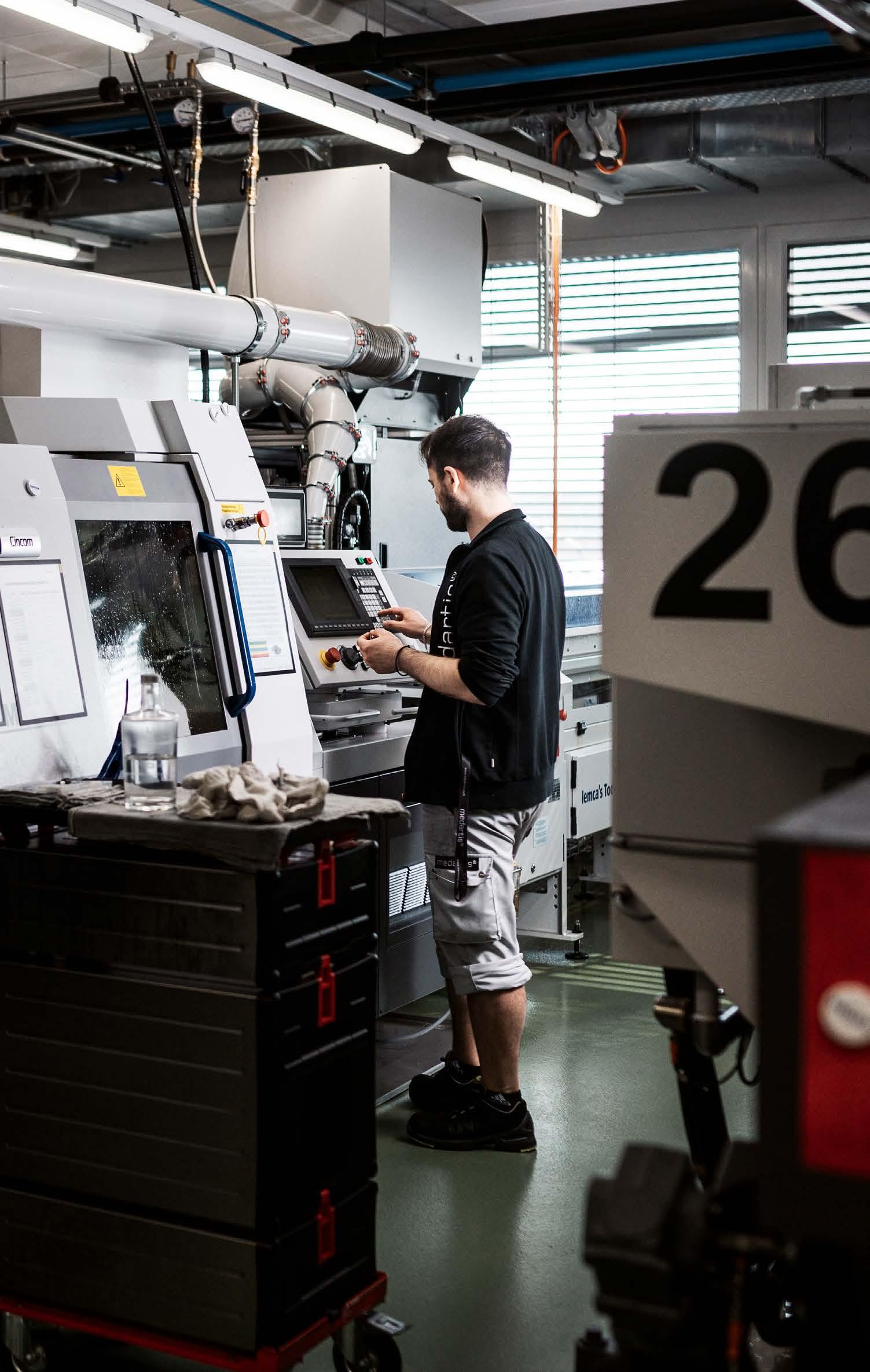
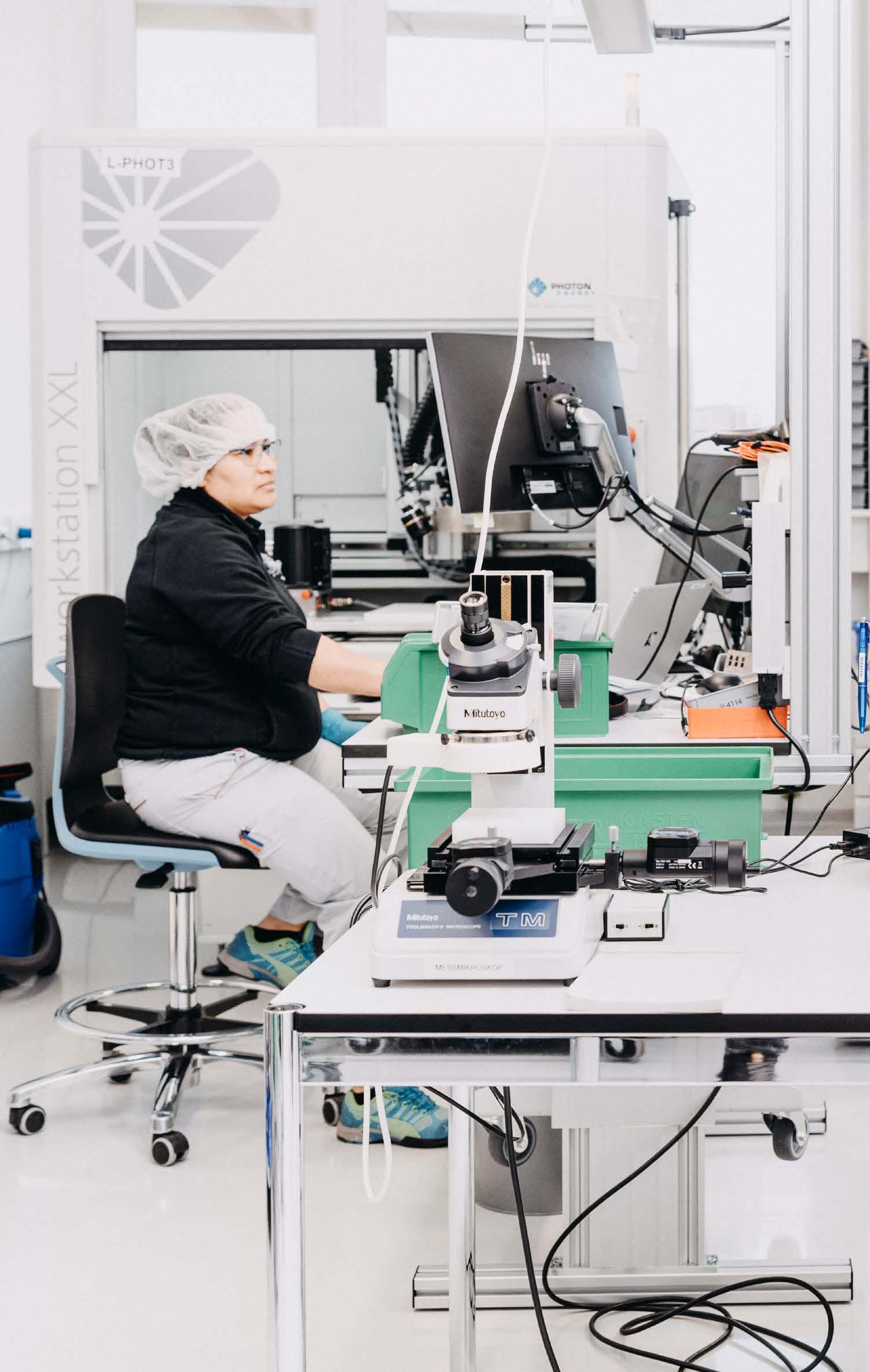
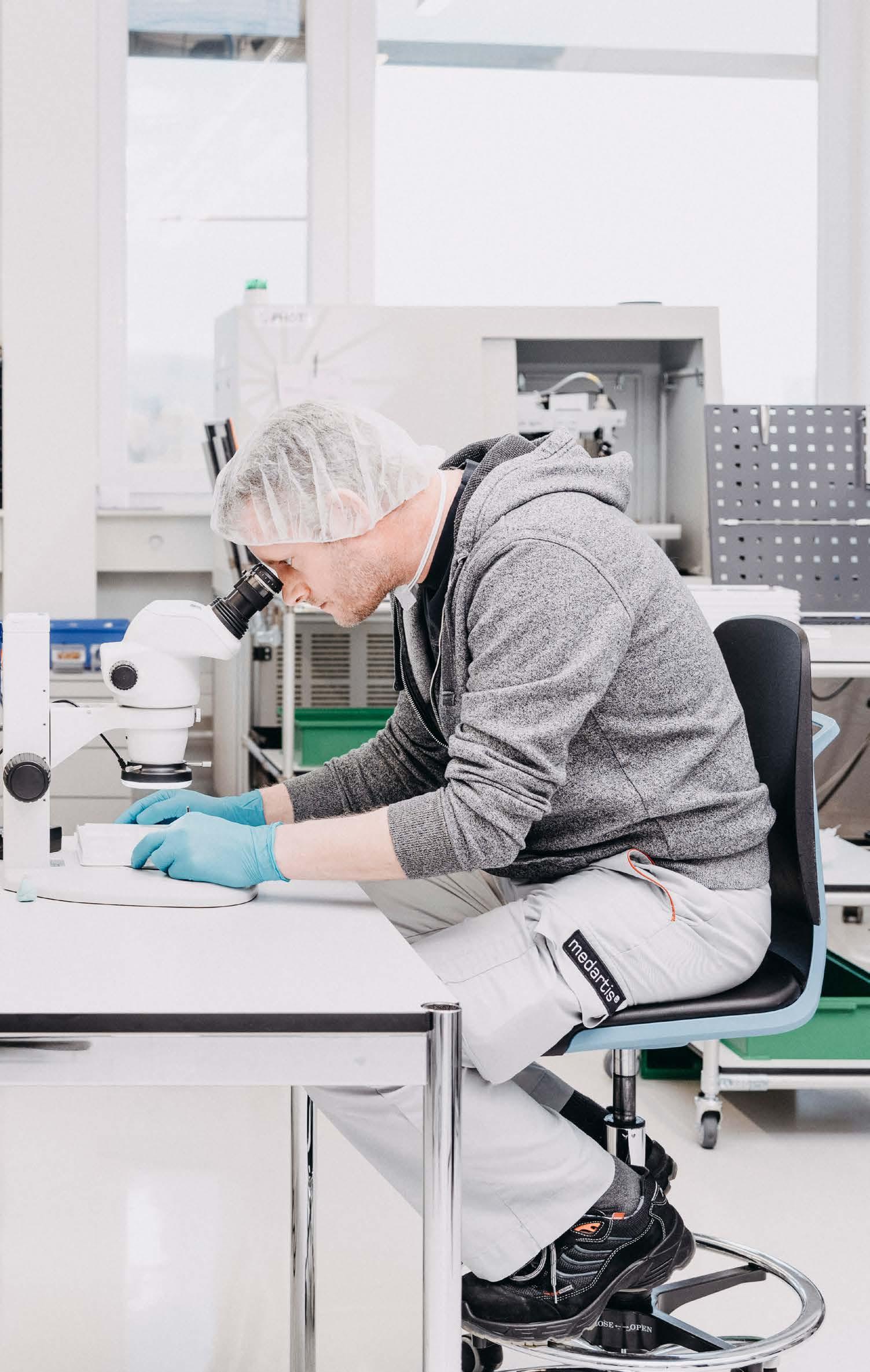
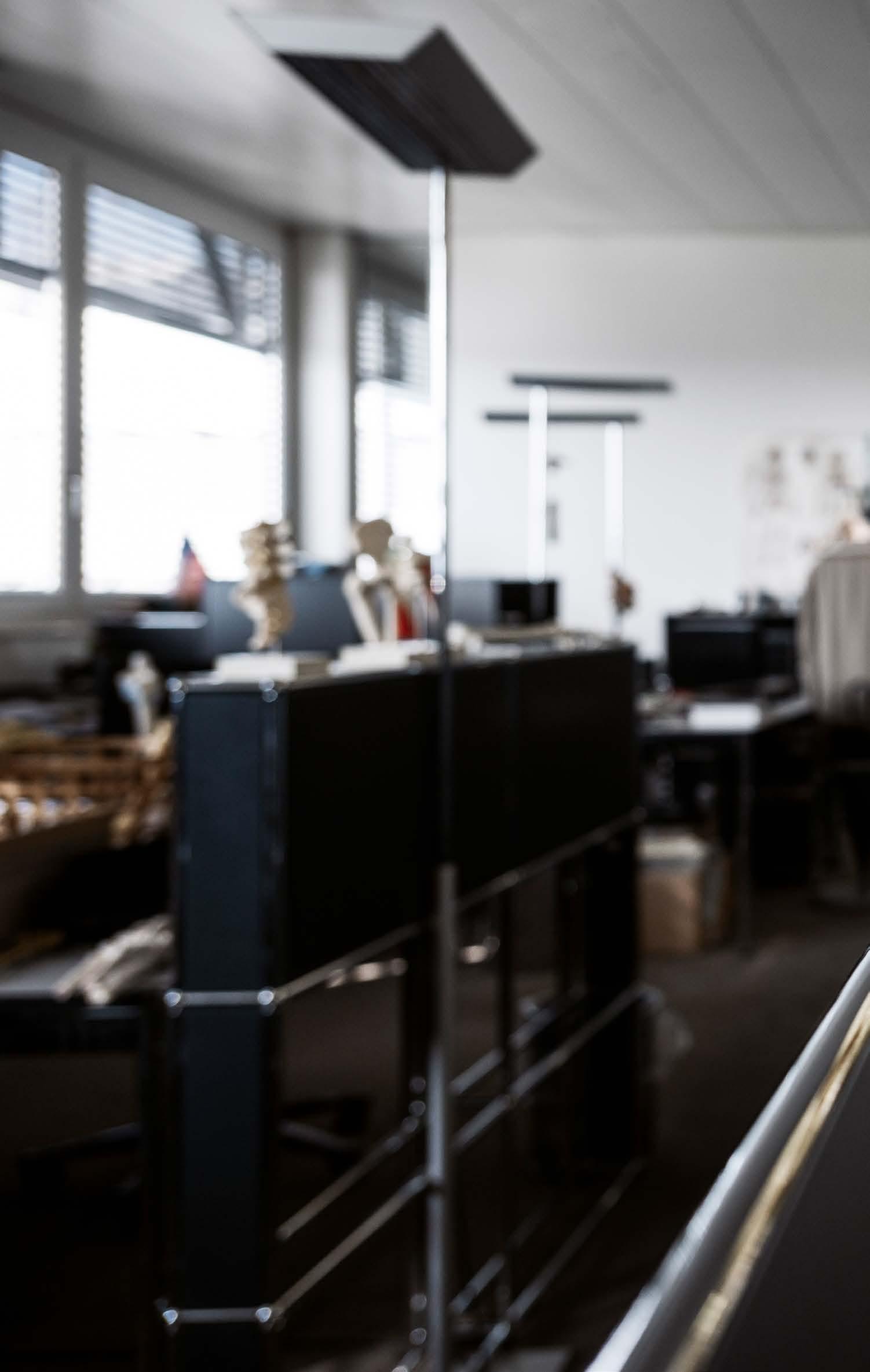
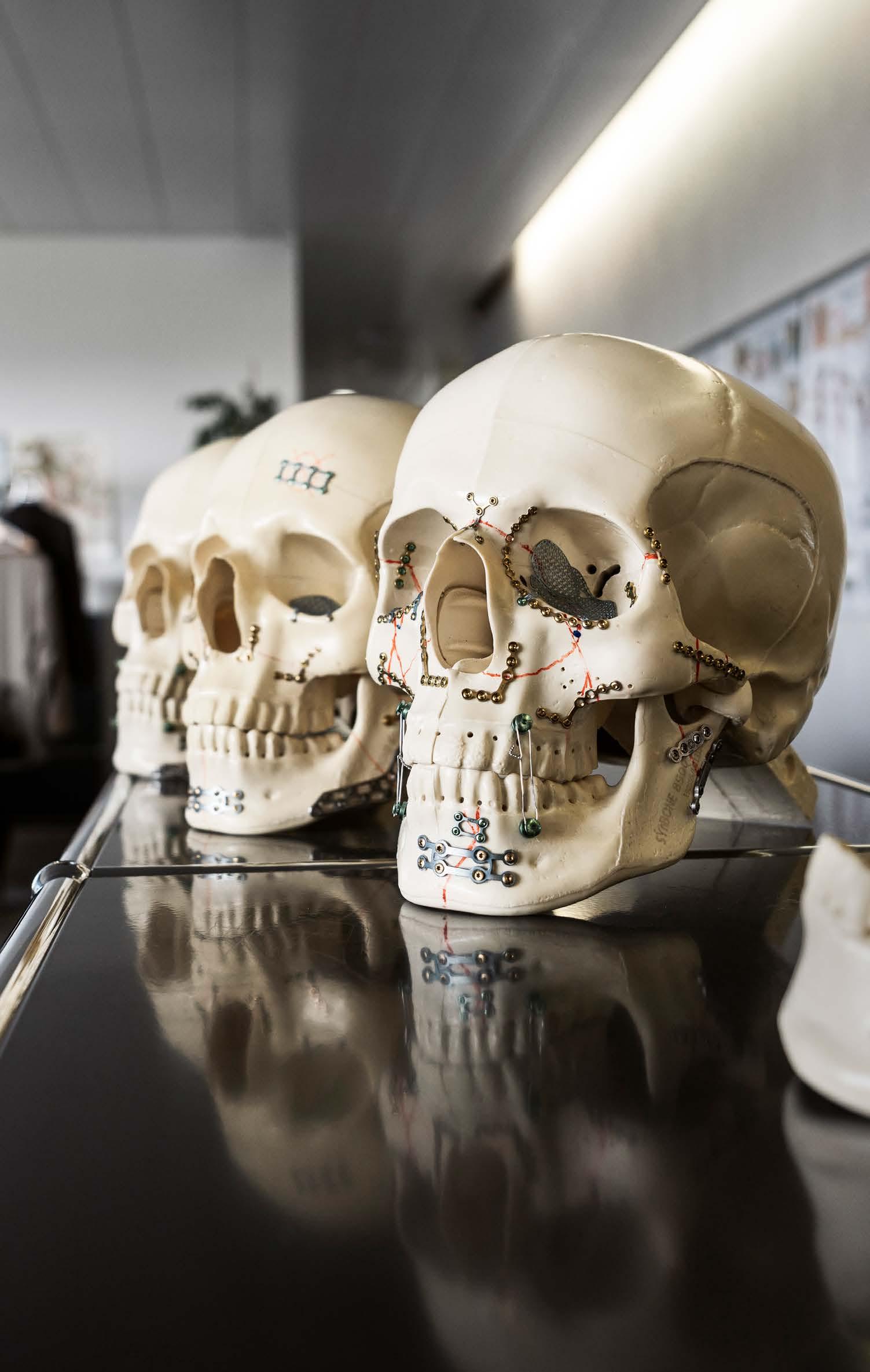
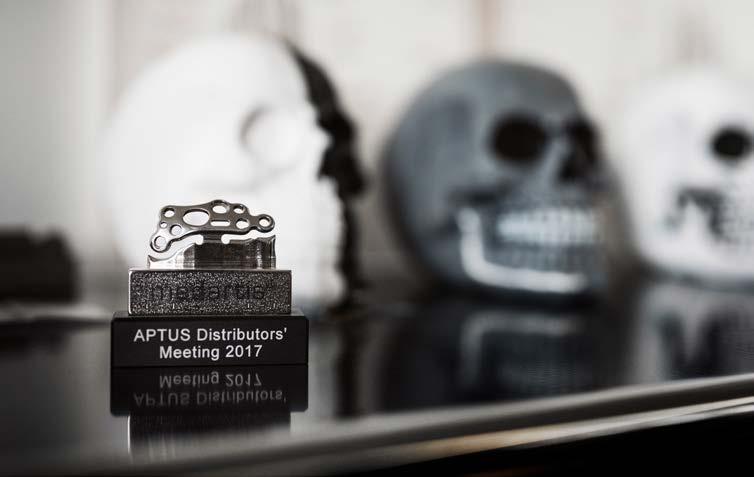
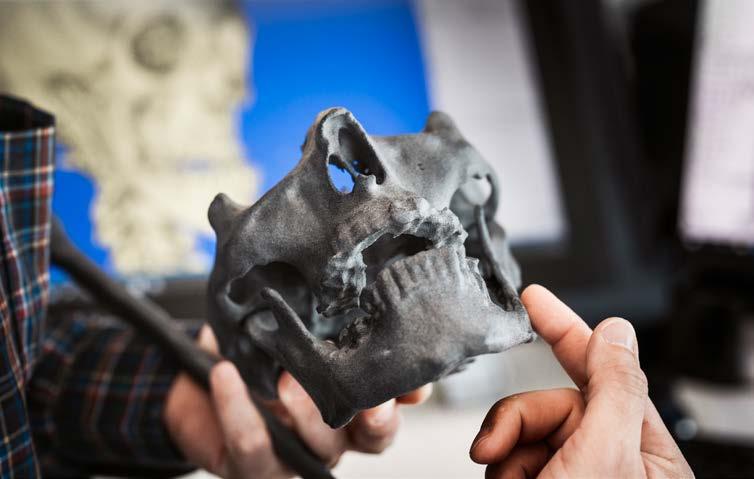
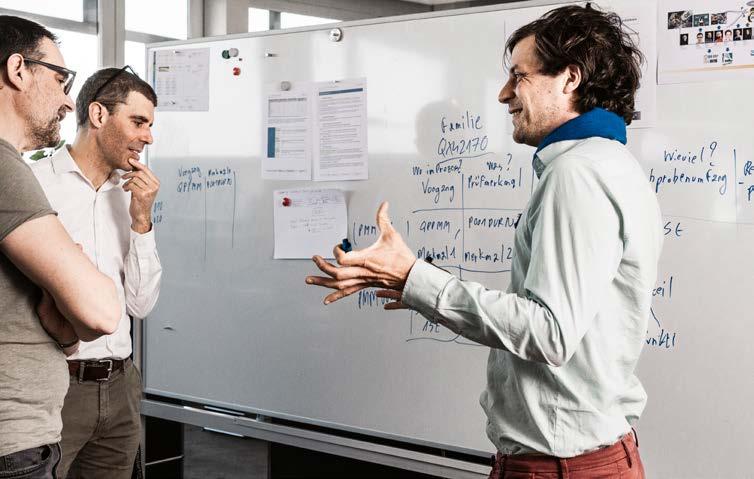
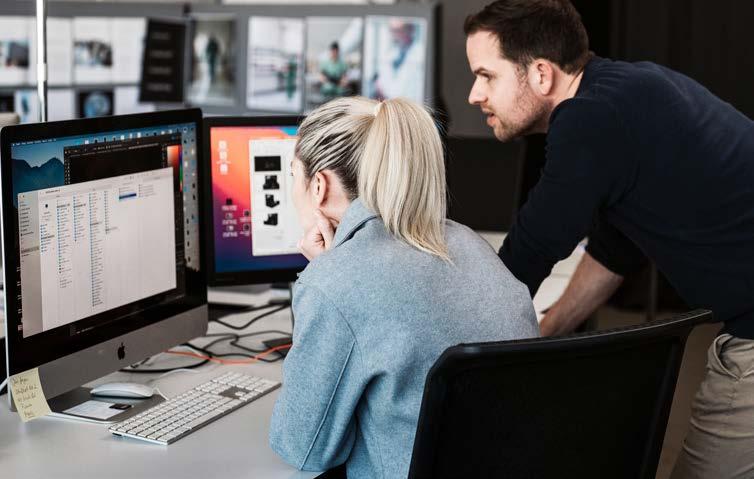
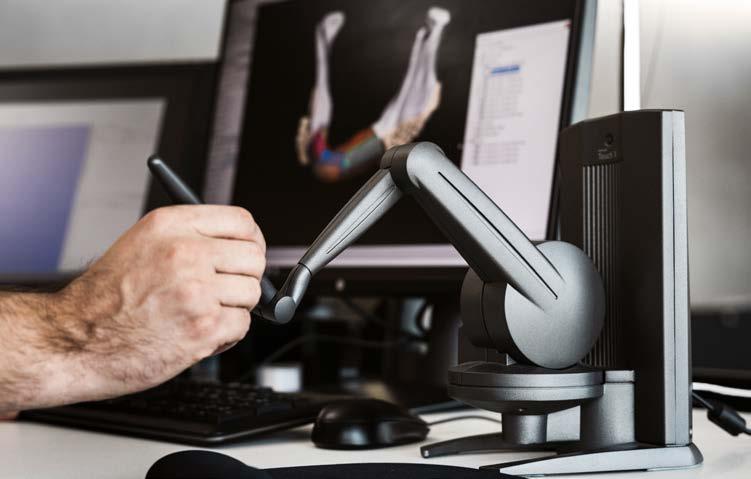
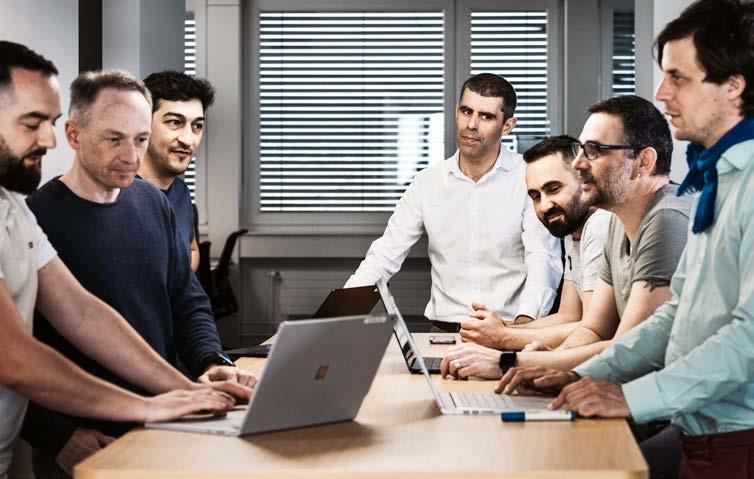
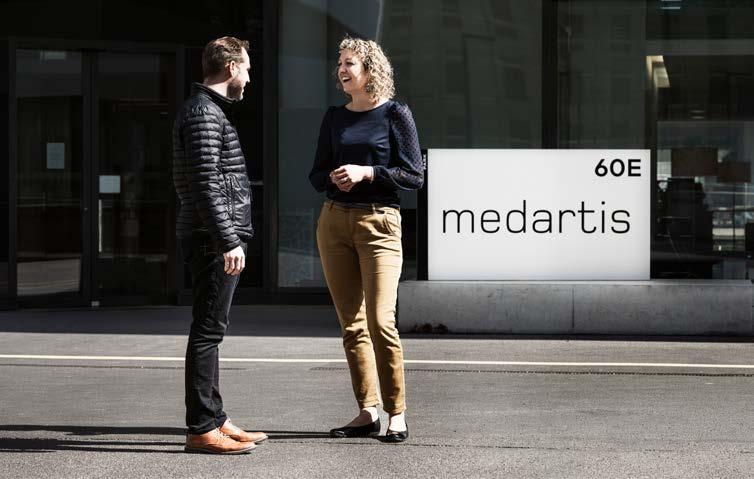
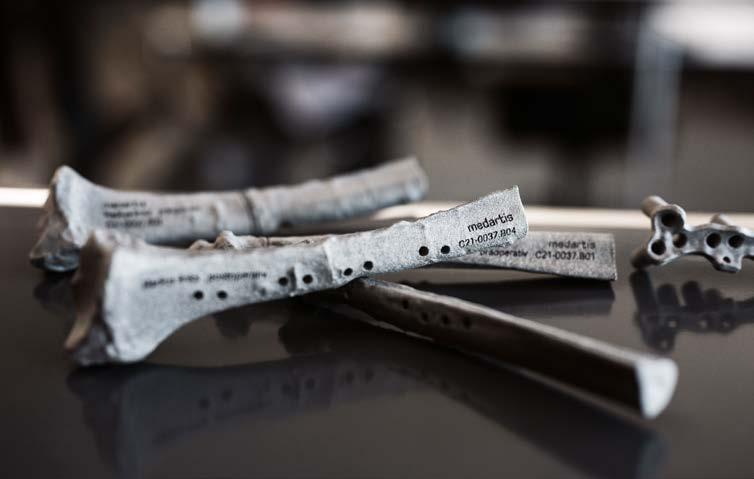
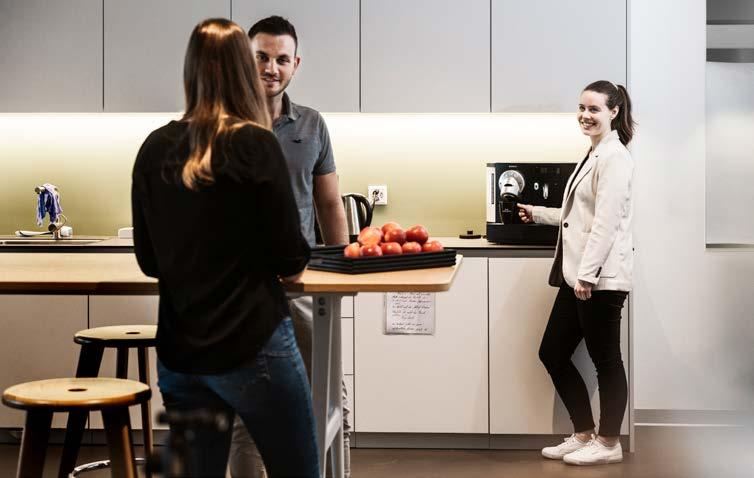
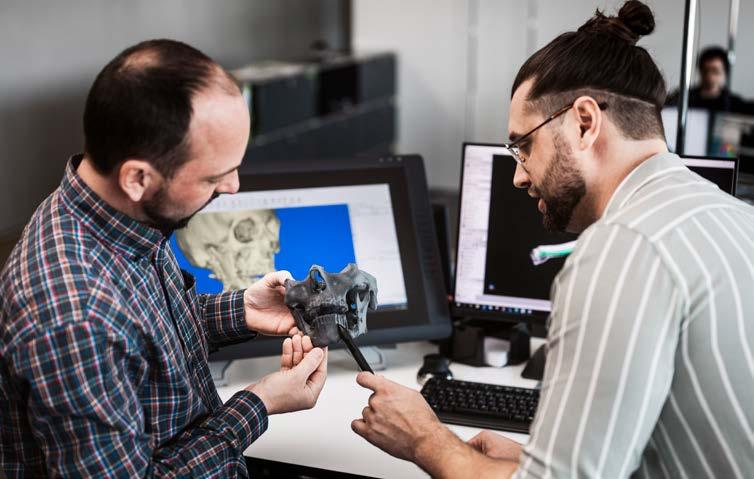
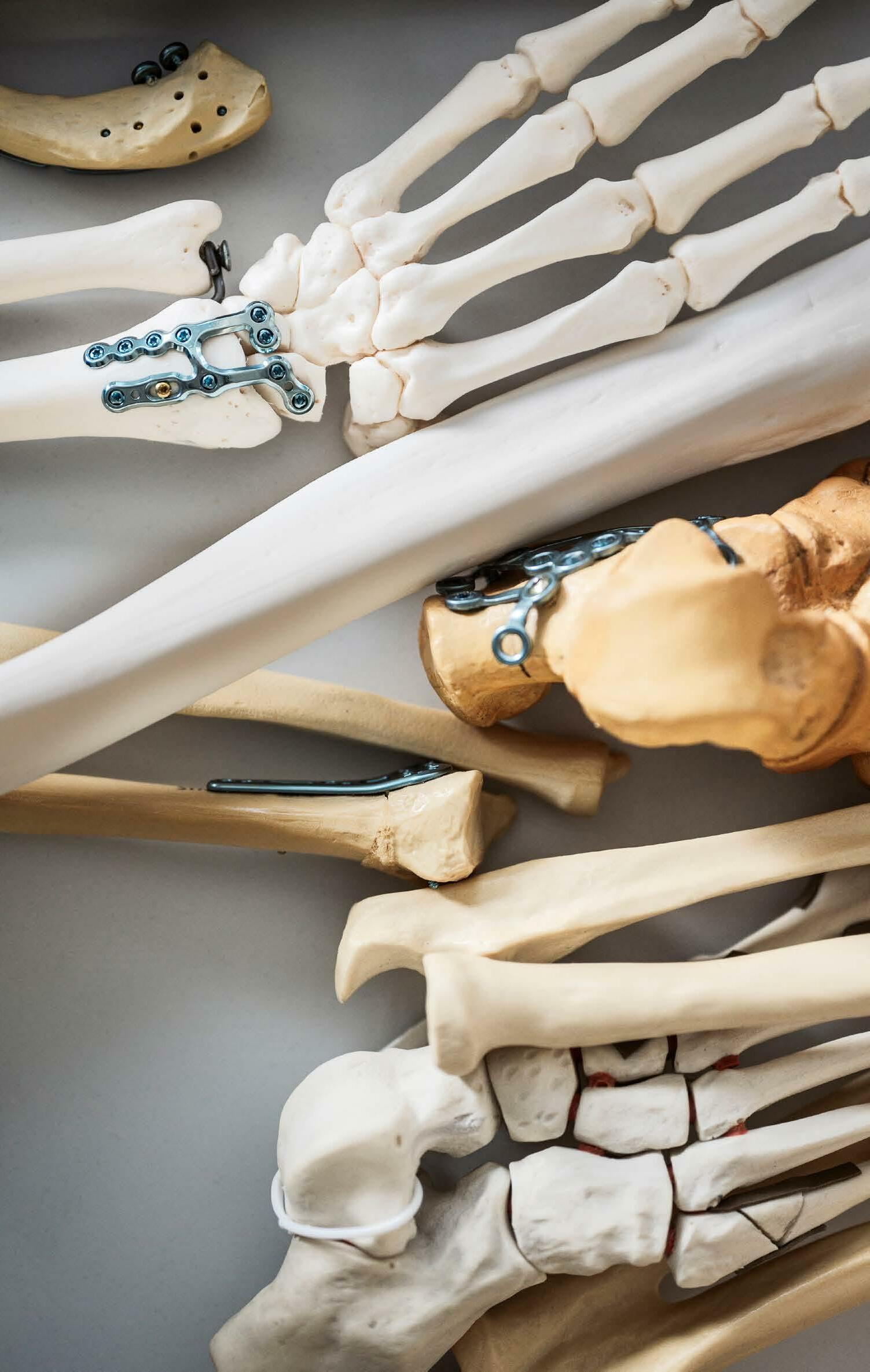
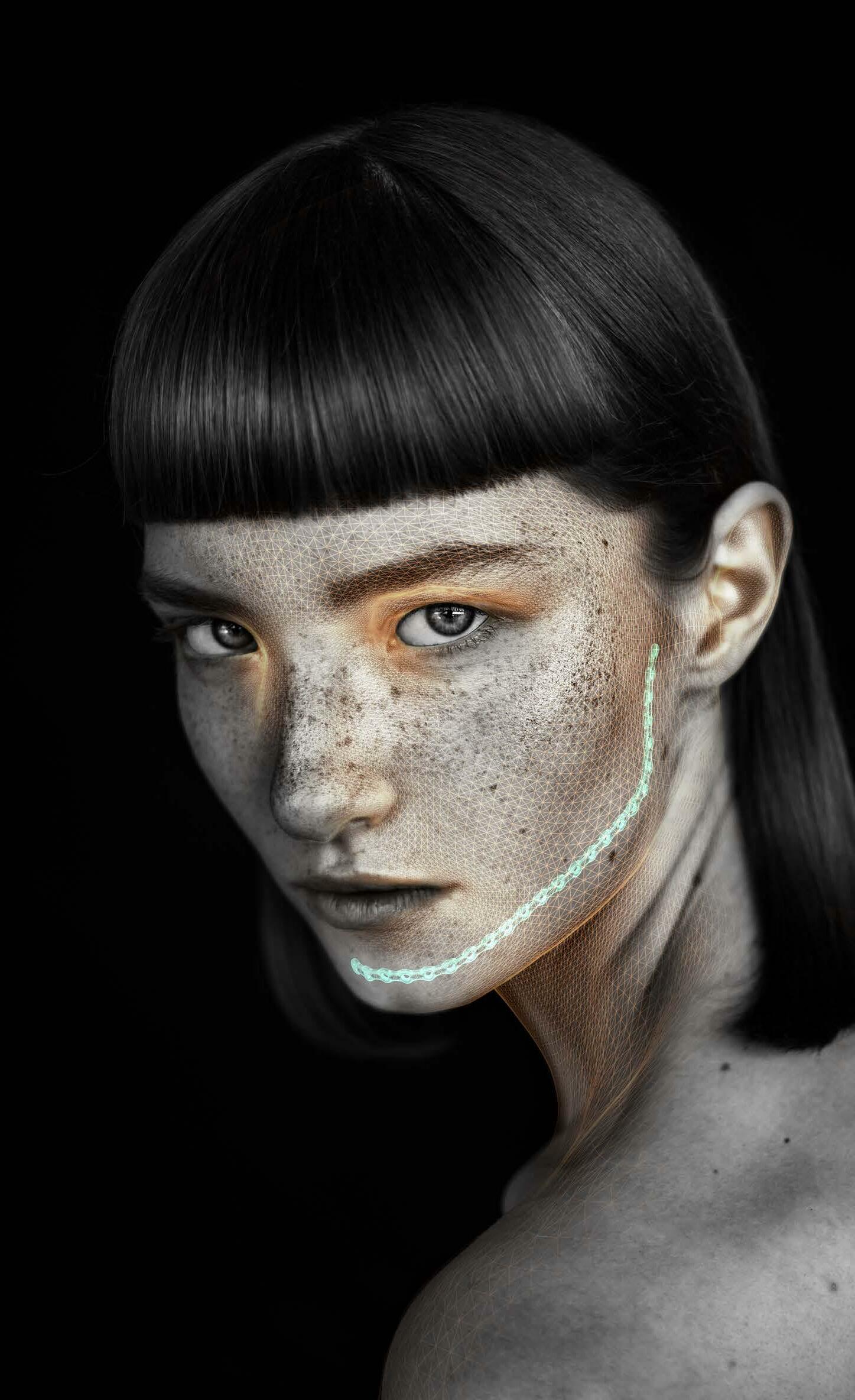
Headfirst — With its first product line MODUS, the young company Medartis wanted to gain a foothold in the highly challenging field of oral and maxillofacial surgery. The market was competitive and customers were hard to win over. But thanks to countless hours of teaching in operating theatres, clever ideas and the flexibility of a start-up, Medartis succeeded in establishing itself in the medical technology industry.
In the early summer of 1996, two aspiring young entrepreneurs from the Basel area met at the traditional coun try inn Bären in Langenbruck, where the Generals Wille and Guisan had stayed. One was 33-year-old Thomas Straumann. The other his mentor, Rudolf Maag, who was 17 years his senior.
The reason for the meeting: Straumann wanted to move into the field of osteosynthesis with his com pany, Straumann Holding AG, which specialised in dental implants. This was a delicate undertaking, because he had sold this very business area that he and his three sisters had owned to Rudolf Maag back in 1990. At the time, Straumann had agreed with Maag that they would not compete with each other in the future – a clause that Straumann would violate by re-entering the field of osteosynthesis. So he wanted to talk to Rudolf Maag, with whom he had been closely associated for years; on the one hand, because Maag had already worked under Fritz Straumann at the old Straumann Institute, and, on the other hand, because Maag was the uncle of Thomas Straumann’s wife.
Maag was not concerned. After all, Straumann was targeting a segment of the market that was not a core business of Maag’s Stratec Medical: oral, jaw and facial surgery, known in specialist circles as cranio-maxillo-facial surgery (CMF). For Straumann Holding AG, this niche was closely related to the dental implants, so the entrepreneurial step was obvious, even Maag thought so. But he couldn’t re sist taking a dig: “You’re going to need some luck,” he said, because he knew that a cut-throat battle was raging within the osteosynthesis industry, with major international companies such as Synthes,
Stryker and Zimmer Biomet competing against each other. In addition, surgeons, the most im portant customer group in the industry, were con sidered conservative and reluctant to change the implant systems to which they had become accus tomed. Many a newcomer on the business scene has had to find this out the hard way. Straumann could be next.
The re-entry of Thomas Straumann’s holding company into the field of osteosynthesis was therefore a highrisk venture. Others knew this too: He couldn’t get a penny’s worth of credit from the Basel Kantonalbank in Liestal. Moreover, Straumann Holding was planning an IPO, so in vestors and market analysts strongly advised against getting bogged down with an investment-intensive entry into a new field of business.
However, Thomas Straumann had every reason to trust his instinct for detecting lucrative niches in the market. After all, in the last six years he had estab lished a successful company from a small spin-off of the old Straumann Institute that would soon be valued at over a billion Swiss francs on the stock market. Nevertheless, Straumann knew one thing for sure: he couldn’t do this alone. He needed strong partners – and the very first thing he did was to get his best friend Willi Miesch on board.
At the beginning of November 1997, Thomas Straumann, Willi Miesch and Jürg Eichenberger, the investor, founded Medartis AG. Straumann became Chairman of the Board of Directors, Miesch the Managing Director, and Dominik Ellenrieder soon joined the company as an ex tremely well-connected board member and investor.
CMF surgery was not the largest business sector – that title went to the orthopaedic market with implants for the spine, knee and hip. But the niche was ideal for making a name for oneself. “CMF has always been the highest and most challenging of disciplines in surgery,” says Willi Miesch even today. Nowhere are the bones as delicate as in the face, nowhere are the results of surgical craftsmanship so obvious. Whoever practices here must be a per fectionist. And those who are able to supply and satisfy these perfectionists with products will later have a good chance of succeeding in other surgical fields as well.
MODUS is the name of the first product line that Medartis planned to launch on the market. It goes back to a develop ment by the Swedish med-tech group Elekta, from which Thomas Straumann had bought MODUS, including rights and patents, for 7.5 million Swiss francs. In addition to Willi Miesch, five German mechanical engineers and precision mechanics from Elekta in Umkirch near Freiburg were taken onboard to be responsible for devel oping MODUS further – including MODUS inventor Joachim Pfefferle, Hermann Zeuner and Peter Scheuble. Some of them already had several years of experience in the construction of titanium plates and screws for oral and maxillofacial surgery. After Elekta had invested too little in the development of MODUS, the mood was now one of optimism. “We suddenly had our hands full,” recalls Hermann Zeuner.
MODUS, a modular, colour-coded complete system for implants in the CMF industry, was available at this time in four versions: red sets (screw diameter 0.9mm-1.2mm) with the world’s smallest titanium screw for the skull and face, green sets (1.5mm1.8mm) for the midface, blue sets (2.0mm-2.3mm)
for the jaw, and yellow mesh sets, into which all screws from 0.9mm to 2.3mm can be fixed. The pre cision-mechanical production was to be carried out initially by subcontractors mostly in Switzerland.
In the course of the first few years, the systems MODE OSS 2.0, Trauma 2.0 with semi-rigid plates, Trauma 2.5 and Reco 2.5 were added. With the man dibular reconstruction plate Reco 2.5, the start-up developed a technology for the first time in which the screws could be locked in the screw head for the greatest possible stability. It could also hold the damaged bone parts together by means of inter fragmentary compression. The design of the plate bars (bionics), copied from nature, reduces the risk of fractures when under stress, and the plate is curved instead of straight. This means that the surgeon has to bend the implant only slightly in the operating theatre, and Medartis also offered suita ble bending and cutting forceps for this technique.
Medartis became a pioneer with the Reco plate in the then newly developed locking technology and thus became a noticeable player in the market.
The birthplace of these inventions was Umkirch, where Medartis AG had set up its development department and prototype workshop at the old El ekta site. Joachim Pfefferle managed the business in Umkirch, while the headquarters were set up at 22 Steinengraben in Basel. However, Willi Miesch, the Managing Director, was hardly ever there. On the 70-kilometre stretch of the A5 between Basel and Umkirch the passionate mechanic soon got to know every crash barrier, that’s how often he was visiting the prototype workshop. Even more fre quent were his trips across Switzerland and the neighbouring countries, through which he drove his LandRover tirelessly to present MODUS to leading oral surgeons. The potential clientele was interna tional right from the start, because there were very few oral surgery researchers in Switzerland. Univer sity hospitals in Germany, Austria and France were thus becoming more relevant customers.
In the early years Medartis relied on its “big sis ter”, Straumann Holding AG, for distribution. Thus, Medartis’s first customers were usually already Straumann customers – for example, the maxillo facial surgery department of the Münster University Hospital headed by Prof. Dr. Dr. h.c. Ulrich Joos. He was Medartis’s ideal partner, as he was a distin guished expert in the treatment of cleft lip, jaw and palate, craniofacial malformations (skull and face) and dysgnathic surgery (malocclusion). He was “the most innovative oral surgeon of his time”, Willi Miesch recalls.
Professor Joos was an advocate of the French school of oral surgery and
according to this philosophy, osteosyn thesis is not just about rigidly screwing two bones together but rather the selfhealing power of the body should be considered. This philosophy was en tirely in line with Medartis’s approach of using semi-rigid implants to give the bone and tissue room to heal.
But their agreement extended beyond medical the ory. They also harmonised in practice. And that was mainly due to the hands-on approach that was cultivated at Medartis. Willi Miesch and Joachim Pfefferle spent hours with the operating theatre staff and the surgeons in various operating theatres to gain a better understanding of the needs of the customers who were on the front line. Later on, in Umkirch, Pfefferle would then sketch new implants according to the physician’s specifications, which the team turned into a prototype within weeks and then sent to the clinics for evaluation.
The approachable nature of the staff, the high qual ity and precision of the implants, the intuitive han dling of the colour-coded MODUS systems – were some of the many reasons for Medartis’s rapid suc cess. The first hurdle had been overcome, the entry into the market was successful.
The year 2001 began with a move involving the employees of Medartis. A former printing shop at 24 Austrasse, in the heart of Basel, offered enough space for everyone on three floors: the manage ment, the administration, the development de partment with the prototype workshop; and even a training room was set up. Strictly speaking, it had too much space. “How are we ever going to fill this huge building?” asked engineer Zeuner as he took his seat at his new desk for the first time in the spa cious, sparsely furnished development department and looked around. He pushed the table against the wall, but now the room seemed even bigger to him. So it went back to the centre. Some new employees would come in handy. He didn’t have to wait long.
Concentrating on one location had logistical advantages. But above all, it accelerated an important success factor: the development of a corporate culture and a team spirit. Boss Miesch used to cheer with the team when a big order rolled in. He would help with the packing of boxes when a delivery had to go out particularly quickly. And then there were the many rounds of drinks after work. Or, if the work took longer, the Klingental restaurant conveniently
served dinner even at 11 pm. And not just any dinner at that, but Cordon Bleu with French Fries!
As promising as all this was, there were also prob lems. One problem was the distribution, which was still handled by Straumann Holding AG and did not work out as Medartis would have liked. The reason was that Straumann’s sales representatives could sell their established dental implants easier than the plates and screws of the still largely unknown start-up Medartis. In addition, Medartis and Strau mann were dealing with a similar group of custom ers, but not the same ones. “A dentist is not an oral surgeon,” said Willi Miesch, describing the dilemma.
In 2002, Medartis decided to build up its own sales organisation and to find subsidiaries abroad for this purpose. Medartis reactivated its GmbH in Umkirch, Germany, as a sales company, followed by branch es in Vienna and Lyon, in Batley, England, and in Philadelphia. From here, the new employees set out to inspire clinics and surgeons with enthusiasm for Medartis and MODUS.
Thanks to the company’s own sales organisation, new customers could be serviced far more effi ciently than having to divert via Straumann Holding AG’s sales department. For surgeons, this meant that they could count on fast deliveries of plates and screws, and not only if Willi Miesch or Joachim Pfefferle attended to them personally.
Now the training room in the basement on Austrasse became really useful. Here, under the supervision of Prof. Dr. Wilfried Schilli, the oral surgeon from Freiburg – who, by the way, was also a fan of the Cordon Bleus in the Klingental – the field teams practised the handling of plates, screws and plastic bones. They ac quired the necessary know-how and were thus well equipped to talk to the surgeons on their level.
Professor Schilli’s example shows that Medartis and science have a symbiotic relationship, for which Thomas Straumann, Chairman of the Board of Directors, could also be thanked. His father, Fritz Straumann, had made it his business to enable in dustry and science to benefit from each other, and in 1980 he co-founded the International Team for Implantology (ITI), which has since promoted re search and scientific exchange in dental implantol ogy. Founding member and second president of the ITI: Prof. Dr Wilfried Schilli.
Following the same tradition, Thomas Straumann was present on 25 Septem ber 2004 when the International Bone Research Association (IBRA) was founded in Zurich – an association of surgeons whose exchanges contribute to the advancement of osteosynthesis as a research field. It was important to him that Medartis established itself as a science-based company, even if others saw it as an unnecessary cost factor. Straumann’s intuition was dead right once again: IBRA became one of Medartis’s most important develop ment partners.
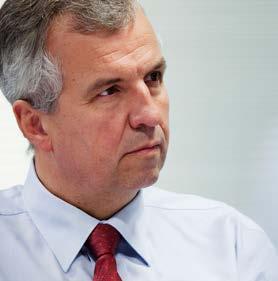
At this point, the board of directors had been dis cussing how the start-up could expand its portfo lio. The next largest implants after the fine MODUS products were used in hand and wrist surgery. Me dartis made its move as this opened up new dimen sions in marketing. Almost every hospital with a surgical department has a hand surgery unit. Distal radius fractures, i.e. the bone fractures of the radi us near the wrist, is one of the most common frac tures.
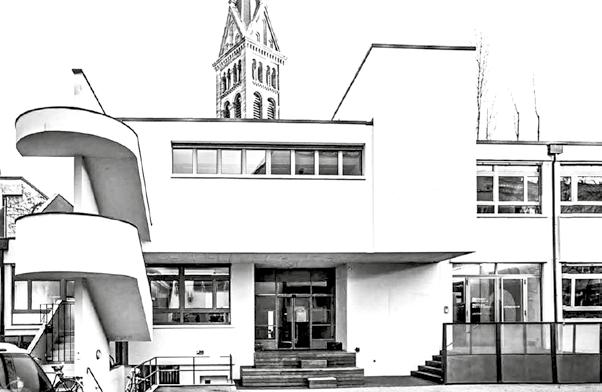
Hermann Zeuner had to move his desk back against the wall to make room for the new employees. The offices on Austrasse were filling up quickly – the number of employees had more than doubled since he first moved in, and soon the offices and workshop would be bursting at the seams. Zeuner and his colleagues Pfefferle, Scheuble, Walter and Thiel were themselves contributing to this. They were tink ering with an invention that would finally help Medartis achieve its break through.
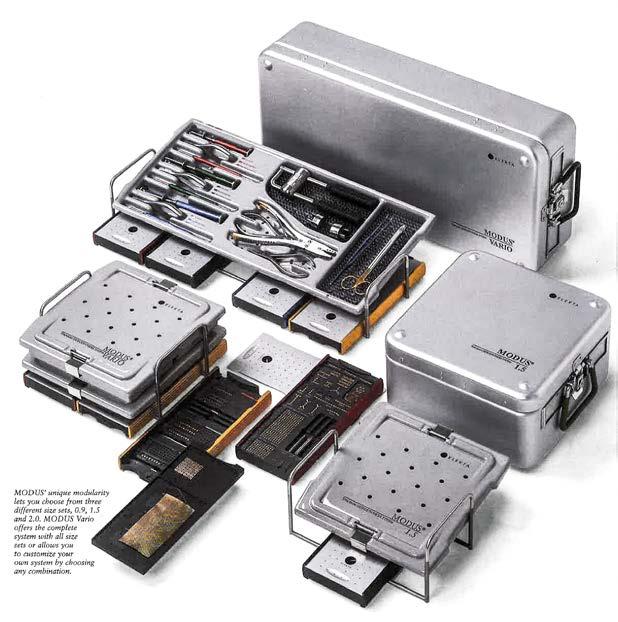

Thomas Straumann bought the Swedish med-tech group Elekta’s modular, colour-coded complete system for osteosynthesis in the field of maxillofacial surgery.
Dr Jürg Greuter has been with Medartis from the beginning – as a member and secretary of the Board of Directors. Throughout the years, the lawyer has provided legal advice to the company.
The first Medartis team at a Christmas party in Freiburg, photographed by Willi Miesch (from left to right): Hermann Zeuner, Tilmann Hartlieb, Michael Roth, Christine Schwaderer, Christine Hasler, Peter Scheuble, Joachim Pfefferle.
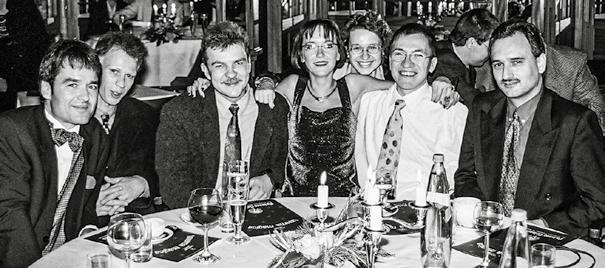
In a former printing shop at 24 Austrasse, in the heart of Basel, all Medartis employees come together for the first time under one roof.
Medartis presents its MODUS product range at an MKG congress in Münster. And proves that it has good taste in art. It is not without reason that “Medartis” is a neologism made up of “medicine” and “art”.
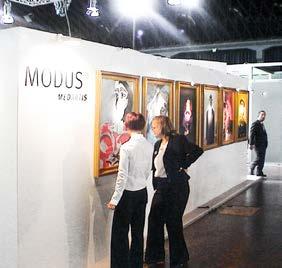
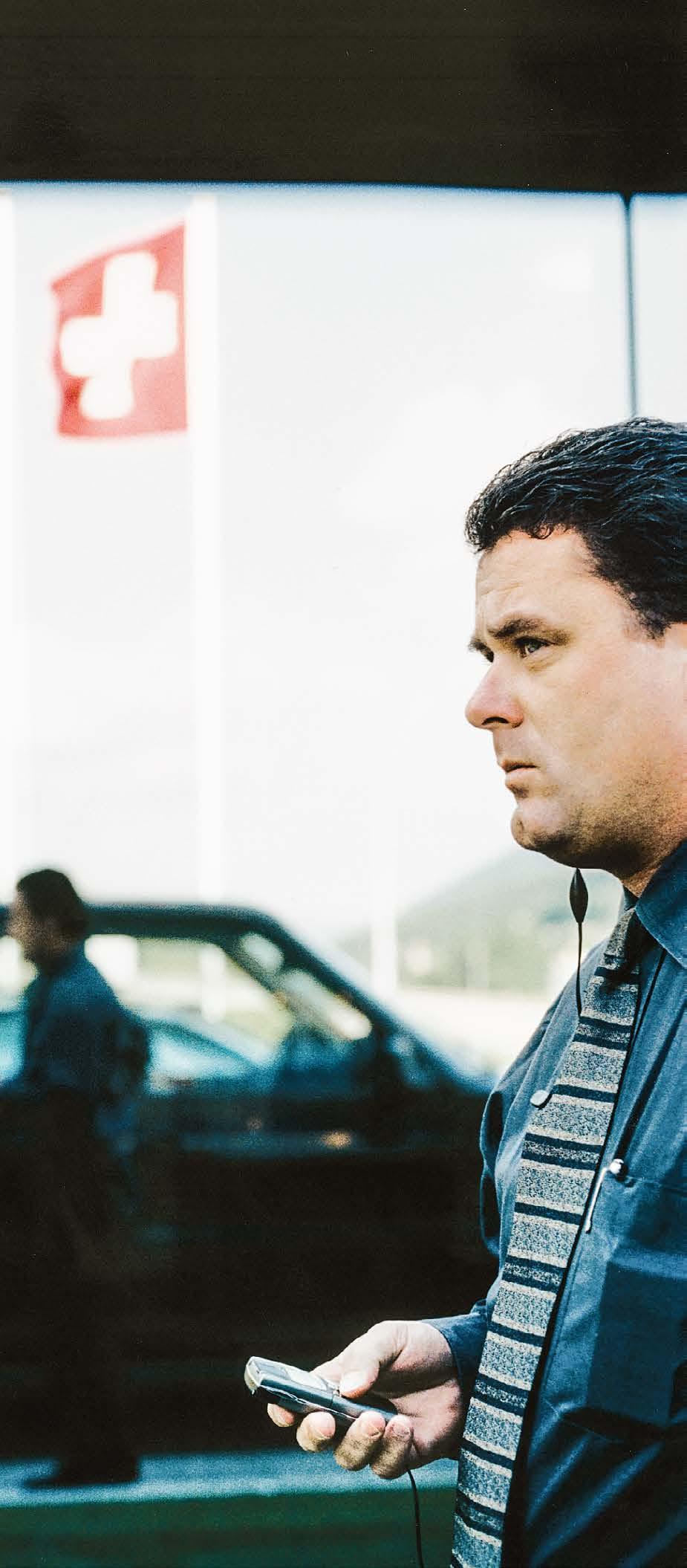
Thomas Strau mann, Chairman of the Board of Directors, is also constantly on the move. He commutes between his home in Gstaad and his companies, Straumann Holding AG in Waldenburg and Medartis AG in Basel. He is also passionately committed to ena bling cooperation between science and industry, especially as a member of the International Team for Implan tology (ITI) and the International Bone Research Association (IBRA), which he co-founded in 2004. In 2004, the Faculty of Medicine of the University of Basel awarded him an honorary doctorate.
Ti22 – titanium is the be all and end all of medical technology. Nothing works without it. The naturally occurring metal is light, extremely strong and corrosion-resistant. Moreover, hardly anyone is allergic to it. Medartis uses titanium alloys of varying degrees of hardness for its screws and plates – the purer it is, the softer the metal.
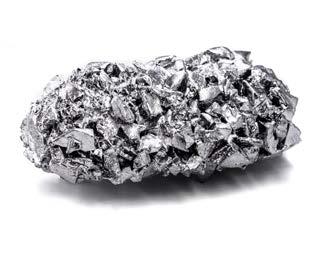
Always on par (from left to right): Willi Miesch, Prof. Dr. Dr. h.c. Ulrich Joos (Münster), Prof. Dr. Edward Ellis (San Antonio, Texas) and Prof. Dr. Joël Ferri (Lille) at a forum on orthognath ic surgery in Gstaad.
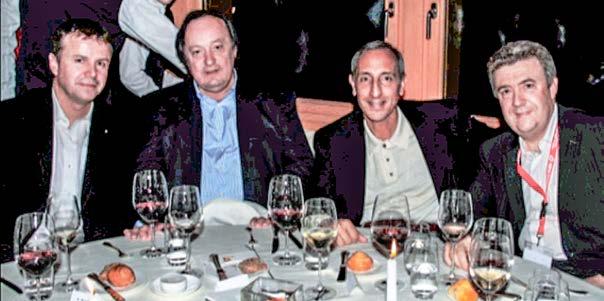
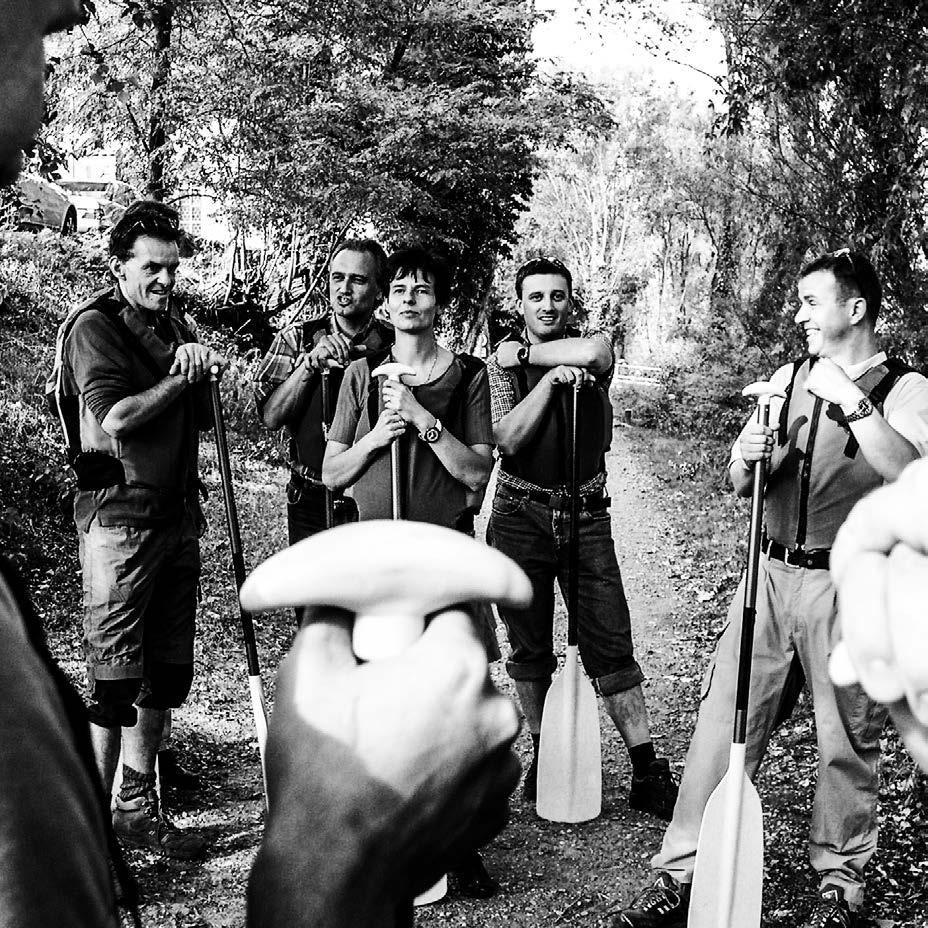
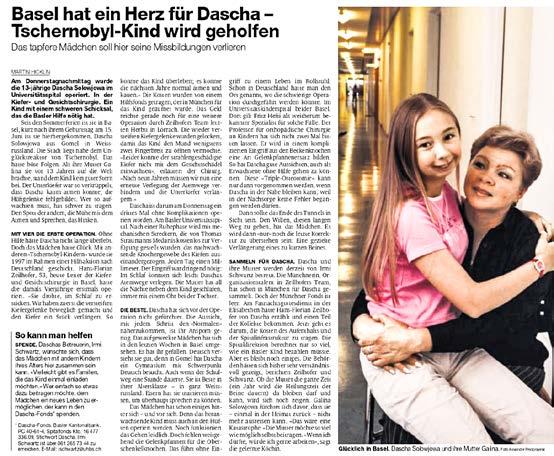
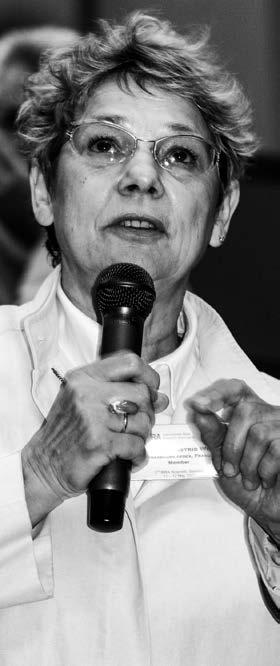
During the legendary summer excursions, Willi Miesch (right) would also challenge his team in sporting activities – whether on a bicycle, a scooter or in a canoe on the Rhine.
The renowned surgeon Prof. Dr. Astrid Wilk from Strasbourg was one of Medartis’s first custom ers in the field of oral surgery. Appreciating the quality of Medartis products, Dr. Wilk dedi cated her experience and professional know-how to the service of the company in order to drive the development of the MODUS range.
The CMF products by Medartis change lives – such as that of 13-year-old Dascha from Gomel in Belarus. Dascha is a victim of the Chernobyl nuclear disaster. Her lower jaw was so deformed at birth that she could hardly breathe. She underwent several operations at the University Hospital in Basel. Mechanical distractors were used, which Medartis provided free of charge.
I was the first employee at Medartis. Before me, there was only one other employee, and that was the Man aging Director Willi Miesch. After having worked for several years in marketing and sales for interna tional pharmaceutical companies, I applied for a job at the end of 1997 as an assistant to the management of a start-up company. I had never heard of the company name Medar tis. At the first job interview Willi Miesch pointed out to me bluntly: “With us you’re not just going to have things handed over to you.” But that was actually already clear to me, since Medartis didn’t even have an office at that time. It was obvious that I was at the beginning of history in the making here. So I replied, “That’s exactly why I’m here: I want to help build up something!”
On my first day of work on 1 March 1998, we had an office on Steinen torstrasse, and it was huge! There were hardly any employees and not much else either. So one of my first tasks was to organise coffee sets and paper for the printer. At the same time, we started marketing the MODUS product line – supported by the Straumann company. Every working day was different. I kept Willi Miesch’s over-filled diary, took the minutes at meetings and then, of course, as a cutting-edge startup, Medartis needed its own website, which was still a big deal back then.
So one morning a “web designer” came to us in the posh Steinentor strasse; our neighbours were asset managers and banks. I could hear in the receptionist’s voice that some thing was not quite right. “There is a mister … ahm …. I don’t quite know….”. So I went downstairs and couldn’t believe my eyes. There was this guy with huge dreadlocks, down to his hips, wearing a yellow linen shirt and pink over-baggy trousers! Oops, I thought, what will my boss think? But he couldn’t care less. “If his results are good, that’s all that counts”. The web designer got the job and our first website turned out really cool.
Christine Hasler (58) is Market Support & Documentation Manager at Medartis and she was the company’s first employee. As a child, Christine wanted to be come a flight attendant. Those career plans had failed by a very slight margin – fortunately for Medartis.
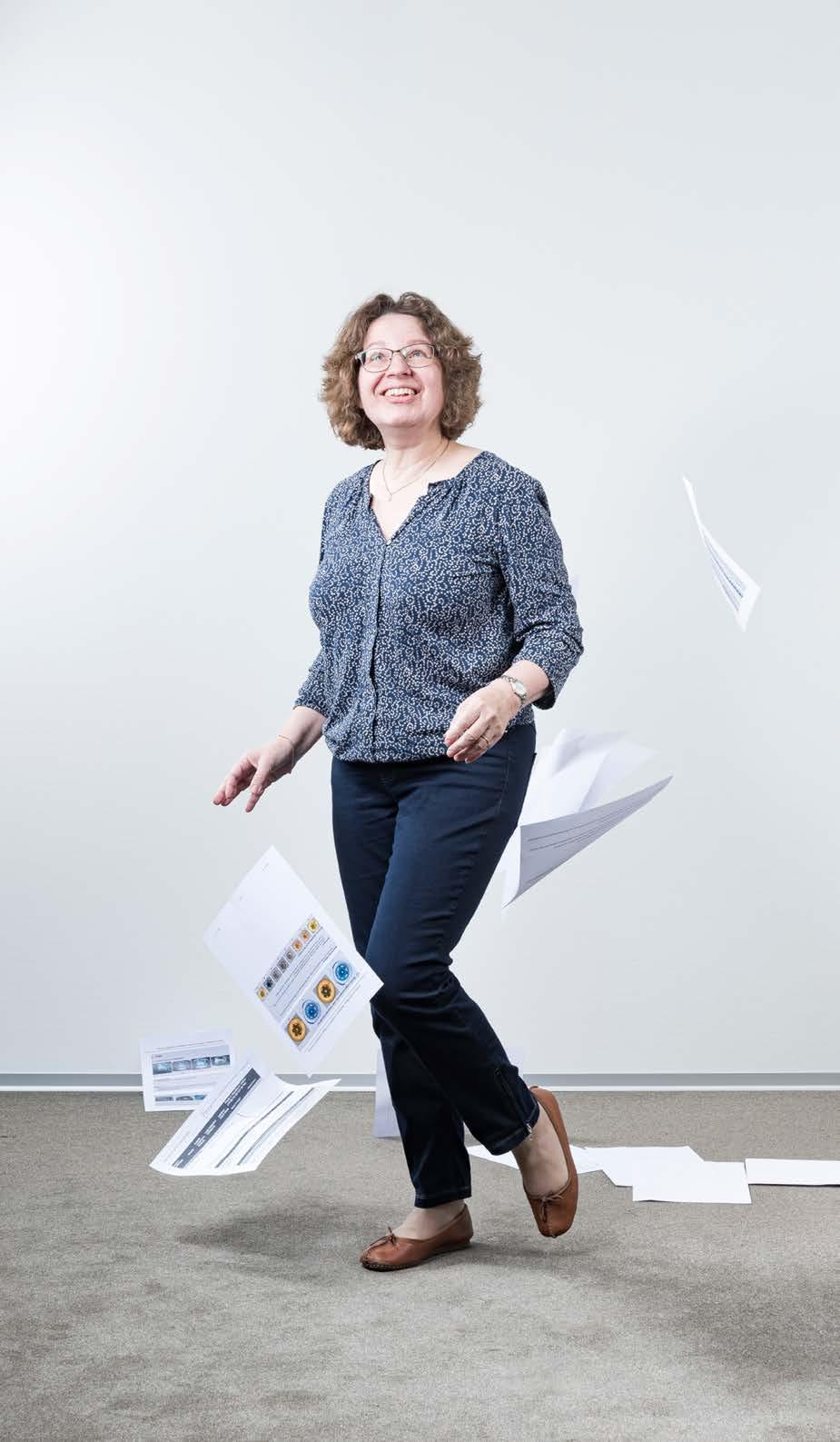
When I was a boy, I used to go out into the garden and stare up into the sky. We lived in Lustenau, Austria, not far from the runway of the small Hohenems airfield. I so wanted to become a pilot, but we didn’t have the money for that. After business school I worked as a customs officer and later for a large tax consultancy in Salzburg. That’s when I discov ered my talent in distribution and sales.
In 1988, I joined a company that traded in medical products and worked my way up to distribution coordinator – until the summer of 2000, when an old friend asked me if I wanted to join a Swiss company called Medartis. I liked the product, MODUS, and the people behind it. Moreover, I could build up some thing new here, because Austria had been uncharted territory for Medartis until then. On 1 January 2001, I started my career at Medartis, or rather at Straumann initially, because at that time the distribution was still run by Strau mann. However, the “Straumanns” neglected MODUS a bit because it was easier for them to sell the trendy dental root implants by Straumann than the complex CMF products by an unknown company. That was exactly the reason why I had to now concentrate fully on MODUS. And lo and behold: at last something was brewing in Austria. Then came the shock. I was on my way to a Linz hospital with Joachim Pfefferle, the brilliant head of de velopment, to present MODUS to them. Joachim’s mobile phone rang.
He picked up and became paler and paler by the minute. After the short call, I asked, “What's going on?” He explained that Straumann would stop distributing Medartis in Austria at the end of 2001 – five months from now. I was irritated, because I had given up a secure and well-paid job for Medartis. And now it was going to be over after just 6 months? I called Willi Miesch. “You can’t do that!” I shouted. He reassured me that I would simply be connected to the Medartis distribution depart ment in Germany. “No way!”, I said. “I’m not having foreign slave-mas ters over me!” “Ok, so what do you want then?” asked Willi. After a pause he said, “No way, you are not thinking about setting up your own subsidiary, are you?” – “Yes!” I re plied, “that’s exactly what I want!”
Three weeks later I met Willi in a conference room of a hotel on Lake Constance. The place had a view of the water and served great food. My twelve-page flip-chart pres entation of sales forecasts, cost estimates and growth strategies obviously impressed Willi. Four months later, on 1 January 2002, we founded the first independent international distribution company, Medartis GmbH Austria. I was the managing director, and the only employee as a sales representative.
At the age of 50 I also became a pilot but only as a hobby.
2002
“Are you talking about setting up your own subsidiary?”
Thomas Alge
Thomas Alge (61) is not an art dealer, even though Medartis used to advertise its MODUS products using the works of famous artists – as a sign of the artistry (Latin: Ars, artis) of Medartis products. Today, Thomas Alge is Managing Direc tor of Medartis Austria and Switzerland. The father of five children, he still lives with his wife in the house in Lustenau that they had built together at the age of 22 from his first earnings.
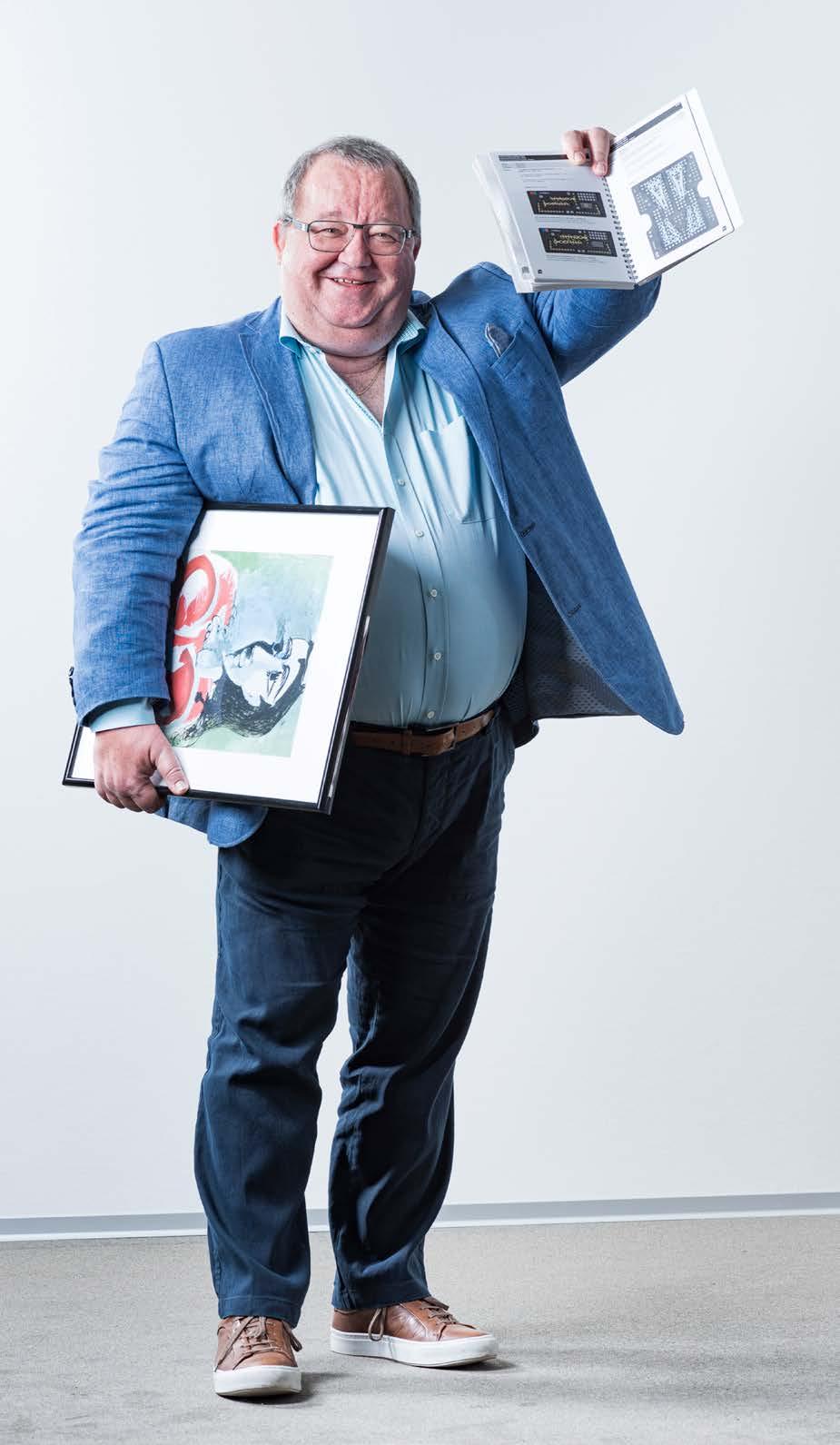
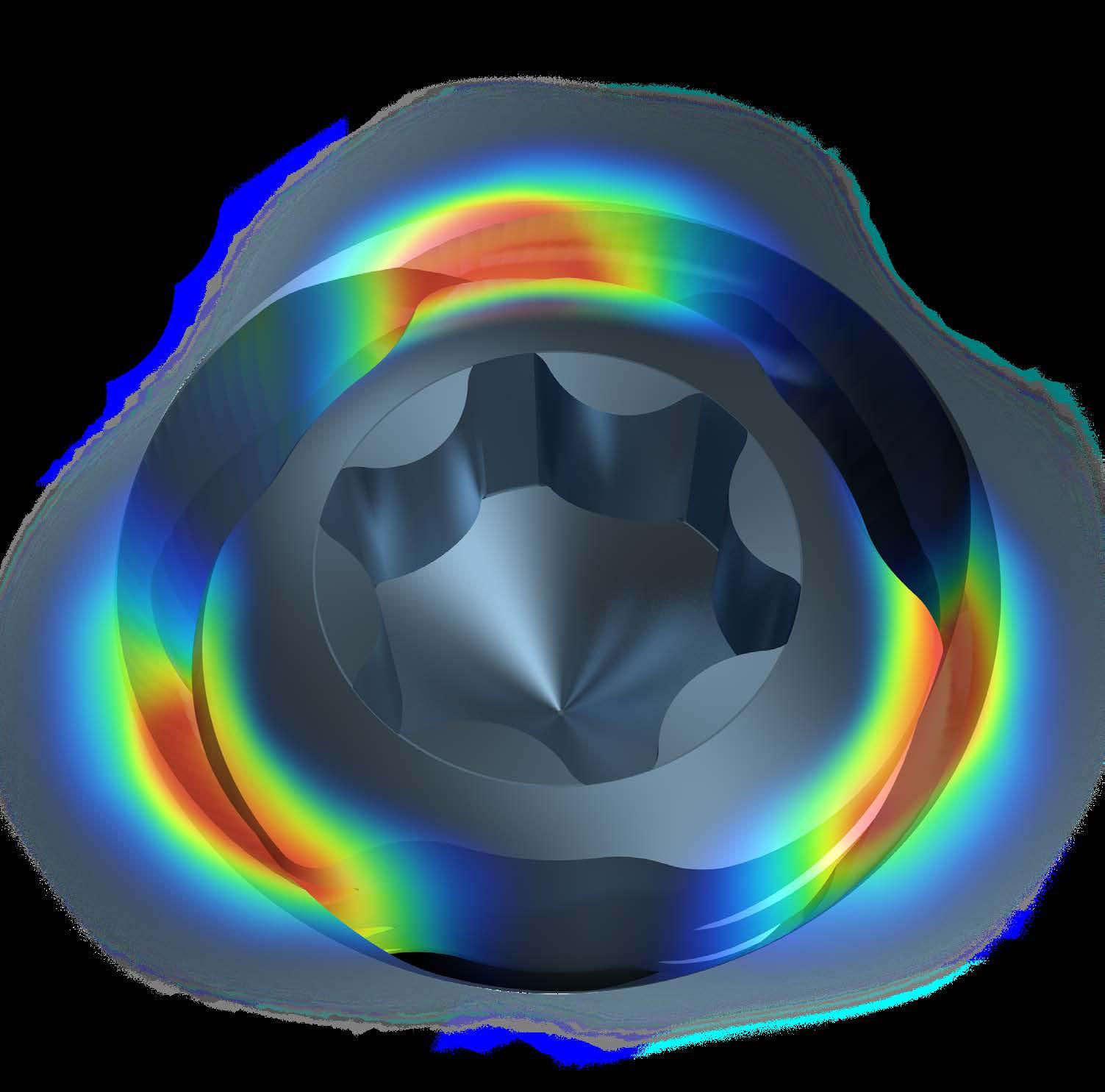
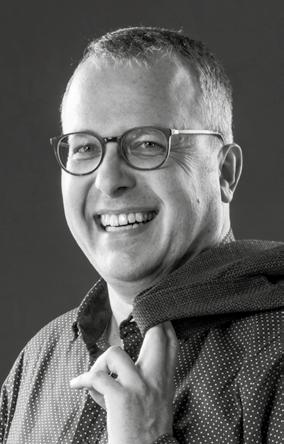
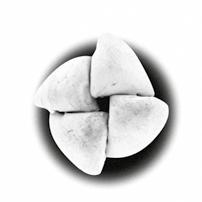
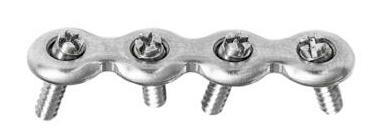
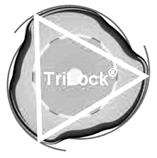
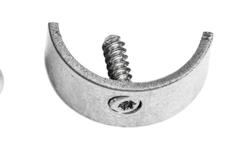
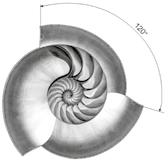
The history of product devel opment at a glance: From the prototype made of plasticine to the three-part solution, the curved radius which almost corresponds to a Fibonacci curve; then to star screws with large overall height, to the TriLock screw in the curved plate that has minimal screw head protrusion.
“TriLock has made Medartis what it is today: What was needed was not only creative minds, but also bosses who believed in the visionary tech nology,” says Matthias Walter, “The Face of TriLock”. He is the engineer and precision mechanic who co-developed the angular-stable, poly-axial, two-part locking technology – and set out to show it to the world. As the International Ed ucation Manager, he continues to do so to this day. “There is nothing more important in my professional life than TriLock,” says Walter.
A quick glance at the watch. The call from Bad Neustadt is a long time coming. A hasty sip of tea and another glance at the watch. The operation should be over by now. A quick chat with a colleague, then a third glance at the watch. Was
all the effort in vain? Staring at the phone, willing it to ring.
Hermann Zeuner, the Development engineer, feels uneasy. He sus pects something foul. In January 2002, one and a half years earlier,
Medartis was making inroads into the field of hand and wrist surgery – causing a small sensation: a locking technology that combi ned flexibility and stability when screwing in the implants.
I n the case of multi-part fractures, which often occur in the wrist, it is particularly important that the implant is able to bridge the fracture and redirect the stress around and over the fractured area. This relieves the area of the fracture, and the bone is able to grow together. However, this construct is only stable if the screw is firmly anchored to the plate, i.e., if the angle is stable. If the screw can be aligned from all directions in the screw hole before locking it and is thus placed optimally in the bone, then the system is also multidirectional. The problem is that so far no one has succeeded in combin ing the two apparent opposites – flexibility in alignment and angular stable locking – in a system made of a rigid material.
Hermann Zeuner and Matthias Walter took up the challenge, joined a little later by Dirk Thiel. They sketched, calcu
lated, discarded – until one day Hermann Zeuner paged through a cata logue in which various fasteners were present ed. In it he discovered a quick-release fastener the likes of which he had never seen before. To fix it, the two parts of the fastener were rotated against each other and fixed.
“Friction lock” would also be a conceivable solution for Medartis. The screw was supposed to wedge itself into the screw hole – but how could this cylindrical principle be transferred to a spherical shape?
With a Swiss army knife and his daughter’s IKEA modelling clay, Hermann Zeuner formed the very first “prototypes” of a po tential screw head. After a long and nerve-racking trial and error process, the friction-lock solution was perfected. Three wedges protruding from the side of the screw head provide friction in the plate hole with its corresponding counter
after Medartis had made a name for itself in oral and maxillofacial surgery, the board of directors wanted to take the next step: a foray into hand and wrist surgery. He allowed the development engineers, led by Joachim Pfefferle,
carte blanche to not only design suitable screws and plates, but also give them a chance to tackle technological challenges that had not been addressed thus far – such as the question of optimally locking the screws.
Illustration of a bone screw with the TriLock head, according to the European patent specification.
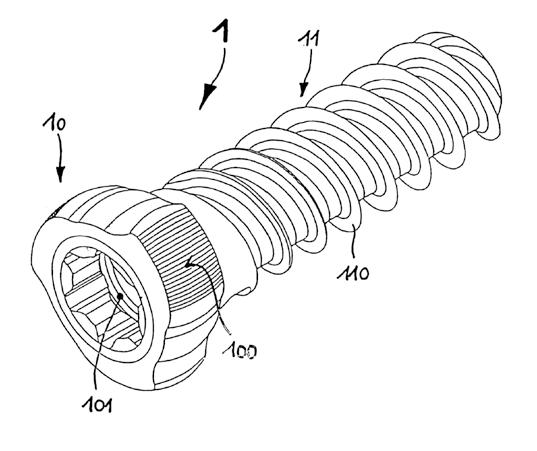
contour. It took dozens of hours to calculate the radius of the wedges, to create the optimum friction that was not too much and not too little. The screw could be swivelled 15 degrees in all directions in the plate hole, and the angle could be corrected and locked again up to three times – in theory – because it took another few weeks before the first screw was put to use. Producing the idiosyn cratic TriLock shape in a precise fashion on the turning and fitting ma chine meant that Peter Scheuble, the head of prototype construction, had to work several night shifts. He turned the de velopers’ crazy ideas into something tangible.
It’s the 20th of May 2003. The phone is ringing. Finally! Hermann Zeuner grabs it immediately. It’s Matthias Walter on the line, who is calling from the Rhön Clinic in Bad Neustadt, still in his surgical gown. Only half an hour ago he was in
the operating theatre, watching, with beads of sweat on his forehead, as Prof. Dr. Hermann Krimmer applied the patented and approved TriLock technology to a patient for the first time. “It worked like a bomb!,” he says. Hermann Zeuner hurries through the corridors and announces the good news to the project team – because TriLock was everyone’s achievement! After the technology had proven to be successful in other clinics too, Medartis was ready to launch TriLock in the autumn of 2004 in the new APTUS product line for hand and distal radius products. The technology strengthened Medartis’s reputation as a leader in innovation and helped the startup achieve the final breakthrough in osteo synthesis.
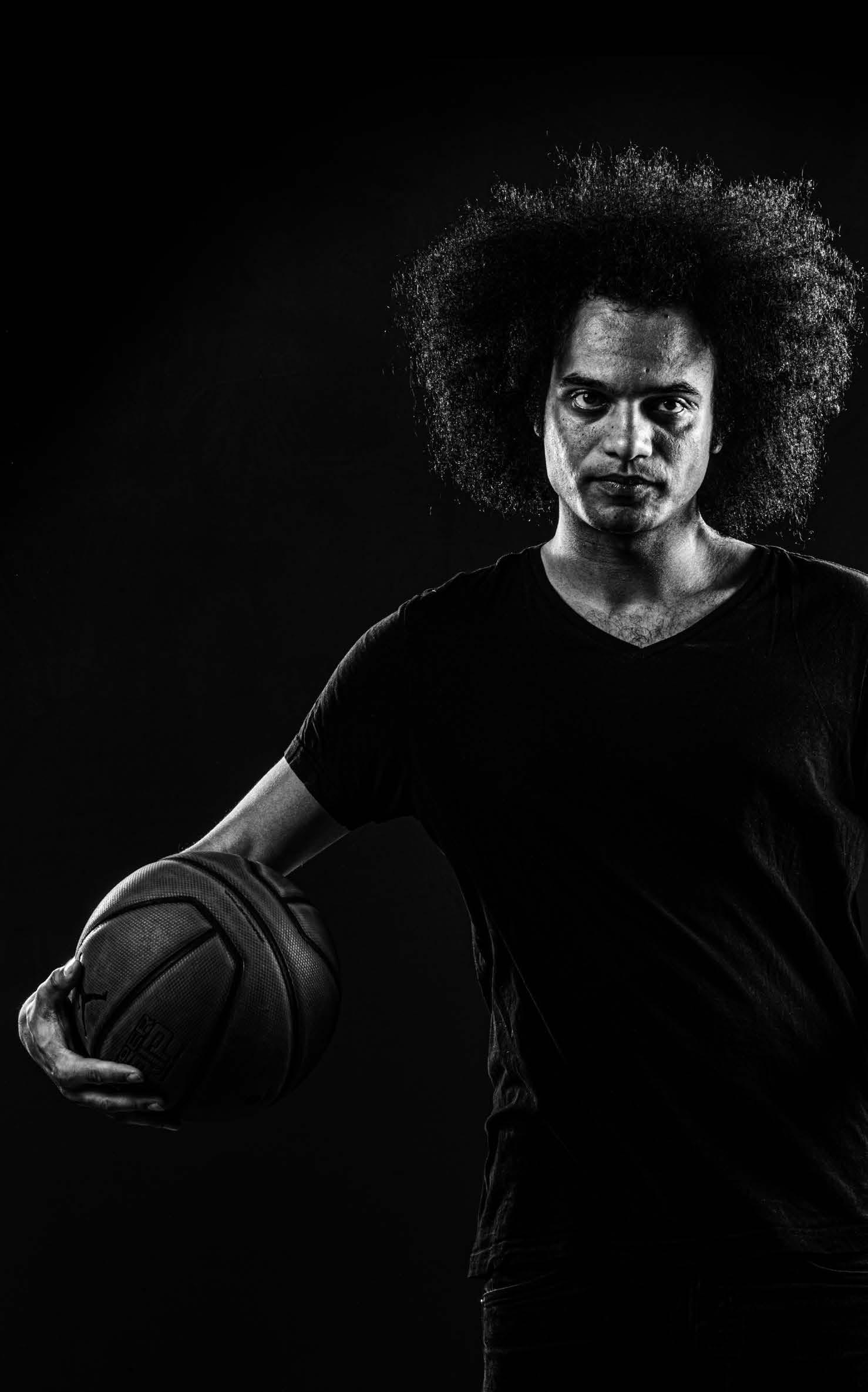
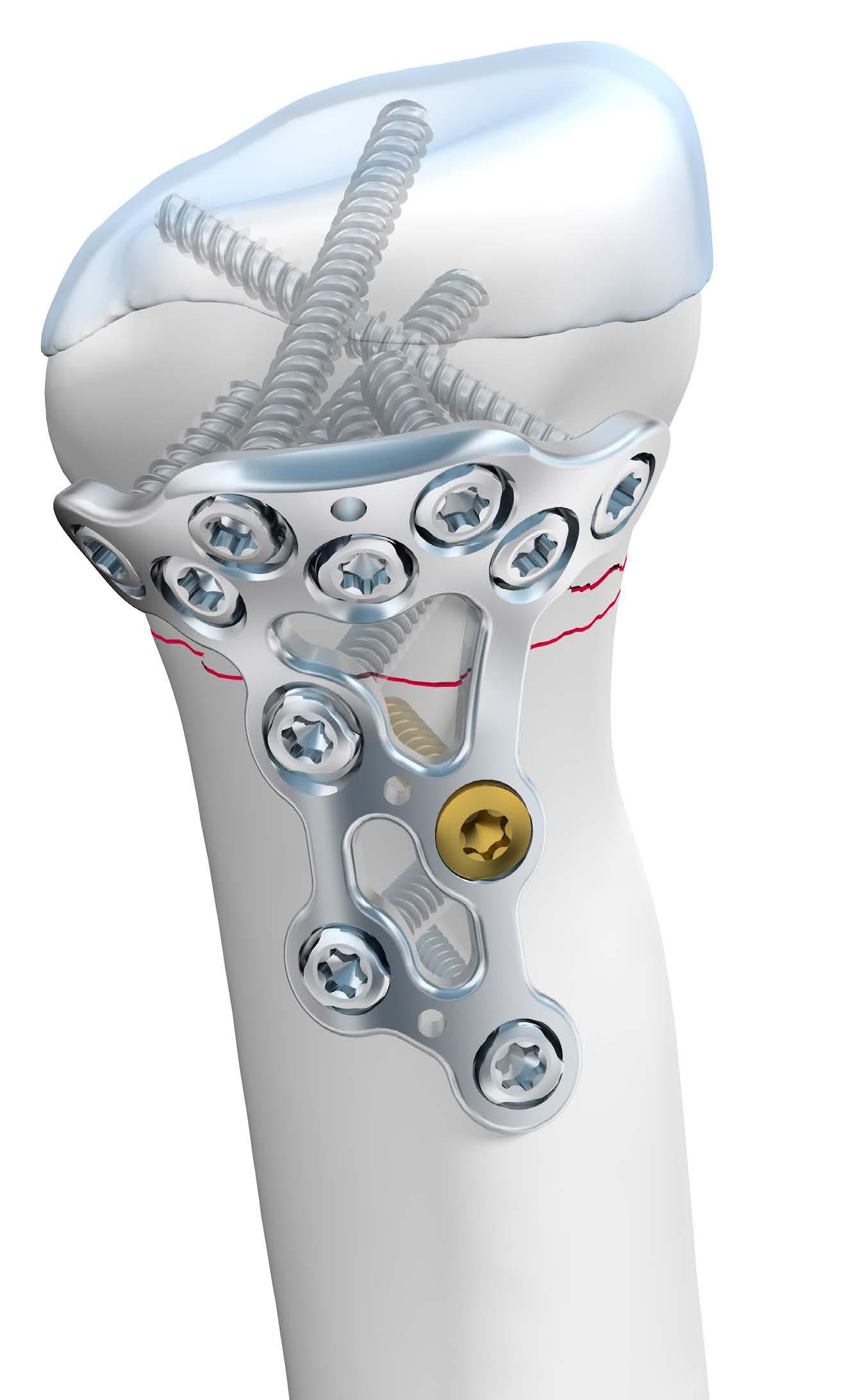
Into the extremes — While the global economy was becoming stagnant, Medartis was growing and growing. The former start-up advanced its product range extensively and expanded its infrastructure. Medartis even took a detour to the Olympics – and ended up with gold.
It’s the 20th of February 2010 and the location is the large ski jump at the Whistler Olympic Park, Vancouver. Simon Ammann pushes himself off the slope at 91.9 kilometres per hour on his fluorescent-yellow skis.
On the other side of the world, a good 8,000 kilo metres away in Riehen, Thomas Straumann is sit ting in his lounge. It’s dark outside, the family is asleep, the TV is flickering. Then the voice of the sports commentator echoes through the living room: “Fly, Simi, fly!” And Simi is indeed flying, while Thomas Straumann jumps up from his chair with excitement. A fourth Olympic medal would also be a high-flyer for Medartis.
APTUS becomes a sales hit
But let’s first rewind a bit: In September 2004 Medartis launched a new product range at the Uto Kulm Hotel on the Uetliberg, Zurich’s local moun tain. The new range was an addition to the existing MODUS systems for oral and maxillofacial surgery and was called the APTUS range, consisting of im plants for the hand and wrist.
The hand fits perfectly into Medartis’s product concept because the screws and plates have similar dimensions to those used for the skull. The market, however, is much larger than for oral and maxillofacial surgery (CMF). This is because accidents at work as well as sports injuries – the main caus es of hand and wrist fractures – are much more common than corrective surgery of the facial area due to traffic accidents. In Switzerland, for example,
around 17 per cent of the population suffer accidents at home, in the garden or during sport activities; 5.5 per cent have accidents at work, while “just” under 2 per cent are involved in traffic accidents.
But where the demand is high, supply is also plenti ful – and with it the competition increases. On top of dynamism, flexibility and precision, Medartis need ed additional selling points in the fiercely compet itive market of hand and wrist surgery, preferably a new technology. And once again Medartis could rely on its development engineers: After two years of tinkering, they launched TriLock in 2004, the first angular-stable, multidirectional locking system of its kind (pages 38-39). And for the cherry on top, Medartis patented a new development of the Torx screw head: HexaDrive. Thanks to the new screw head design, the screw adheres to the screwdriver, allowing for safer and faster work in the operating theatre.
Thanks to its unparalleled quality and groundbreak ing TriLock technology, APTUS was so popular that Medartis could hardly keep up with its deliveries. At this point, the production of the implants was still in the hands of subcontractors, but finally the extra link in the supply chain had become one too many. Thus, for the first time, in 2005 Medartis opened its own production site in Bretzwil, which happened to be in the Straumann family’s home town. In this village of 700 inhabitants in the can ton of Basel, Medartis was able to find rental space amidst the empty halls of Tschudin + Heid’s family business. In addition, there were plenty of talent ed precision mechanics in the nearby Waldenburg Valley and surrounding valleys who could meet Medartis’s high quality and precision standards.
Thomas Straumann invested eight million Swiss francs just in high tech modern machinery.
In short: Medartis was going at full speed. In 2006, for the first time, the company had more than 100 employees and increasing. Turnover was growing even faster: by almost 50 per cent per year, mainly due to the APTUS systems.
Medartis was also expanding abroad. In 2008, a number of new subsidiaries were founded, for ex ample in Mexico City, Wroclaw in Poland, and a little later in Madrid, Brisbane in Australia and Auckland in New Zealand. There was only one market still to be cracked, namely the world’s largest and most important one for med-tech products, the USA. Al though Medartis’s APTUS products did initially find users in numerous renowned clinics, the growth was slowing down. For years Medartis was unable to find a suitable CEO for its US business. Staff turn over was high – an unsolved problem.
At the same time, the global economy cooled down considerably with the outbreak of the financial and economic crisis. First the banks were hit in 2007, then the entire economy in the year that followed, and finally even countries that had sunk deeper and deeper into debt as a result of the economic relief measures were at times on the verge of bankruptcy, like Greece.
The med-tech sector was no exception as it felt the effects of the recession too. The main reason was that hospitals, which were already under pressure worldwide to save money because of constantly rising health costs, had to save even more strin gently because of the financial crisis. One way to do this was to form purchasing groups. From now on, – companies like Medartis not only had to convince surgeons and operating theatre staff of the merits of their products, but, and increasingly more often, also had to conduct very tough price negotiations with their buyers. Margins were falling. “The gold en years in medical technology are over,” summed up by the NZZ newspaper on a Sunday. Which was completely wrong as far as Medartis was con cerned.
On the contrary: Medartis needed more space and wanted to unite all business sections from development to produc tion in one location. In 2009, Medartis rented 15,380 square metres of space spread over eight floors in the brand new Stücki Business Park in Basel’s
working-class district of Kleinhünin gen. Despite its growth in 2009, even just 40 percent of the space would have been sufficient.
On top of that, Medartis had some special require ments. On the third and fourth floors, where the pro duction was to take place, the load-bearing capac ity of the floors had to be increased. Seven weeks later and with the help of a mobile crane, the heavy turning and fitting machines were transported from Bretzwil to the new headquarters in Basel.
Rumours were going around that Thomas Strau mann was starting to overdo it a bit. But anyone who knew the patron, who was still a young man back then, would have realised that the move was in fact a commitment to Switzerland as a location, to the highest quality, and to a steady growth strategy. Straumann was a visionary and he was planning for the long term.
It was during this time that Thomas Straumann sat alone in front of the TV on the night of the Olympics and watched Simon Ammann, the slender athlete from Toggenburg, make history forever. Simi flew and flew and flew – and only landed after 138 me tres. It was his fourth Olympic gold medal. No ski jumper in the world has ever achieved that.
The next morning, the phones at Medartis were ringing off the hook. It was no secret that Ammann had jumped with a new type of ski binding and that Medartis may have had a hand in Ammann’s terrific success. For months a project team led by Peter Scheuble – whom Thomas Straumann had also commissioned with the annual testing of wind tun nels, had sent him to the Swiss Ski research group – Marc Ammann and Beny Knopp had been tinkering with this ski binder. The highlight: an inconspicuous metal rod that con nects the binding of the ski with the heel of the jumper, whereby a curva ture positions the ski better in the air and thus enables a higher lift.
Even the honourable Frankfurter Allgemeine News paper wrote about Simon Ammann’s success and his Medartis ski binder, while Austria, a proud ski jumping nation and used to being winners, an nounced its objection to the curved binding. The matter even took on national-political proportions when Ueli Maurer, the Swiss sports minister, inter
vened: “I consider this matter to be rather embar rassing and hope that the Austrians will concentrate on becoming better jumpers.” In the end, the Austri an federation waived its objection.
And what did Medartis have to gain from its com mitment to the Swiss Ski Association, the gold med als and the subsequent media hype? At first glance not very much at all, apart from a few enquiries and requests from abroad to market the binder, which Medartis refused. The work for Swiss Ski was not measurable in monetary terms. The commitment went back to a Straumann family tradition. It was even said that Thomas Straumann’s grandfather, who himself was a passionate ski-jumper, came up with the idea of researching bone structures after he had experienced fractures after a ski jumping ac cident. He wanted to make ski jumping techniques safer. At a second glance, however, Ammann’s suc cess was the best advertisement ever. Medartis could now be seen as a leader on the world stage of innovations. Especially in the “war for talent”, i.e. the competition for the best specialists, this label was worth its weight in gold. Accordingly, Medartis was inundated with applications after Ammann’s Olym pic victory.
The steady of Medartis did not go unnoticed; one or two competitors were rubbing their hands togeth er, hunting for a bargain. Miesch remembers slick guys in suits and ties flying in from abroad and not giving a damn about the plates and screws of the Basel-based company. They were only interested in sales figures and margins – a stab in the heart for Willi Miesch, the passionate mechanic.
A few weeks later, three offers landed on Thomas Straumann’s desk. All of them proud, triple-digit million figures. At a Medartis management meet ing in Ticino, he submitted the offers to his most important companions: “Should we?” Straumann, Ellenrieder and Miesch looked at each other – and grinned. Selling Medartis was out of the question. But at least they knew now what their company was worth.
In 2012, for the first time, Medartis was out of the red, with a turn-over of around CHF 70 million. “We would have been able to do it even a few years earlier,” recalls Willi Miesch – but the main shareholder Thomas Straumann and the other shareholders Dominik Ellenrieder and Willi Miesch preferred to reinvest the profits and focus on rap id growth. Nevertheless, the profit was a relief for them and a confirmation
that their patience and perseverance had paid off. Thanks to the growing number of employees – there would soon be over 300 – the 15,380 square metres in the Stücki Business Park were slowly but steadily filling up.
This was also due to the fact that Medartis was con tinuously expanding its product portfolio. As early as 2010, the company entered the business sector for the lower extremities with foot surgery. In the region of the upper extremities, implant systems for elbows were added, followed somewhat later by those for the shoulders. The elbow system was co-developed with a design team, comprising ten physicians, and finalised by surgeons Prof. Dr. Lars Müller, Dr. Klaus Burkhart and Dr. William Geissler. These systems were complemented by a new tech nology: the patented SpeedTip screw (pages 5657). Its self-tapping thread is razor-sharp so that the surgeons didn’t have to pre-drill the bone anymore. This saved time in the operating theatre.
By moving from the head to the upper and now to the lower extremities, Medartis was following a trend. Whereas in the 1990s a distinction was made only between general, or thopaedic and oral and maxillofacial surgery, the medical profession had since become increasingly specialised. As a result, new clinics for hand, elbow, and shoulder and foot surgery were springing up all over the world. Medartis had access to these specialists mainly through the International Bone Research Association (IBRA), which was co-founded by Thomas Straumann and Willi Miesch. In the field of hand surgery, it was able to get the Ravensburg surgeon, Prof. Dr. Hermann Krimmer, on board early on – one of the most renowned surgeons in Germany and the first user of TriLock. Another world-renowned physicians, orthopaedic surgeon Prof. Dr. med Dr. phil. Victor Valderrabano from the Basel University Hospital, became Medartis’s first customer for foot implants and subsequently influenced the developmental projects such as “Design Surgeon”.
On 15 January 2015, Thomas Jordan, President of the Swiss National Bank, appeared before the press and television cameras. He had bad news for the Swiss economy: the National Bank unexpected ly abolished the minimum Euro exchange rate of 1.20 francs. Within minutes, the Euro dropped to a historic low of 85 Cents (Rappen). And within hours, Swiss goods had become more expensive for cus tomers from the Euro countries. The export indus try was hit real hard, worries about jobs increased. Soon there was talk of a “franc shock”.
In Basel, Willi Miesch was conducting a workshop with the British subsidiary sales team when his as sistant, Antonietta Fasolin, stormed into the meet ing room. “Willi, you should come and see this.” A lit tle later, Miesch met with his chief financial officer, Dominique Leutwyler, in the auditorium. The calm manner of this numbers-genius was most soothing for Miesch’s upset soul. Together they worked out a plan of action. One thing was clear from the start: they would not be saving on the employees.
The workforce was informed in the spring: There was to be no job cuts at Medartis, no wage reduc tions, no reduced working hours, no relocation of production abroad; only a 7 percent reduction in op erating costs in Basel. Medartis was taking the bull by the horns: even faster growth, even more turno ver. The sales teams were challenged to win new customers – both in the core business of “radius and hand” and in segments with great sales poten tial, such as elbow and shoulder surgery.
In the past, Medartis was repeatedly perceived as a good candidate for a takeover – also for the reasons already mentioned – now it was planning its own strategic acquisitions. But this required a lot of money. A new chapter in the history of Medartis was about to begin, venturing into new horizons.
On 25 September, 18 visionary surgeons founded the International Bone Research Associ ation (IBRA) at the Hotel Ermitage in Küsnacht (ZH). Also present: Thomas Straumann and Willi Miesch. On the same day, Medartis launched the APTUS product line.
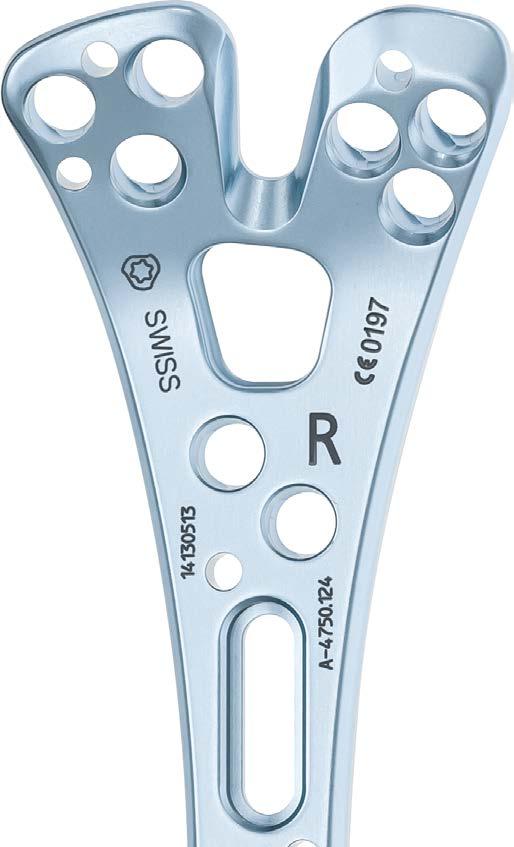
APTUS is launched – now the implant system has to get out into the hospitals! The members of the sales team make sure this happens, not least at internation al trade fairs such as that of the German Society for Trauma Surgery in Berlin. In the picture: Thomas Tribelhorn (front), then Head of Business Unit Trauma, and international sales representative Armin Beyer.
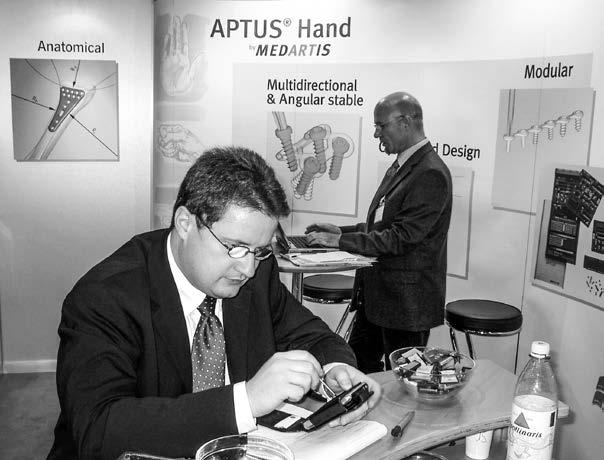
In Bretzwil, a village of 700 inhabitants, Medartis opens its first own production site in a factory building once built by grandfather Prof. Dr. Reinhard Straumann. The state-of-the-art machinery costs eight million Swiss francs. There are plenty of talented precision mechanics in the region who find employment there.
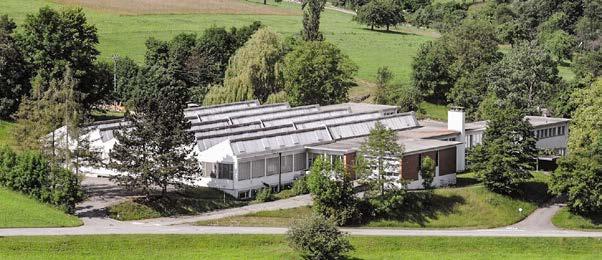
The cherry on top: Medartis rounds off their TriLock technology with a new screw head that optimally transmits the torque: the patent-protected HexaDrive.
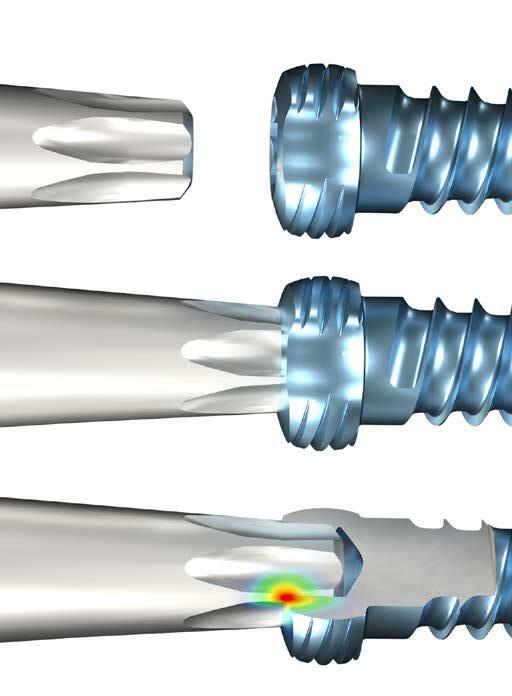
Medartis trains surgeons in the use of implants, here at the first hands-on course with APTUS in Wiesbaden. Left: Prof. Dr. Hermann Krimmer, the first user of TriLock.
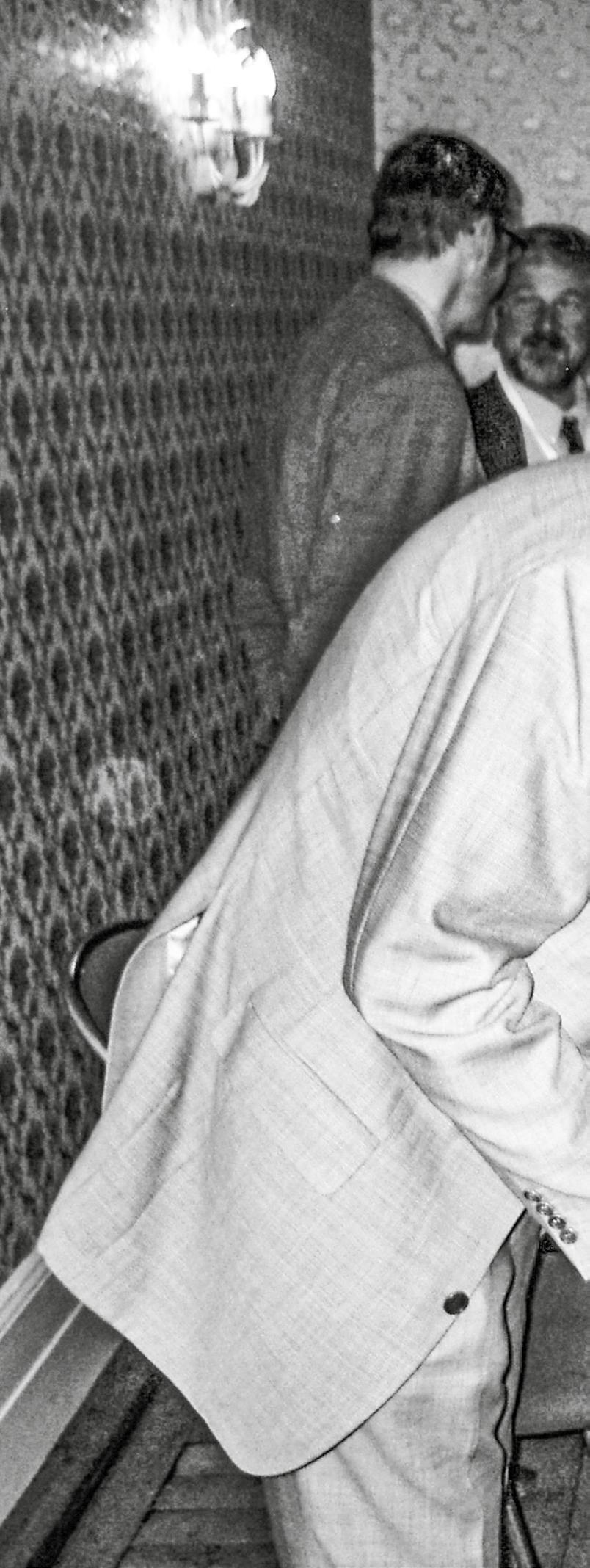
Right: Primarius Dr. Wolfgang Hintringer. The link between industry and science is the International Bone Research Association, IBRA for short. In 2008 it held its first interna tional scientific symposium in Basel. The topic: “All around the Radius”.
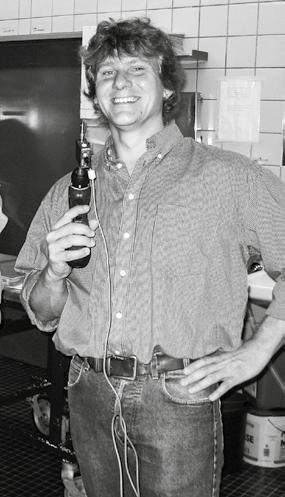
Developer Dirk Thiel measures the torque curve while removing various TriLock SpeedTip screws from the fore head bone of a Mini Pig.
Axel Maltzen joins Medartis from Stryker Leibinger and expands quality assurance, becoming Head of Production (CPO) in 2014.
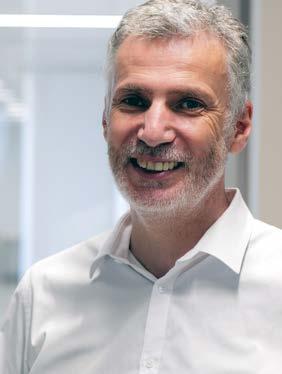
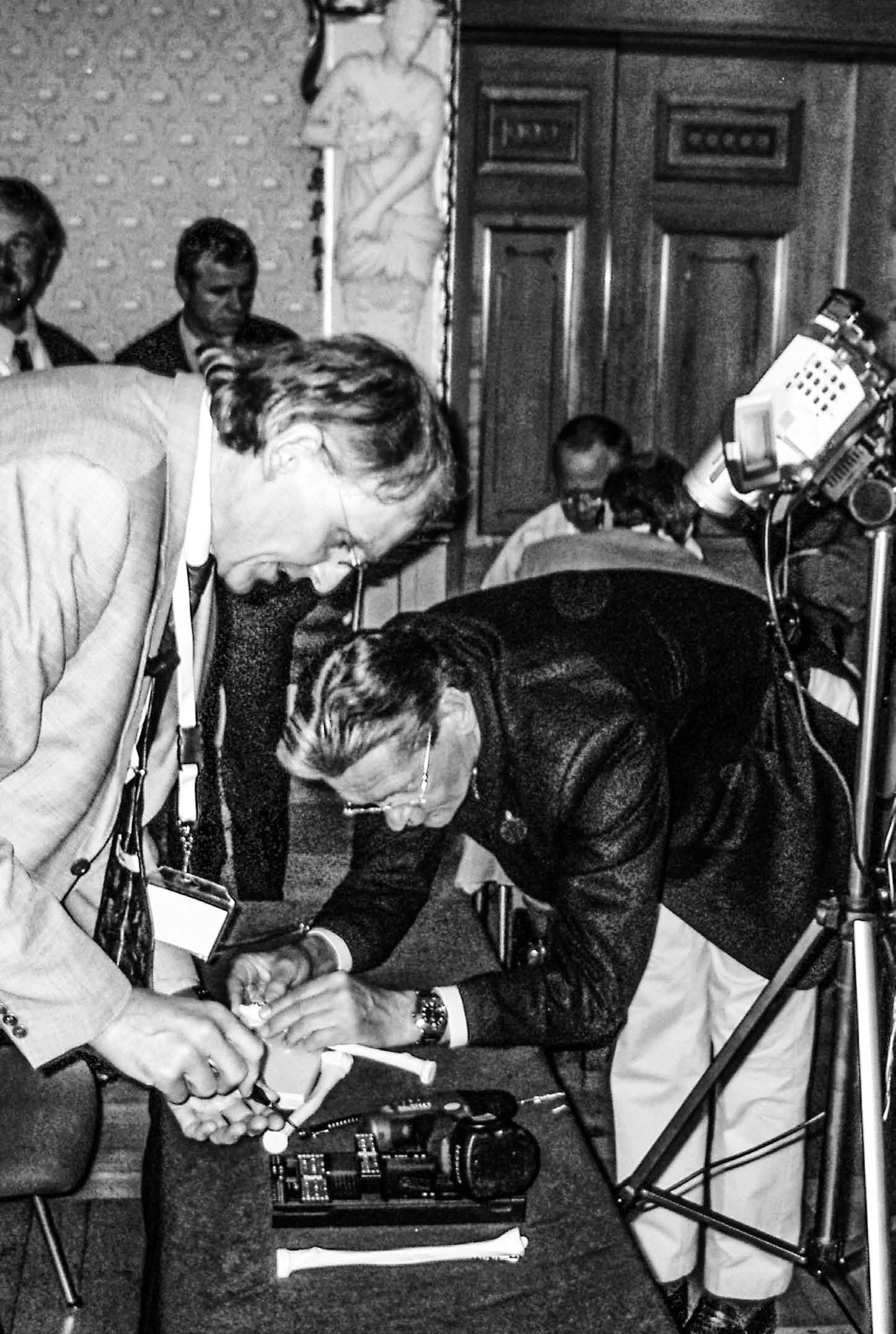
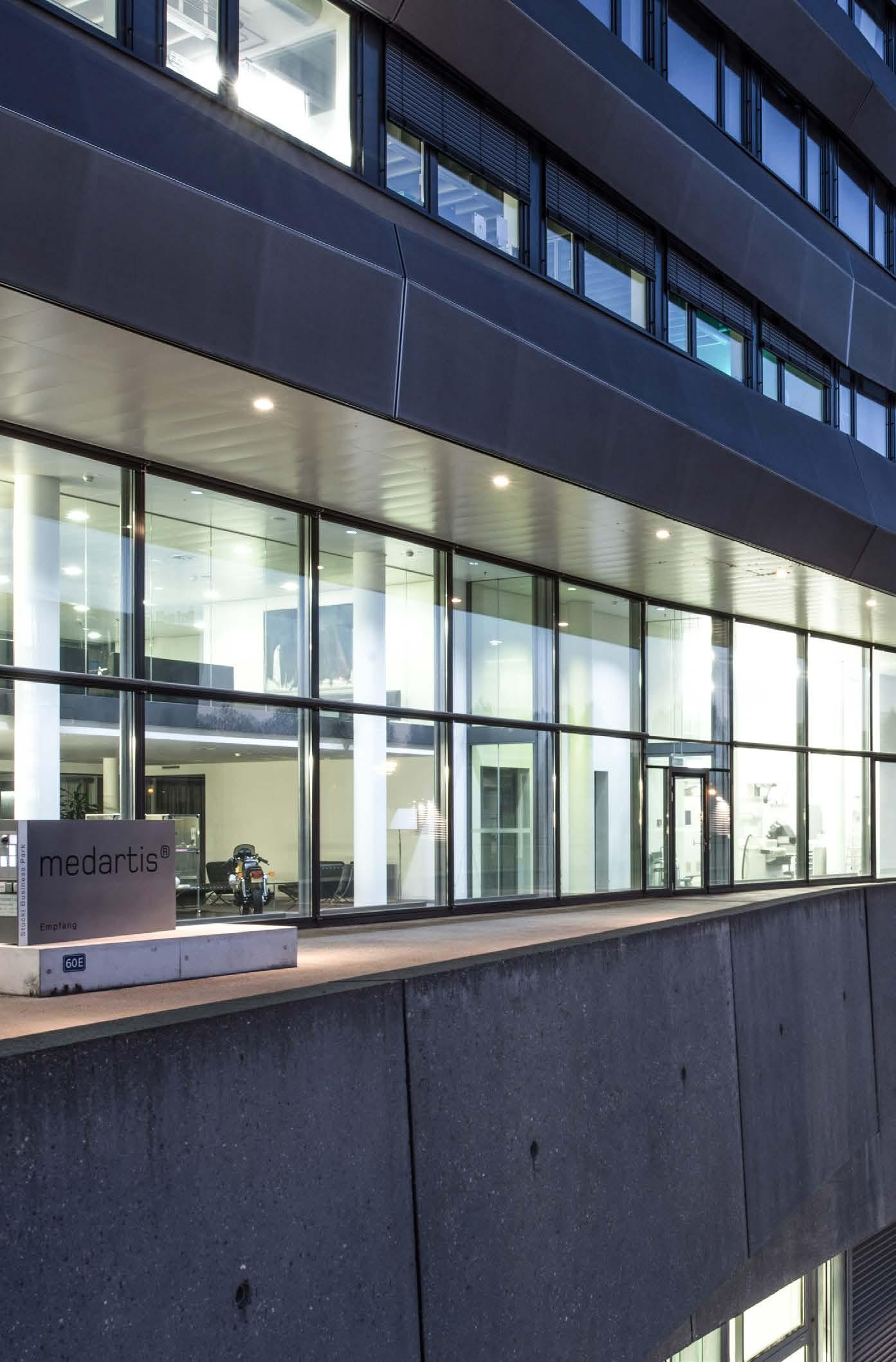
2010
Medartis trains polymechanics – male and female – for the first time. This way, talented specialists are raised up inhouse – and often stay with the company. Like Fabian Wildi (pictured): In 2013 he started his apprenticeship as a poly mechanic EFZ. When he went home, he would keep talking about the extensive, modern machinery and the thorough cleanliness: “You could eat off the floor.” Since completing his apprenticeship, Wildi has been a machinist in screw production and is now a federally certified technician HF mechanical engineer.
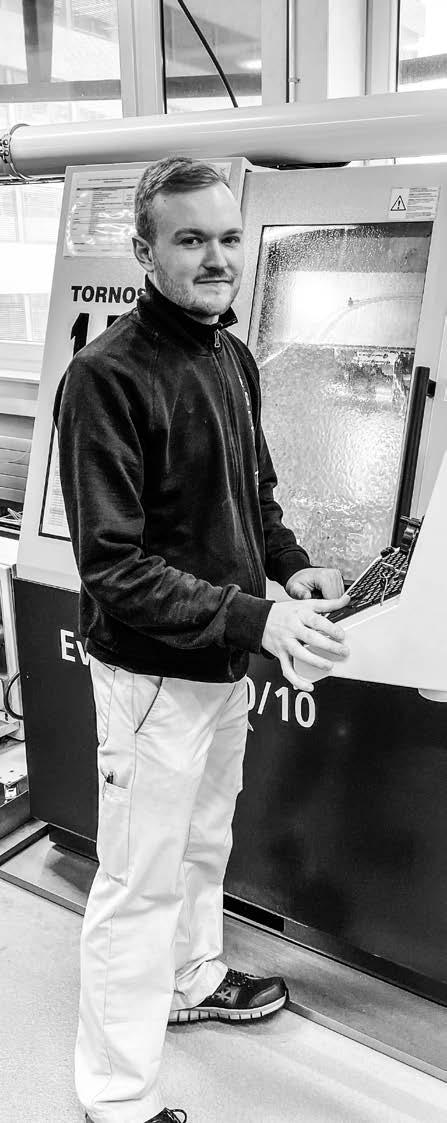
In addition to polymechanics, Medartis has also been training business consultants since 2016 and logistics specialists since 2021.
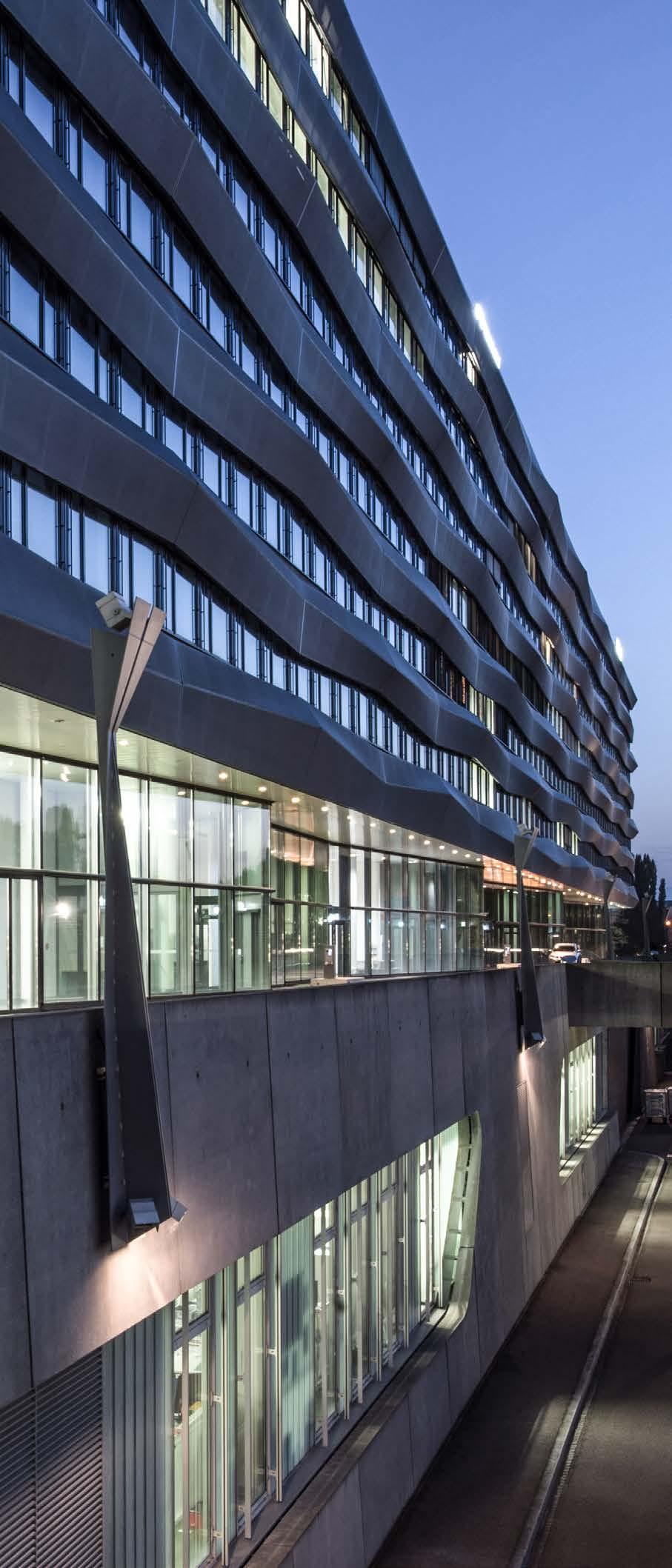
2010
Expanding into the area of foot surgery, Medartis enters the business field of the lower extremities. The expansion of the portfolio goes hand in hand with the increasing specialisation within surgery.
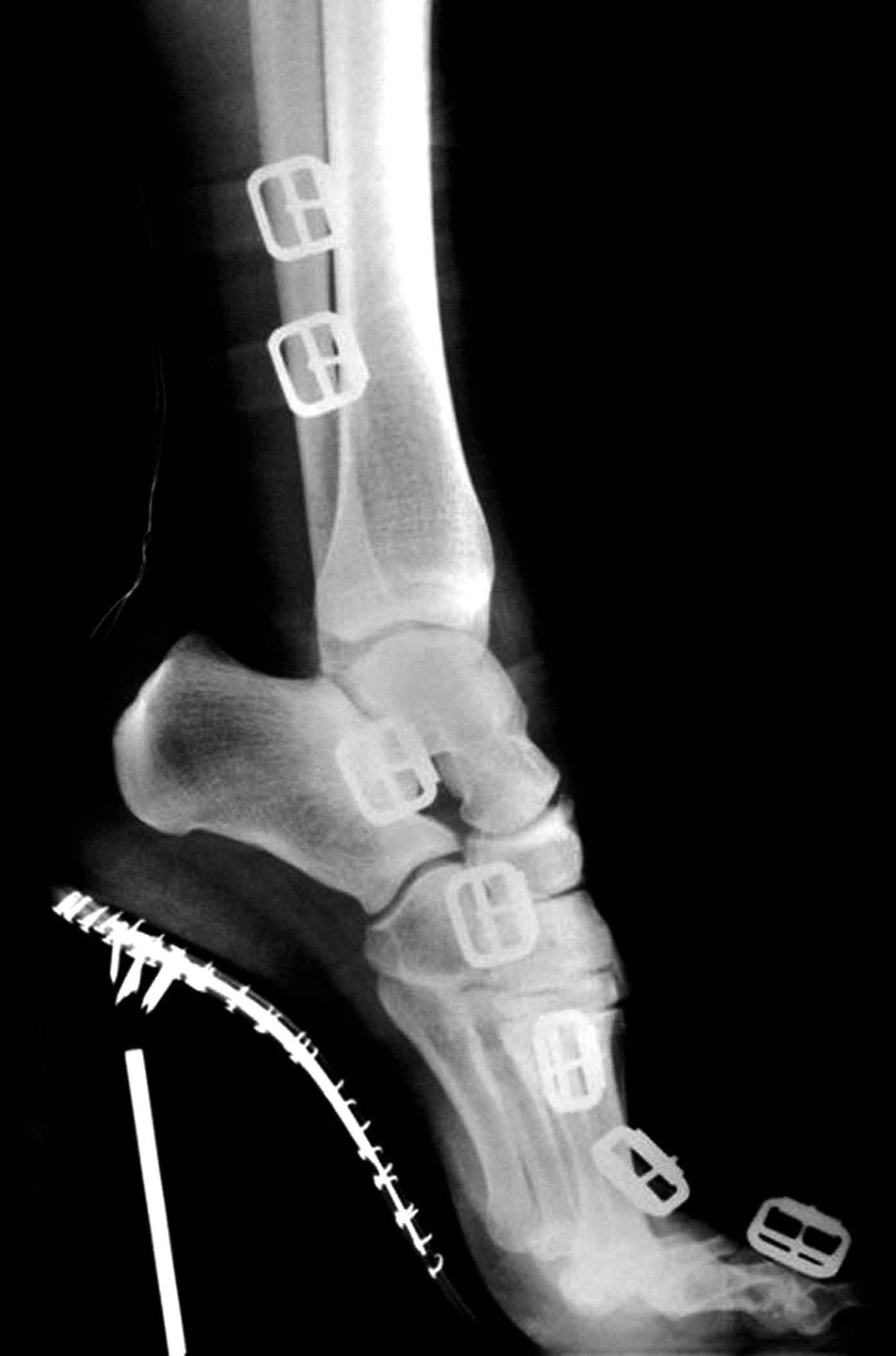
2010 Simon Ammann flies to Olympic gold medals number 3 and 4 in Vancouver. Medartis has also contributed a little to his success: a project team led by Peter Scheuble has equipped Ammann with a new, curved binding bar that allowed him to fly particularly far. Thus, the double Olympic vic tory also brings Medartis a lot of international attention.
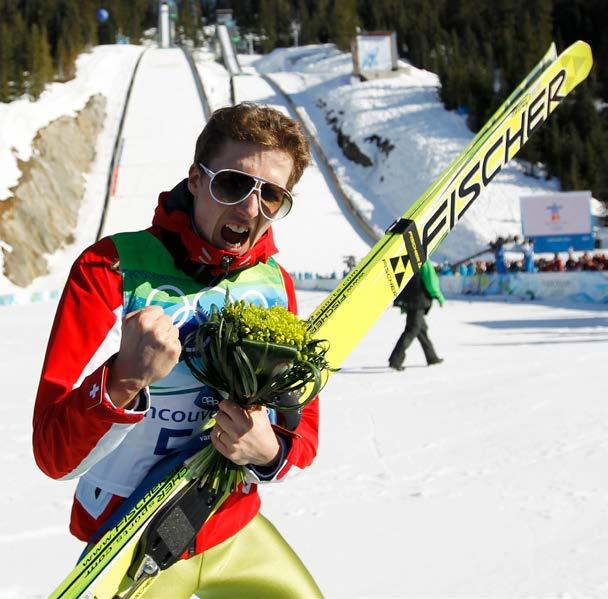
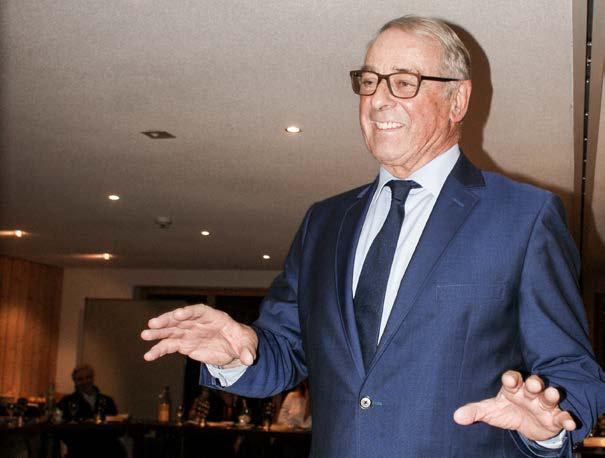
2015 On 15 January, the President of the Swiss National Bank, Thomas Jordan, announces the end of the minimum euro exchange rate of 1.20 francs, and the euro temporarily falls to 85 Rappen. Medartis also feels the “franc shock” and cuts efficiency and margins. But no employ ees are laid off.
Willi Miesch cleans up one busi ness award after another. It began in 2005 with the SME Entrepreneur Award Northwestern Switzerland. In 2015, he was awarded the Prix SVC Nordschweiz. And a year later, Ernst & Young even named him “Entrepreneur of the Year” – just like Thomas Straumann 16 years earlier.
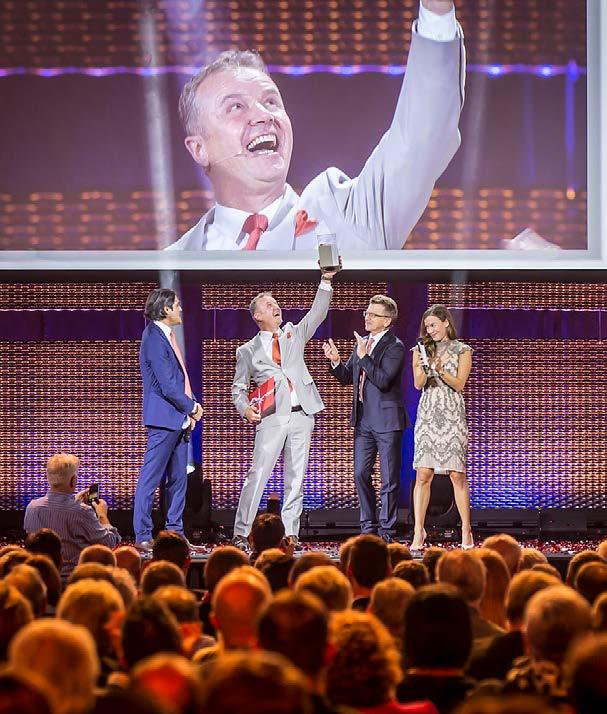
At the Medartis Management Meeting in the Waldhotel Doldenhorn in Kandersteg, former Federal Councillor Adolf Ogi gave a presentation entitled “Leadership put into practice”. However, “Dölf” Ogi did not leave it at giving leadership tips. He talked about his relationship with the Straumann family, which went back decades. As early as 1958, Ogi’s father, as OC President of the Swiss Ski Jumping Championships, relied on a scoring system invented by Reinhard Straumann – Thomas Straumann’s grandfather. Together with Fritz Straumann, Adolf Ogi then set up a scientific commission within the Swiss Ski Association in the 1960s. This symbiosis between industry and sport resulted in various tangible achievements such as aerodynamic ski suits or the legendary low-drag ski poles for extra speed. With the latter, the Swiss won a double victory at the 1972 Olympic Games in Sapporo: Bernhard Russi skied to gold, and Roland Collombin to silver!
As a child, I dreamed of becoming a needlework teacher. But I was advised against it because of the excess of teachers at the time. So I trained as a saleswoman for sport ing equipment and later worked in a trust office. I lived out my passion for handicrafts with my two sons. We were always crafting something, like masks for carnival for example.
In 2007 I finally had enough of working a desk job and applied at Medartis as a model maker. After a trial day, I was hired. I remember my first day at work well. Workshop manager Benny Knopp introduced me to my colleagues and – to my surprise – also to a woman: Elena Herrera, the first female polyme chanic at Medartis.
Alain Hasenböhler then introduced me to my work. He gave me a handful of implants and screws, a skeleton of a hand, made of plastic and an identical skeleton with plates already fixed in place, a so-called master model. My new job was going to be to rebuild such master models. Finally, I had found my dream job.
I work a bit like a surgeon, with the crucial difference that I take care of plastic models. I bend the implant to the right angle, fix it temporarily with two screws, pre-drill the screw holes, draw the fracture line according to the master model, file it slightly and colour the lines with a red varnish. At the end I fix the implant. Done.
I am particularly pleased when developers or product managers ask me for advice: “Susi, can this implant be fitted to this radius?” Because no one in the company knows how the implants will bend in practice better than I do.
Once, in 2019, I had to treat an entire skeleton with every conceiva ble fracture. The poor thing had 100 fractures! After 60 hours of work, the gift for our long-time managing director, Willi Miesch, was finished.
No physician has screwed in more bone implants than Susi Walliser (62). The woman from Reigoldswil began her career at Medartis in 2007. Since then, she has created well over 4,000 models, which are used by the sales staff, trainers and surgeons around the world for demonstration purposes.
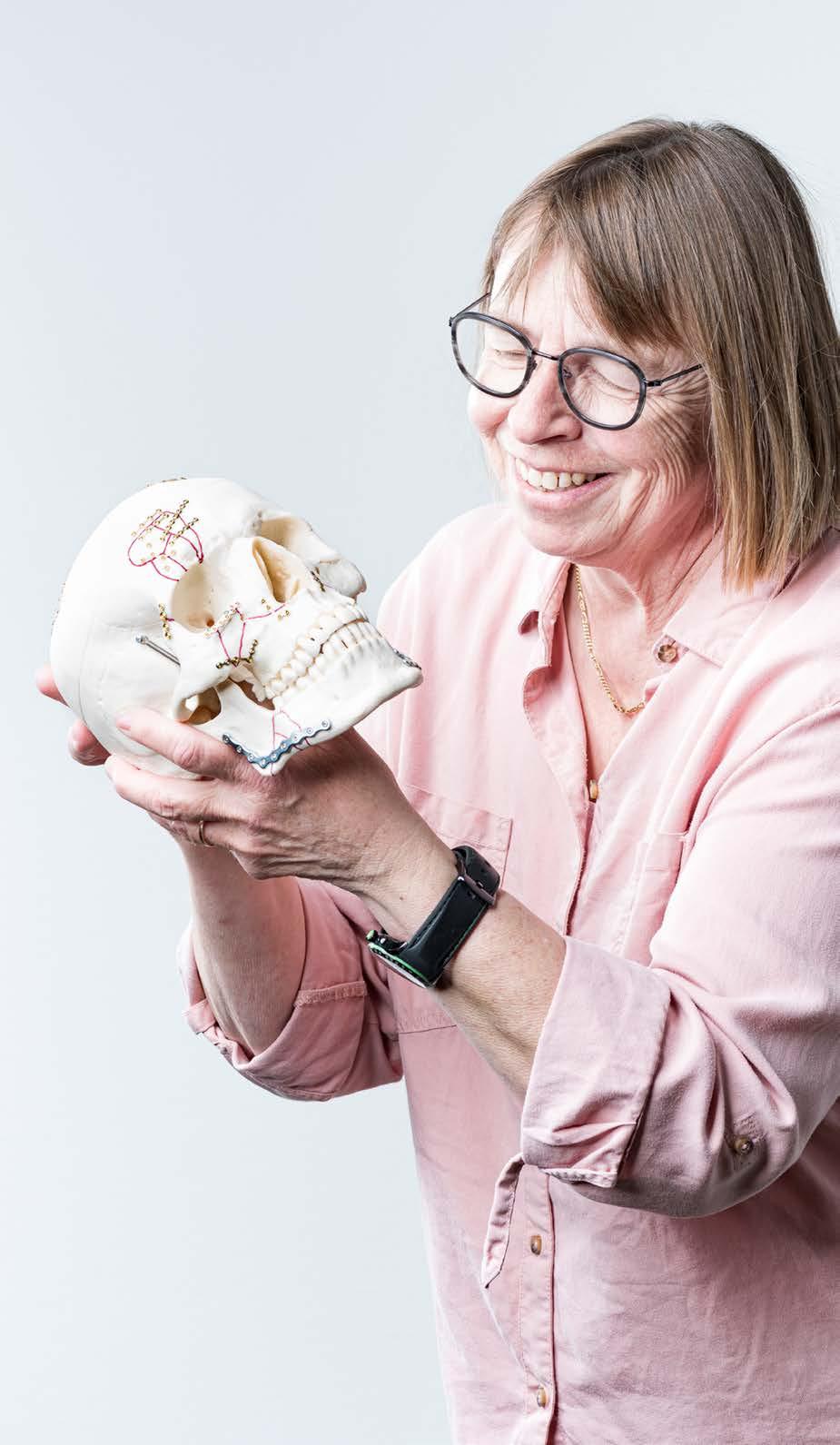
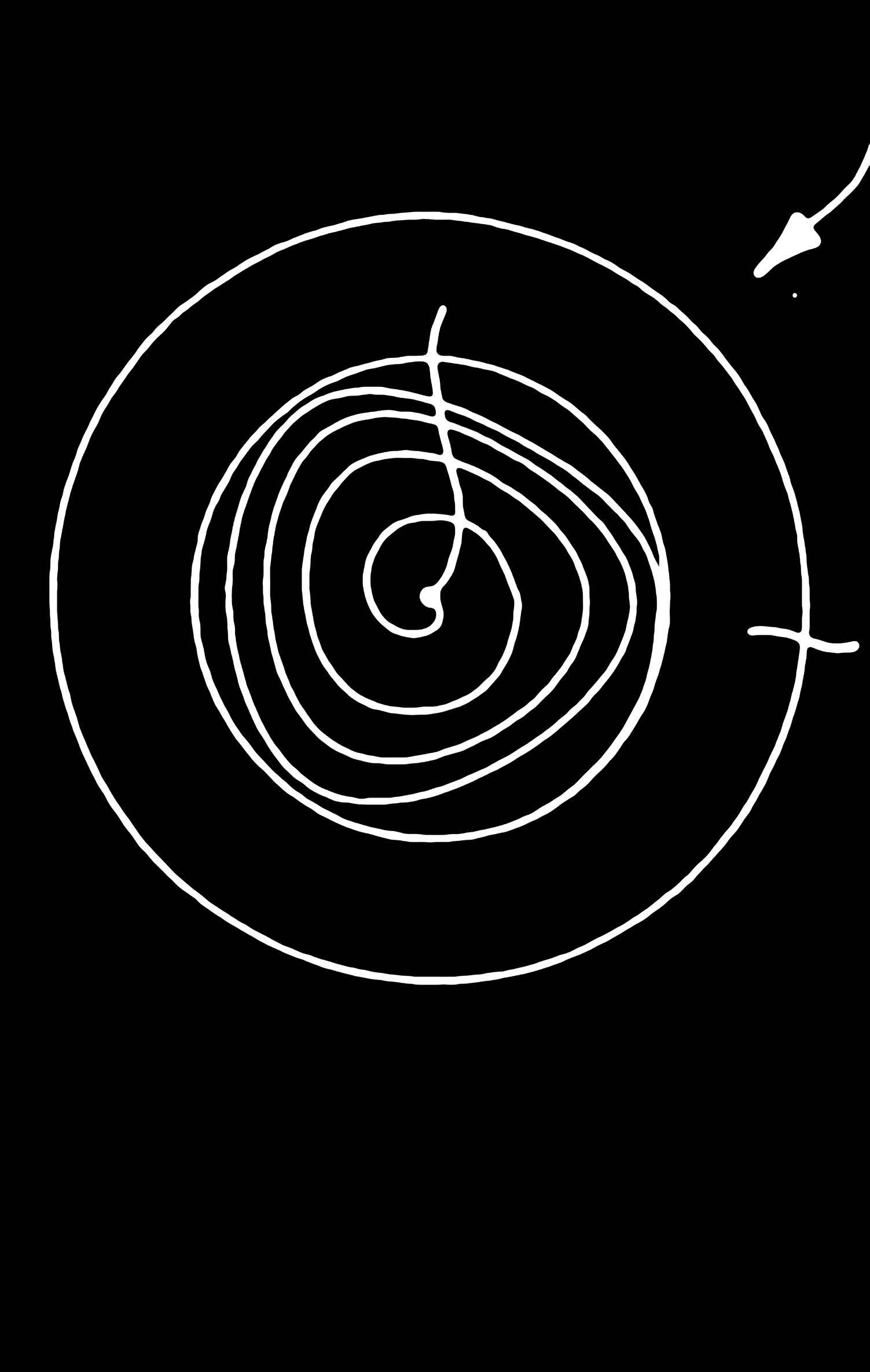
In the section behind the tip, the screw becomes slightly narrower and then widens again towards the screw head. This design guarantees minimal friction in the bone tissue.
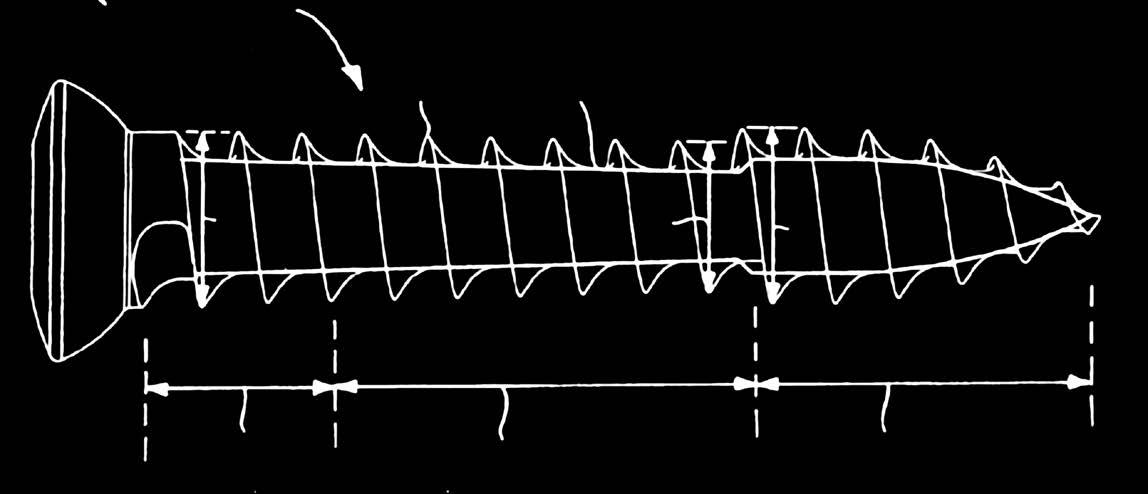
T ypical Willi Miesch: he has brought some tools to the meeting with the Board of Directors. He carefully holds the tiny screw between his index finger and thumb, places its tip on the (rather expensive) conference table and applies the screwdriver. Within seconds, the
screw disappears into the solid beech wood without any pressure.
“Like a hot knife cutting through butter,” Miesch grins at the Board of Di rectors who stare at him in astonishment.
In the preceding years, a problem had arisen in oral surgery that urgently
needed to be solved. In order to fix a fracture of the upper and lower jaw, the surgeons prefer using self-drilling and self-tapping screws to avoid costly wire ligatu res. That way, they would not have to pre-drill the patient’s bone or cut a thread. But the steel IMF (Intermaxillary fixation)
Oral surgeons turn to the industry with an unsolved problem, Medartis responds by creating what is likely to be the world’s sharpest screw.
Cannulated, i.e. hollow, compression screw.
screws on the market had a decisive disadvan tage: If the torque is too high they break – a night mare in the operating theatre!
M edartis entrusts the project to its develo per Dirk Thiel, who has already contributed to the development of the TriLock technology. Now Thiel was to develop a self-drilling and self-tap ping screw that would be unbreakable. What makes this task parti cularly tricky is that the screw has to be made of titanium because it is more biocompatible than steel. But unfortunately it is also softer. There is only one option: instead of increasing the hard ness of the screw, Thiel has to lower the torque. It must be possible to turn the screw into the bone with as little force as possible. That way there is no danger of it breaking.
One prerequisite for this is that the screw thread has to be razor-sharp. This is a challenge, espe cially for prototyping, because in theory it is
clear that the thinner the thread tip, i.e. the outer most part of the thread, the sharper the screw.
But manufacturing wafer-thin thread tips requires a great deal of know-how. The head of prototype construction, Peter Scheuble, and the precision mechanic Alain Hasenböhler take on the task, test the limits of what is possible and end up producing thread tips that are two hundredths of a millimetre thin.
But that’s not the end of the job. Despite the sharp flanks of the thread, Dirk Thiel notices that the friction increa ses in the bone and with it the torque. While fidd ling around, he notices that the screw can be screwed in more easily if it becomes thinner in the direction of the screw head. This minimises the friction in the bone. Now he has to find the right dimensions. In the end,
a few tenths of a millime tre of taper in the centre of the screw make all the difference.
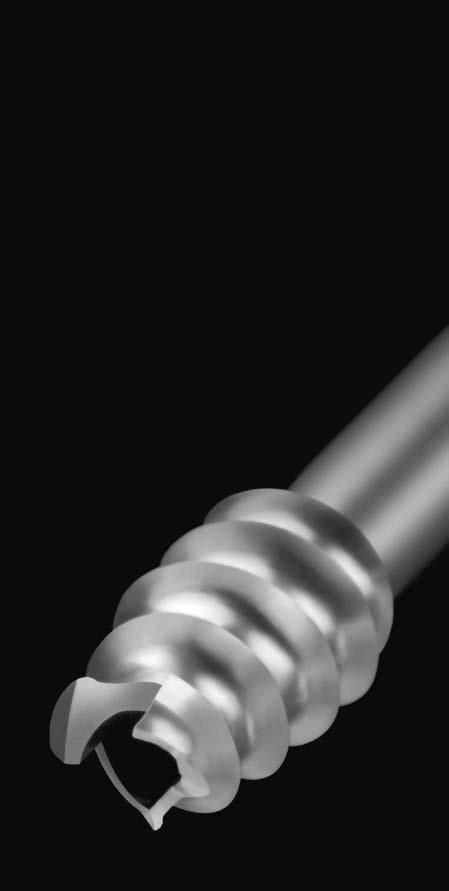
Producing the unevenly thick screw on the turning machine also has its pitfalls – bringing Scheuble and Hasenböh ler back to the drawing board. While Scheuble is working on his wooden veranda on the week ends, he comes up with an idea of how he could optimise the new type of screw: with a triangular tip, as is usual for screws in wood construction.
In fact, the principle also works in medical tech nology. The triangular geometry of the tip drills, displaces and compres ses the bone tissue when it is screwed in, thus ensuring increased tearresistance. In addition, it cuts the bone immediately even with low
contact pressure. This saves time and energy in the operating theatre.
In 2008, the first SpeedTip screw was launched on the market. It became a success, also because Medartis marketed it rather cleverly. The SpeedTip 2.2 and 3.0 cannulated compression screws for use in the extremities followed in 2011. Since then, peace and quiet has returned to the cli nics. And when Medartis does get feedback on the SpeedTip screw, it is always the same: “It goes in like a hot knife cutting through butter”.
Compression screws with various diameters for use in the extremities.

For an innovation leader like Medartis, it is essential to anticipate trends and customer needs over the long term and to constantly ask how technologies, brands, services and values can be shaped and developed successfully. On the next few pages, three up-and-coming Medartis talents dare to take a visionary look into 2047 – Medartis's 50th birthday.
Surgeries and diagnostic procedures are increasingly being performed in small, independent centres rather than in hospitals. This is particularly true in the USA, where this shift to so-called ambulatory surgery cen tres (ASCs) is very evident. These centres are also increasingly per forming the types of orthopaedic treatments that are of concern to us. In the COVID years of 2020 and 2021, the trend was reinforced. Projecting this trend forward, by 2047 we can expect the majority of all orthopaedic procedures to be performed in outpatient centres. This also has cost benefits for the healthcare systems.
For medical technology companies, this means that their business models must be rethought and redefined, for example by investing in their own reference center or facilities. There are three reasons for this: First, to gain direct access to patients; second, to prove that the quality of their treatments ex ceeds that of the healthcare indus
try’s standard of care; and third, to gather important data that can be shared with other cost centres.
This scenario would mean that in future, med-tech companies would operate their own network of clinical facilities. We are currently struggling with this idea, as it poses many challenges and raises ethical questions.
Although the current pace of change makes it difficult to predict what the healthcare sector will look like in 25 years, we believe that a more intensive type of collaboration is necessary and also realistic. Patient data, which is increasingly important for med-tech companies, is mutually exchanged and most implants are created directly in outpatient facili ties at the “point of care” using addi tive 3D technology.
For some years now, numerous medical technology companies have been trying to secure their custom ers by offering them additional ser vices. Product providers are passé. Solution providers are in! One of these additional services is preop erative case planning. In 2017, we teamed up with the Basel-based start-up Mimedis to create the “CMX offer” and have successively improved its development. What was initially accessible only to oral and maxillofacial surgeons can now also be used by hand and foot surgeons.
In future, services such as conven ient kit management in the operating theatre prep-room, a fully automat ed ordering and restocking system using RFID technology, an intelligent sterilisation solution, disposable kits, or comprehensive recycling processes are conceivable. In par ticular, advancing digitalisation and environmental awareness open up countless service possibilities, especially in patient preparation, in support during the operation, and also during the aftercare. The following is an example:
Artificial intelligence is used to recognise and classify various frac ture types. Then, using 3D data, the software automatically arranges the bone fragments to their original position and immediately presents the user with a selection of possible standard plates. Before a technically demanding operation actually takes place, it is simulated and practised – based on the patient data of course. During the operation, the surgeon receives an exact step-bystep visualisation thanks to aug mented reality technology and a HoloLens. Finally, after the success ful operation, the patient can follow his or her own rehabilitation process with the help of certain smartphone applications and is able to carry out the instructions he or she receives from the medical staff in an inde pendent and efficient way.
What this futuristic example shows is that the times of standardised, all-inclusive offers and going at it alone are over. Complex services require specialised knowledge from partner companies. For example, processes such as sterilisation, recycling or warehouse manage ment could be offered as part of networked services or outsourced entirely to specialised partner com panies.
Various therapies are tested primarily on white men.
Heart attacks are often not recog nised in women because the known symptoms are those that occur in male patients. If a woman is in volved in a car accident, she is more likely than a man to a) be seriously injured (47 per cent higher) or b) die (17 per cent higher). Why? Because crash test dummies are modelled and built based on images of men. Author Caroline Criado-Perez proves all this in her meticulously researched book “Invisible Women”. She found out that most of the data collected in the health sector comes from men.
But women are not standard deviations.
The situation is similar for medical staff: Researchers at the Cleveland Clinic Foundation say that it will take more than 200 years for orthopaedic surgery to reach the gender parity of the general medical profession. Management positions in hospitals are not even mentioned.
Socio-demographic data shows that women are heavily underrep resented in trauma surgery and the orthopaedic professions. In England, the United States, Australia or Switzerland, the proportion of wom en is in the single digits, in Austria and Canada only just over 10 per cent. In some fields, such as paedi atric surgery, hand surgery or foot and ankle surgery, the proportion of women is higher. Members of society agree that the low proportion of women in orthopaedics is unfair.
By 2047, we will certainly have bet ter products, more data and better processes. But progress will not be as fast, as effective or as beneficial if we do not take into account the full diversity of humanity. Digitisa tion and standardised procedures will foster this diversity, outpatient centres will offer better work-life balance, and the face of surgical care will be increasingly female, as more women than men are now graduating from medical schools. Mixed teams of all colours will serve an increasingly diverse client base. A multicultural system where everyone counts and everyone contributes can more easily remove barriers.
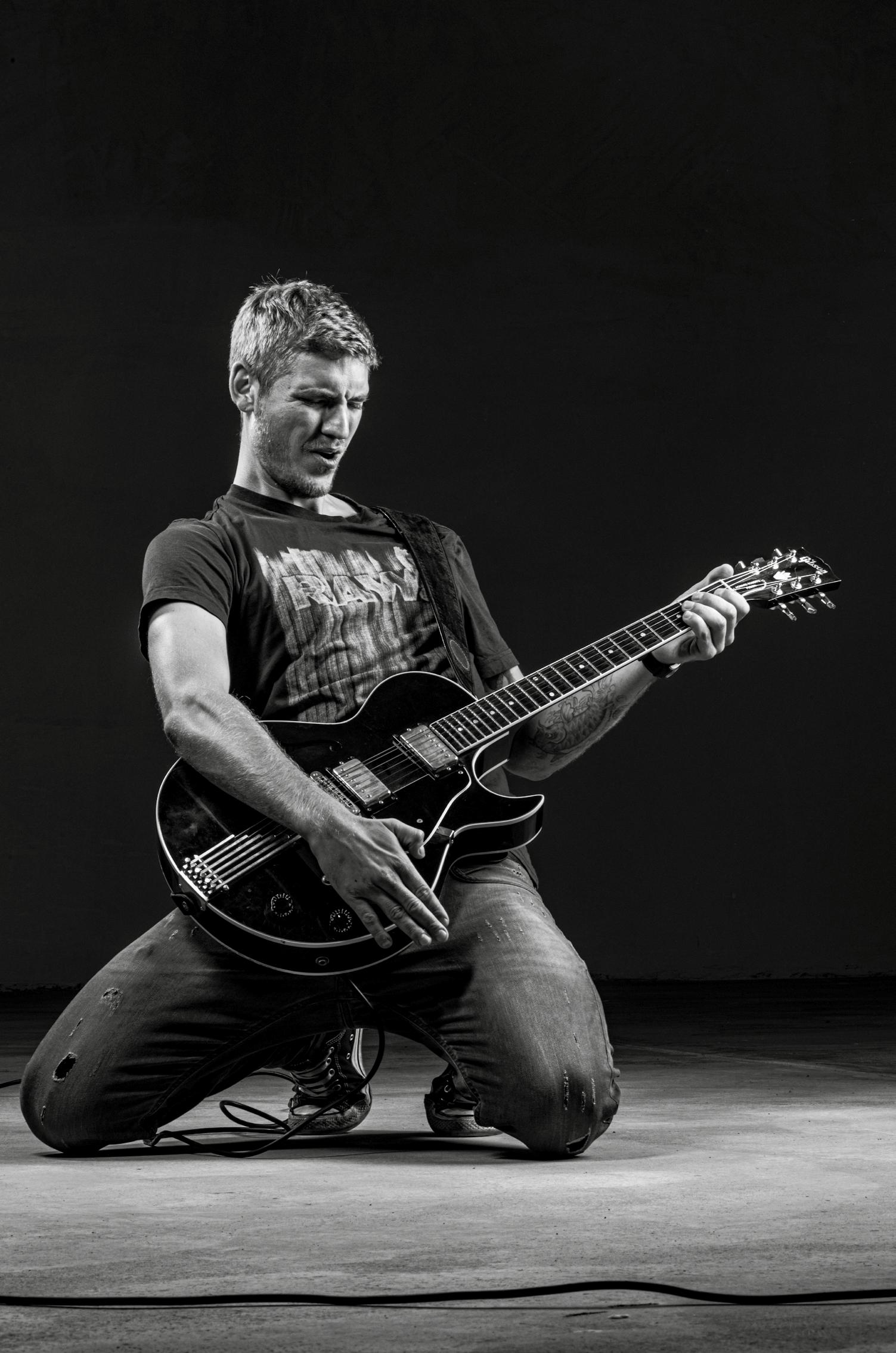
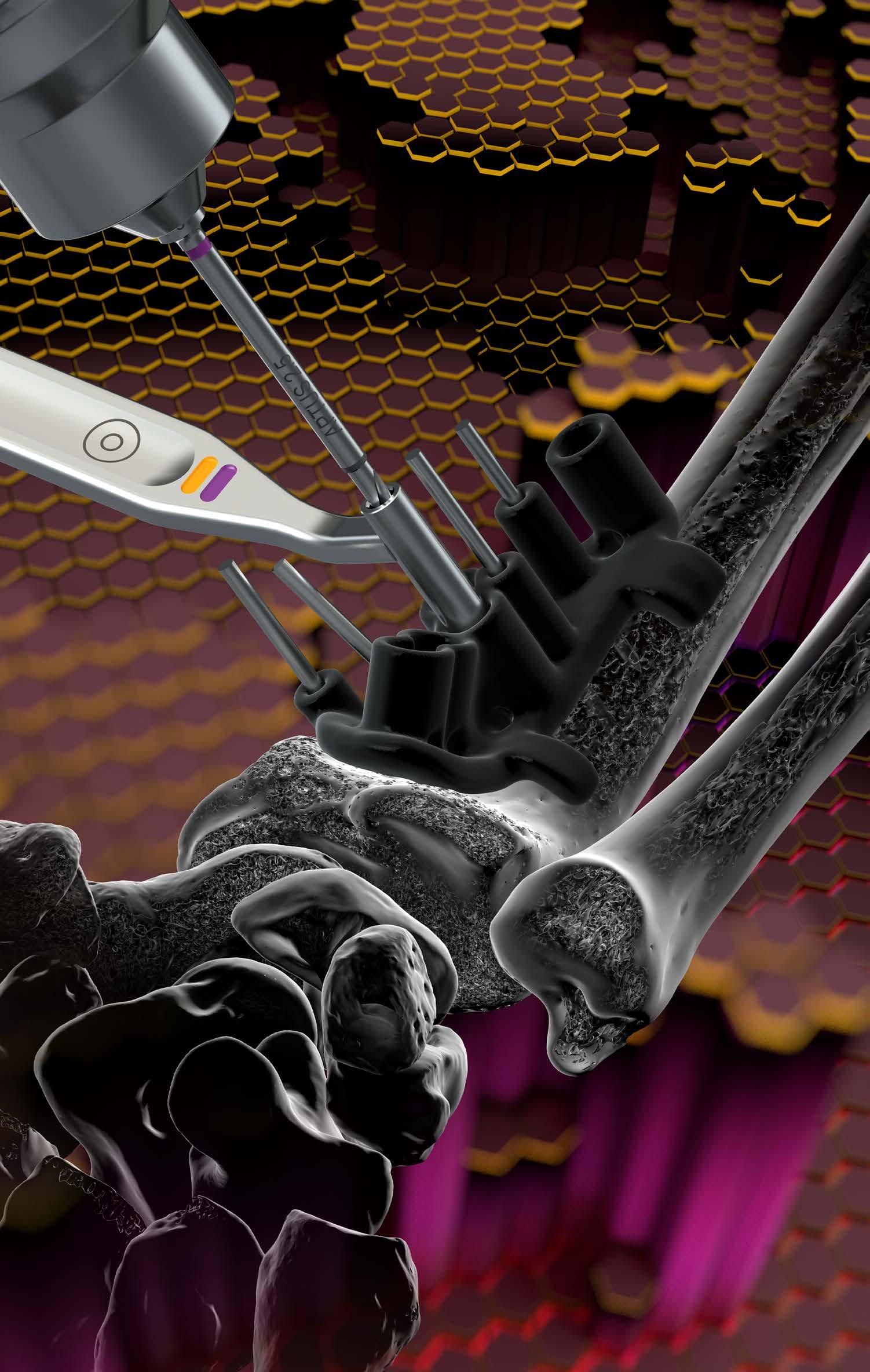
Entering new realms — Medartis dares to trade publicly on the stock exchange and changes its leading man. Then the Corona pandemic rocks the world. How will Medar tis survive the crisis?
With a determined flick of his wrist, Willi Miesch sets the clapper swinging and the cowbell ringing in the confer ence hall of the Swiss stock exchange. It is 23 March 2018, a gloomy morn ing, and the mood on the global stock markets is even gloomier. The trade war between the two superpowers, the USA and China, is to blame. In the conference hall, however, the mood is jubilant with lots of applause and vig orous handshaking. Chairman Thomas Straumann and his CEO Willi Miesch fall into each other’s arms. The chime has heralded in a new era: the former start-up Medartis is now listed on the stock exchange and belongs to the se lect few of about 200 SPI companies in Switzerland.
Nine months earlier, Medartis was on a shopping spree. On the one hand, the Swiss were looking for strategic partners and found them nearby in the Ba sel-based technology spin-off Mimedis, which was making a name for itself in the promising business area of preoperative planning and 3D printing of pa tient-specific implants. On the other hand, Medartis was taking over its long-standing distributor in Bra zil, Extera, with around 70 employees. Brazil, with its 212 million inhabitants and huge private clinics, offered great potential.
Medartis was growing and growing. As a now es tablished brand, the Basel-based company was also benefiting from a worldwide demographic change: people have been increasing in numbers and are be coming older.
In 1997, when Medartis was founded, 5.9 billion people populated the earth; in 2017, the figure was 7.5 billion. In 1997, the average life expectancy in Switzerland was 79 years and in 2017 it was 83. In short, more and more people were putting more and more strain on their bodies. As a result, more and more bones were breaking and people’s joints were becoming damaged. And with that, ultimately, the demand for surgical implants was growing.
However, this growth in the market alone was not enough to break into new spheres. After more than 20 years in business, Medartis wanted to prove its raison d’être as an independent compa ny with a future. It no longer wanted to be treated as a takeover candidate by its big competitors, but to make its own acquisitions. This external growth cost money, too much money for Medartis. There were basically two options: Ei ther find an investor who was willing to take the risks, or dare to list the com pany publicly on the stock exchange.
Thomas Straumann, Willi Miesch and Dominik El lenrieder weighed up their options. For Ellenrieder it was immediately clear: if Medartis wanted to con tinue to grow, it had to go public. Straumann and Miesch were more reserved: Straumann because he still remembered the IPO with Straumann Holding AG in 1998. “Back then I swore this would be my first and last IPO,” he recalls. Should he really be expos ing a family business that had been built up with a lot of blood, sweat and tears, to the public spotlight and subject it to countless regulations? That was a difficult decision even then. Willi Miesch’s scepti
cism had another reason: he did not see himself as the managing director of a listed company. Wasting even more time on red tape and financial analyses instead of using it for product development? Not a chance.
Straumann was the first to change his mind. After all, the IPO with Straumann had in fact proved to be a success story. Only one year after the IPO, Straumann Holding AG had increased its turnover by 35 per cent. In the USA, the turnover had risen by 53 per cent and in Asia by 70 per cent. Over the years, the stock market value of the dental implants company had increased sixty-fold. Straumann was ready to take another chance. And after a German consulting firm went over the IPO with Medartis as a dry run, Willi Miesch was also on board.
With the decision to go public in an extremely friendly market environment in 2017, the gruelling preparations began. Potential institutional investors had to be found, Miesch and Straumann started their roadshow through the financial capitals of the world, from Basel to Zurich, Geneva, Frankfurt, Paris, London, New York. Thomas Straumann, Willi Miesch, CFO Dominique Leutwyler and other members of the management team recited their company history and strategy 130 times. “Some analysts were interested in the bottom line figures, others wanted to feel the expertise and the heart and soul behind our company,” Willi Miesch recalls. Once again, it was the approachable, down-to earth manner of the Basler that did the trick. During a presentation at the five-star Park Hyatt Hotel in Zurich, a power failure forced Willi Miesch to switch over to analogue mode. He did this seamlessly, having come prepared as always with a selection of implants in his suitcase. He demon strated their use to the audience. Instead of getting into all the details, he talked about the big questions: What about the potential in the Asian market and the USA, how should the product portfolio develop in future?
After eight days, the shares that Medartis wanted to sell were already 17 times oversubscribed. Only a little more than a third of the shares went public, the rest re mained in the possession of Straumann (47.9 per cent), Ellenrieder (7.8 per cent), Miesch (6 per cent) and other employees (1.3 per cent). Back in Basel from the road show, a surprise awaited Straumann and Miesch in the Stücki Business Park: two gold and black Moto Guzzi 850Le Mans, built in 1976, which the two had dreamt about in their youth. Dominik Ellenrieder had bought the motorbikes for his friends as a thank-you gift for their commitment.
The morning of the IPO was approaching. The night be fore, the management and the Board of Directors of Me dartis had met with their financial partners, the Zürcher
Kantonalbank and the investment bank Bryan, Garnier & Co. They had been discussing the right share price until the early hours of the morning and arrived at 48 Swiss francs, which was in the middle of the price range of 44 to 54 francs. A good omen: IPO project manager Patrick Christ celebrated his 48th birthday on this very day.
Then the bell rang and the first day of trading of the Medartis share opened. How did the market assess the issue price? What did analysts think of Me dartis’s potential? At the end of the first day of trading, one Medartis share was worth just under CHF 62, the company’s market value was more than CHF 600 million, the gross proceeds from the IPO around CHF 142 million. And all this was happening at a time when stock market indices worldwide were in a decline.
The additional capital and the increased awareness through the IPO were meant to serve Medartis's growth strategy – especially in the US, where it had an annual turnover of 20 million Swiss francs. With a total turn over of 120 million francs, this was not insignificant, but not enough when considering the size of the world market, 60% of which was in the field of the extremities. But Medartis had trouble finding well-trained staff in the USA. That is why it now wanted to invest in educa tion and training, as well as in the expansion of its sales force abroad.
Another expansion target was the Asian market, es pecially China and Japan. In Japan Medartis has had a top-selling distributor for some time and had estab lished a subsidiary in Tokyo at the end of 2018 with a focus on the lower extremities. In the meantime, in Chi na, Medartis was concerned about entering the market. It would take a long time to build up a network of dis tributors in Shanghai. As a foreign med-tech company, the red tape was rather cumbersome – and the local providers, who were becoming more and more numer ous, competed with such low prices that Medartis was rethinking its strategy for China.
On 23 March 2018, all eyes were on Medartis. It was a depressing year for the stock market – the trade war between the USA and China was raging. Yet the Basel-based company dared to go public. And they were rewarded for it. The share price skyrocketed, revealing the company’s monetary value of around CHF 600 million.
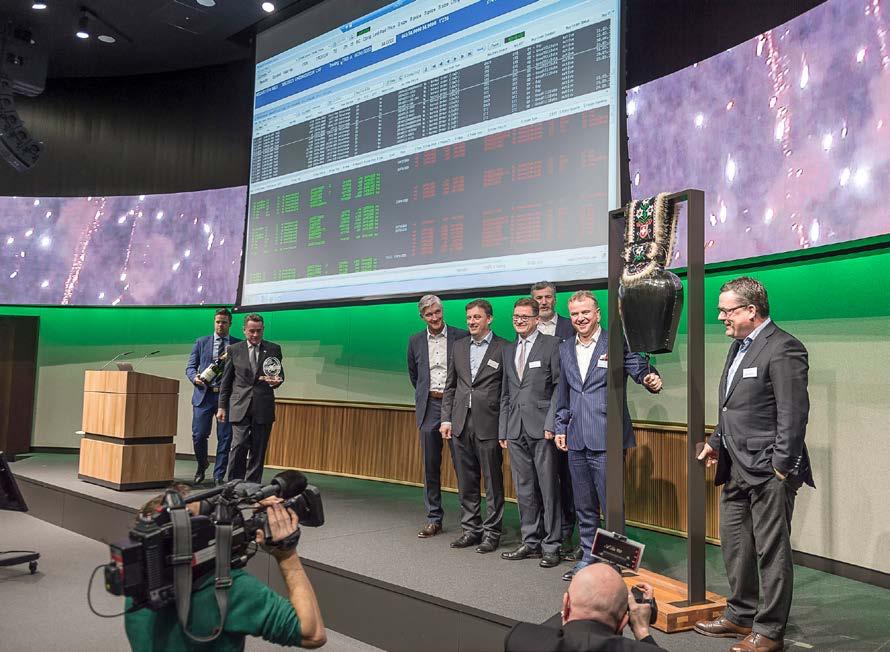
However, the money from the IPO was not only to be invested in sales, but also in the expansion of the product portfolio. This was especially true for implants for the lower extremities, as the market for foot and ankle surgery was growing at an annual rate of five to seven percent, which was faster than the general orthopaedic market. For example, Medartis was developing the All-in-One Staple, a sterilised set of staples for the treatment of hallux valgus (a deformity of the big toes).
It was also launching new systems for the upper extremity segment, for example in the shoulders. In 2020, in the lucrative business sector, hand and wrist surgery, it teamed up with the Geneva-based implant manufacturer KeriMedical. Medartis acquired a minority proportion of 30 per cent in KeriMedical, costing 10 million Swiss francs, which set new standards espe cially in the treatment of arthrosis of the hand joints. In May 2022, Medartis increases its stake to 30 per cent.
In the summer of 2019, Willi Miesch, now 55, was not only busy with the day-to-day running of the business, but was also preparing to say goodbye. He had made a decision: At the end of August, he would hand over his office as Managing Director. He had lived for Medartis for 22 years. They were
exhausting years, often with seven day working weeks. Workshops, symposia and trade fairs were often scheduled on weekends, and Willi Miesch was neither able to stay away, nor did he want to. It was precisely on these occasions that he really blossomed, in direct contact with surgeons, talk ing shop about mechanical solutions to medical problems, when he could roll up his sleeves and dig in. But the role of the CEO in a listed company was changing. Miesch knew this before the IPO – and was now drawing his conclusions.
Miesch, together with Thomas Strau mann and Dominik Ellenrieder, had already completed the hunt for a suc cessor. The choice fell on 53 year-old Christoph Brönnimann. “He comes from this region, has proven expertise as a leader in medical technology and has a calm manner,” Thomas Straumann summarises. Christoph Brönnimann is very familiar with the “American way of business” in the med-tech industry and Brönnimann, who has a doctorate in chemistry and is a graduate of the Harvard Business School, had worked for Roche in the USA from 1996 to 2001. Later he was Managing Director of Synthes Switzerland when it was taken over by Johnson & Johnson. He soon be came head of the American group’s Medical Technology Division for Germany, Austria and Switzerland. This was exactly the man whom Medartis needed now.
But then the Corona pandemic broke out. In order to minimise infections and not to overburden the health system, governments instructed their cit izens to stay at home. International travel was al most impossible, the world economy was on the back burner. SARS-CoV-2 had the world in its grip.
Medartis set up a special commission consisting of Christoph Brönnimann, Dominique Leutwyler and board member Roland Hess. They met weekly via video calls to discuss the global developments and the consequences for Medartis. They reduced working hours, streamlined costs, postponed in vestment projects. Their most important goal: to protect the company’s Achilles’ heel, i.e. production. It was impossible for the employees to do this from home offices. But without production, there would be no implants, no sales, no supplies to surgeons worldwide. To reduce the risk of infection between employees working in production, the internal task force decided that from now on work would be done in shifts and in separate teams. That is how Medar tis limited the waves of infection.
Medartis also benefited from the loca tion of its Swiss production site. It was largely independent of foreign suppli ers and the flow of goods was guaran teed. And for the most important raw material, titanium, Medartis could fall back on a richly stocked warehouse in Basel.
Medartis had to deal with the pressure on the health system. Hospitals had to prioritise Covid 19 pa tients and other medical emergencies, while elec tive, non-time-critical operations were postponed. Trauma accounts for a larger share of sales. Now even this had decreased seeing that there were fewer accidents and thus fewer surgical operations necessary due to limited mobility. In the upper ex tremities, the segment with the most trauma cas es, sales figures fell by 5 per cent in the first half of 2020. On 20 March 2020, two years after the IPO, the Medartis share was quoted at 34.95 Swiss francs.
When the first vaccine dose against Covid-19 was injected at the end of 2020, the world was filled with hope. Despite the ongoing pandemic, new regula tions, and the end of the bilateral agreements be tween Switzerland and the EU, the new year was a successful one for Medartis. Investments in the USA paid off earlier than expected and sales also grew in the Australian and most European markets thanks to new customers and new products. The fact that sales figures in 2021 were up by more than
25 per cent compared to the previous year was due in no small part to the easing of the Corona meas ures and the subsequent increase in surgical pro cedures. The share price was particularly steep: on 3 September 2021 one share was quoted at 130.40 Swiss francs and was thus the best-per forming Swiss share on the Swiss stock exchange. Christoph Brönnimann attributed this to the en couraging mid-year figures and the new investors. “Basically, Medartis has investors who believe in our growth story,” he told the financial platform cash.ch.
Marco Gadola, the long-time CEO of the Straumann Group, had by now taken over from Thomas Strau mann as Chairman of the Board of Directors at Medartis. Straumann explains his decision as follows: “We needed new ideas, new people.” As Vice-Chairman of the Board of Directors, he still took care of many things, but with a preference for keeping up with the contacts at the IBRA. He had an old friend at his side: board member Willi Miesch.
In 2022, Medartis achieved a perhaps decisive coup in the US market. The Basel-based company ac quired Nextremity Solutions Inc. in Warsaw, Indiana – the “Orthopedic Capital of the World”. Nextremity Solutions, with 87 employees, specialises in surgi cal sets and implants for the treatment of deform ities and fractures in the lower extremities, which were to complement the Medartis portfolio. Equally important was that Nextremity offered Medartis a second production site and was networked with in fluential surgeons in the US.
A quarter of a century has passed since the two best friends from their youth, Thomas Straumann and Willi Miesch, decided to try their hand at “bone lock smithing” and created a small start-up for this purpose. Over all these years, Medartis has retained its core values: down-to-earth in its dealings, flexible in its thinking, close to its customers, and precise in its production.
Important partners in the IPO.
From left: Dominique Leutwyler, CFO Medartis; Richard Schindler, Head of Capital Markets ZKB; Olivier Garnier, Managing Partner Brian, Garnier & Co.
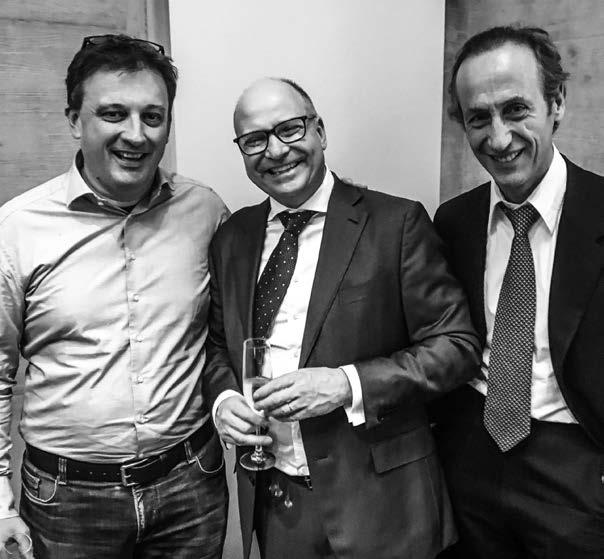
The production team made this farewell-gift for Willi Miesch.
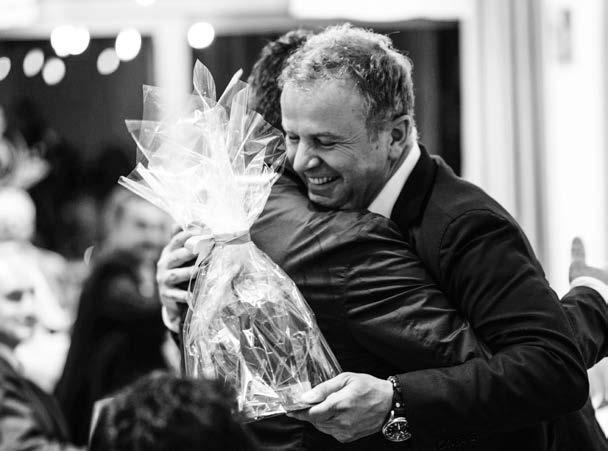
Willi Miesch steps down as CEO after 22 years of intensive work. The production staff, with whom the passionate mechanic always had a particularly good relationship, present him with a titanium globe with Medartis products screwed onto it. He is pictured here hugging his friend Thomas Straumann, who, two years later, also handed over his title of Chairman of the Board of Directors to Marco Gadola.
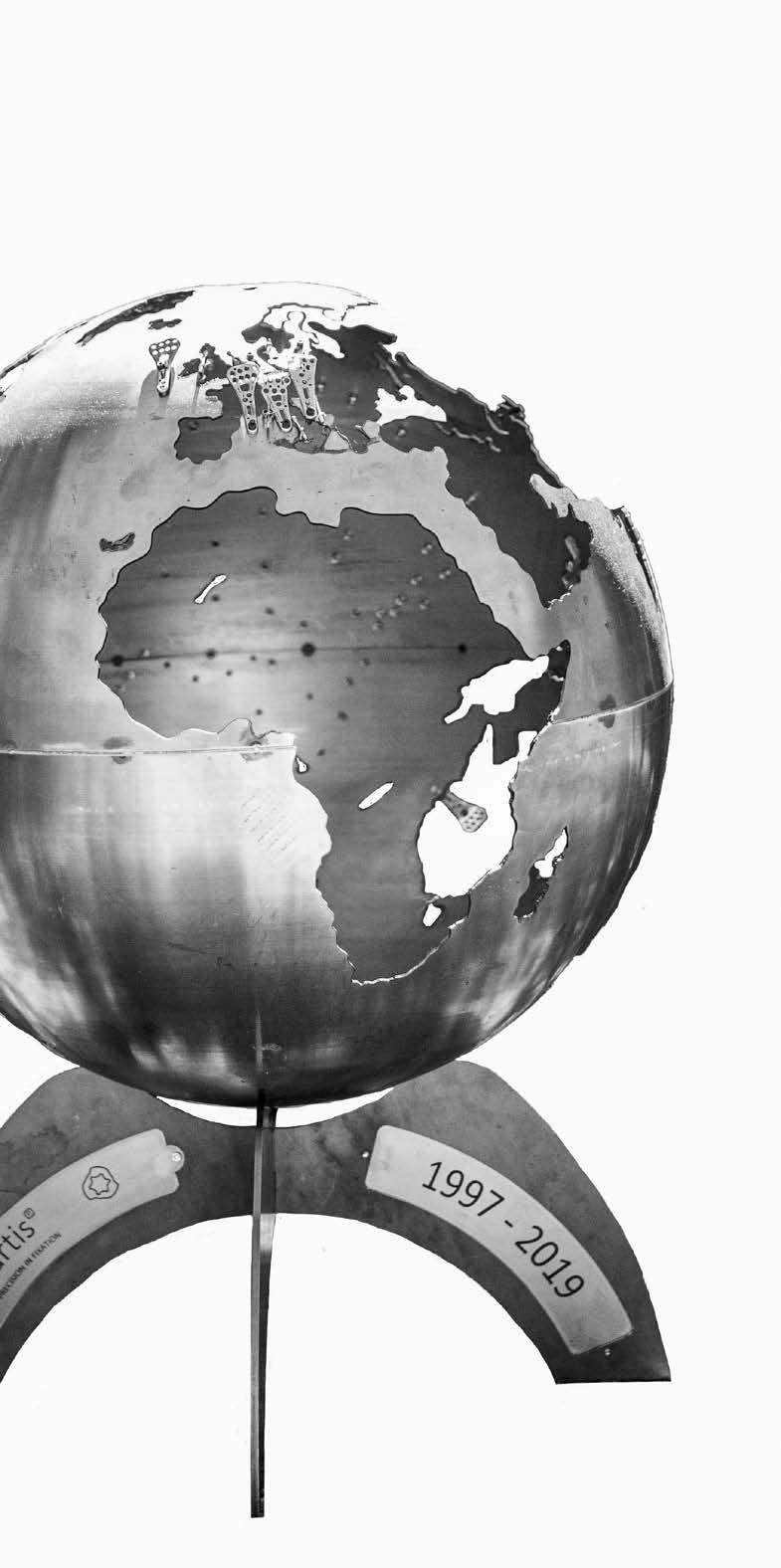
Christoph Brönnimann becomes the new CEO. Born and bred in Basel, he is the right man for the job, given his calm manner, his expertise in leadership and technical know-how, as well as his experience in the US business market.
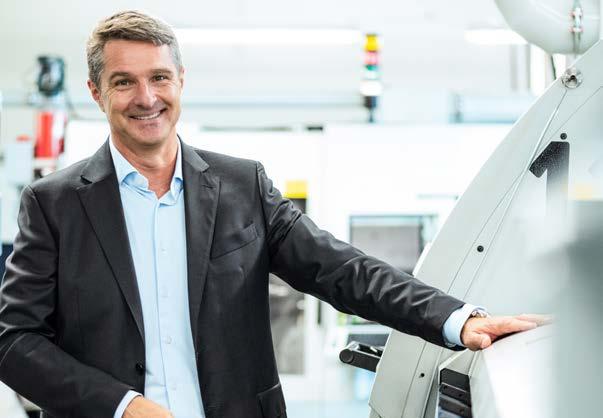
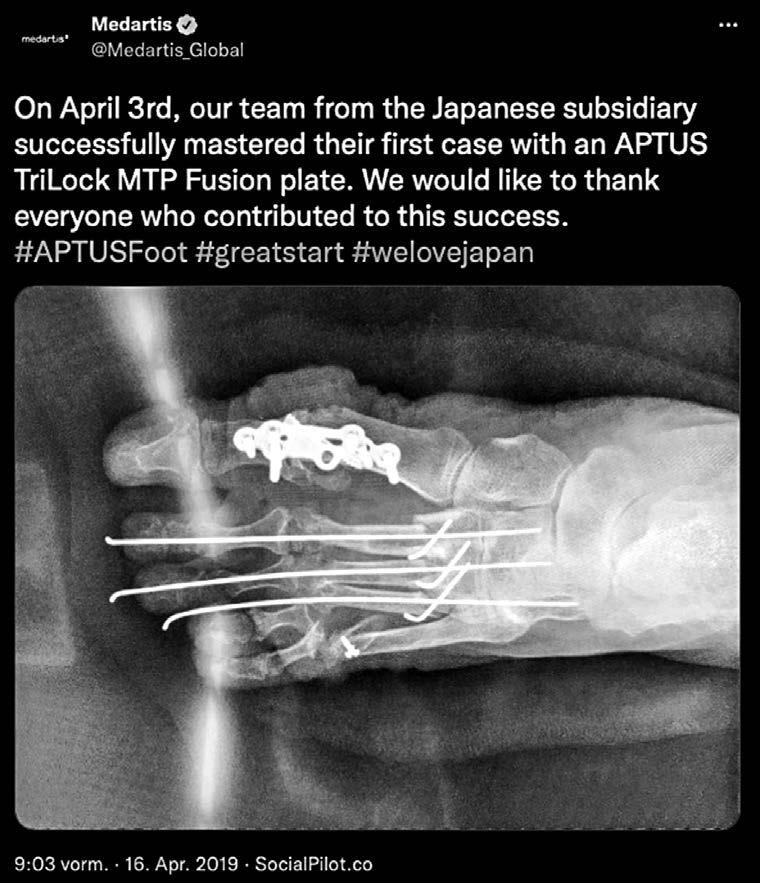
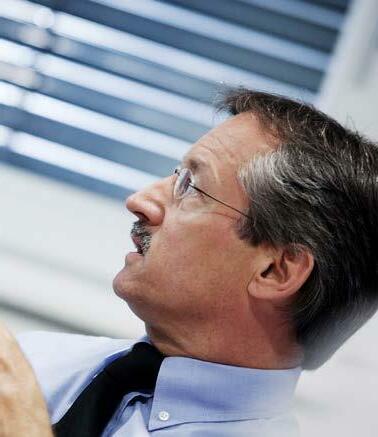
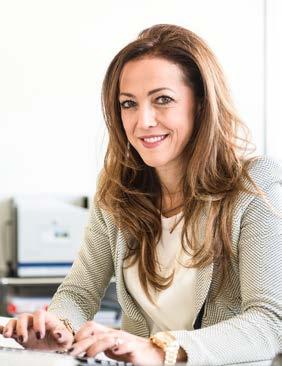
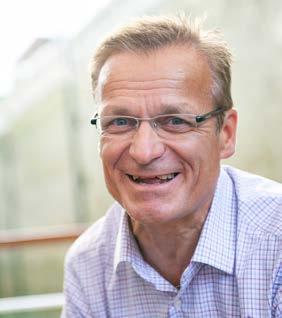
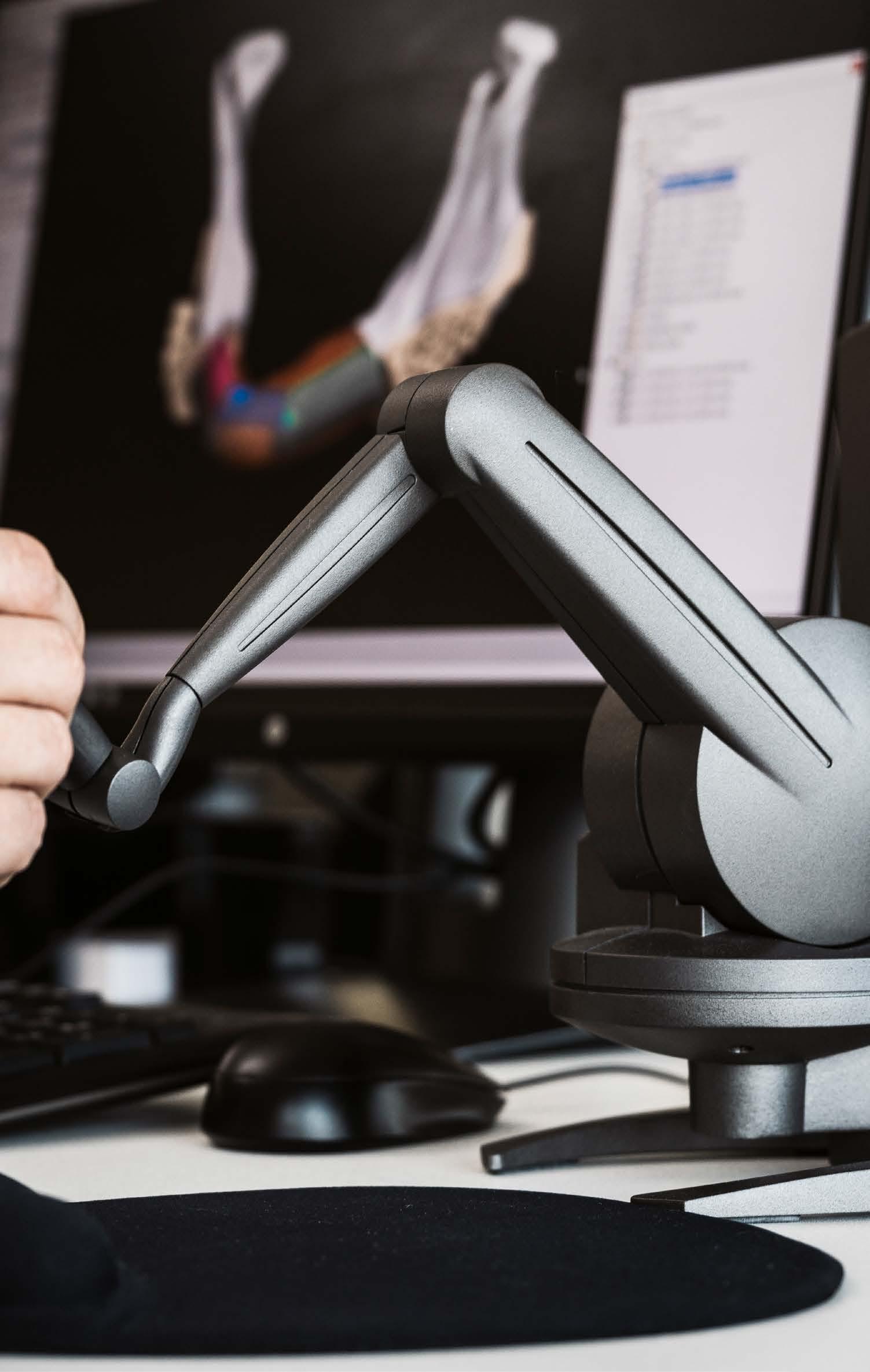
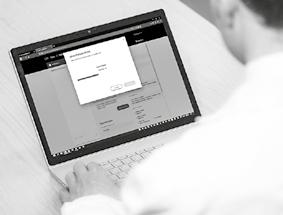
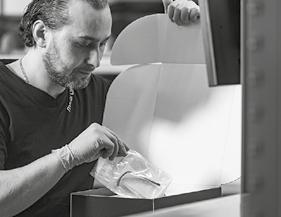
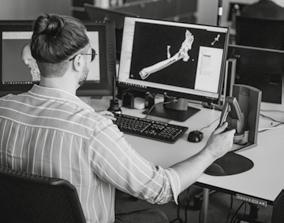
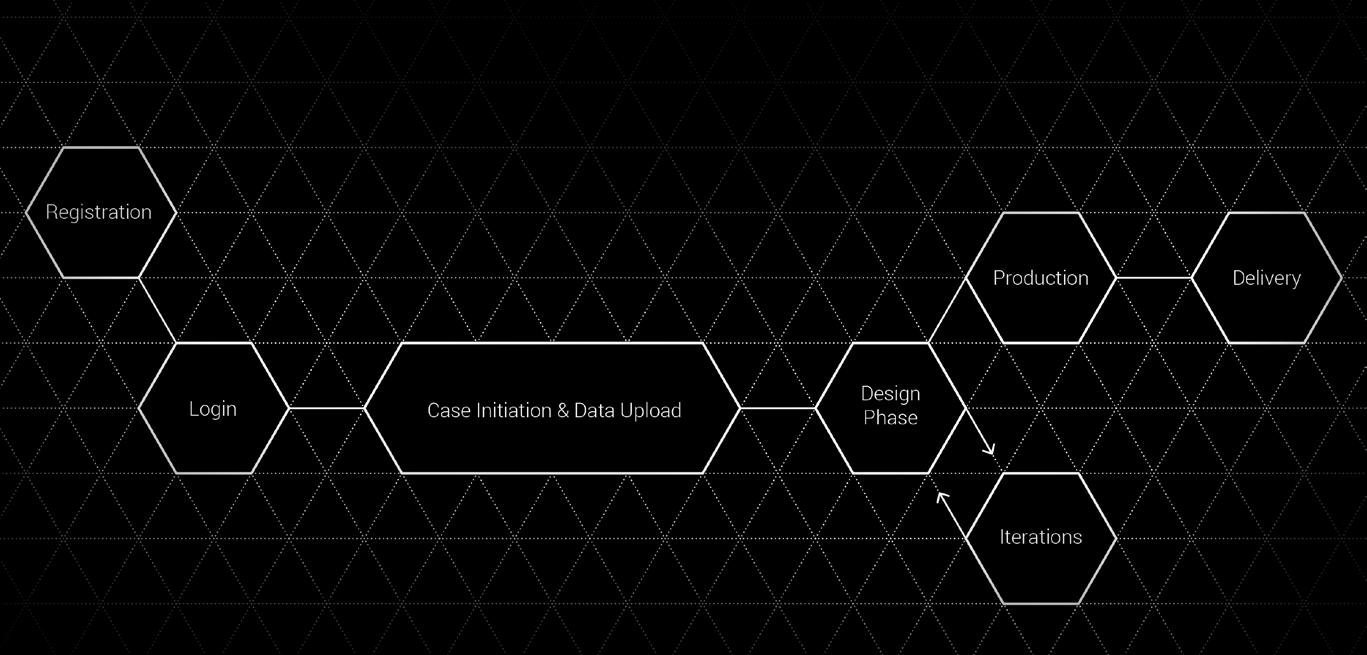
H e recalls the phone call very well. It’s the beginning of 2017.
Antonietta Fasolin, Miesch’s assistant, is on the line. He is asked to come to the Medartis headquarters at Basel-Kleinhüningen as soon as possible.
Willi Miesch wants to speak to him. Until now, it was always the other way around – he was the one wanting something from Medartis. Ralf Schumacher sensed the moment of opportunity.
Looking back: In 1998, when only one in seven Swiss people surfed the Internet every day, when smartphones did not even exist as a concept and fax machines still creaked in almost every office, Ralf Schumacher, a mechanical engineer from the Basel country side, 27 years old at the time, started working on 3D printing. That’s right.
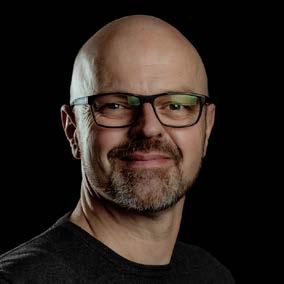
Not paper that comes out the printer, but fig ures, bodies, prototype parts. He was particu larly interested in how this technology could revolutionise medicine.
In 2006 – Schumacher was now a lecturer at the University of Applied Sciences Northwestern Switzerland (FHNW) – he was still research ing the field. He envi sioned a business model, according to which physician, as users, could participate directly in the design process of the implants. After some in-depth preclinical stud ies and the first signs of success in 2022, he presented his implants to the industry. These were patient-specific, 3-D prints. But his vision was not exactly met with enthusiasm; for many, 3D printing of implants was too expensive, too extravagant, too com
In 2017 Medartis took an important step into the digital future: with the acquisition of Mimedis, Medartis could now offer customers a digital design platform that enables the production of customised, patient-specific implants.
plicated. Medartis was no exception, as it didn’t show much interest in Schumacher’s visions.
Schumacher was not discouraged. On the contrary: he networked and founded Mimedis AG with Florian Coigny and Erik Schkommodau from the FHNW, as well as Hans-Florian Zeilhofer, the Head of Oral and Maxillofacial surgery at the Basel University Hospital. The techno logical concept became more clearly developed and got more and more credible as well as so phisticated. A computer tomograph is used to measure the bone, after which the data is pro cessed and forwarded to a 3D printer, which does not actually print at all, but rather melts together the customised implants from titanium.The tech nology was complement ed by a digital platform
that enabled physicians to help shape the design process. Through their participation, they were better prepared for their operations. And the individual plates did not have to be adjusted and bent in the operating theatre anymore. This saved time and sped up the healing process. “95 per cent of the problems can be solved conventionally. But 5 per cent are complex. They require individual solutions,” Schumacher commented in an inter view with the Sunday Newspaper. Young sur geons, in particular, soon became fans of the pre operative planning tool and the patient-specific implants. Mimedis has since gained publicity by winning several startup prizes. What was missing were investors, preferably an industrial partner with wide access to the market.
I n January 2017 Schu macher received a call from Medartis. The next day he sat down with Willi Miesch at the boardroom table. They had known each other for a long time, Miesch was very well connected and then, after all, there was that rejection a few years back. But now everything was looking
rather different. Medartis had just lost a customer because they could not offer a patient-specific solution. That had to change. Where once they were hesitant, they were now taking two steps into the future. Medartis was not only getting excited about the cus tomised implants, but also about the software
that enables the new participatory design pro cess. It wanted to build a digital ecosystem for their customers, create more points of contact.
So Mimedis became part of Medartis, which henceforth called itself “CMX”: “Creating More Experience”. 70 innovative physicians
in Germany, Austria and Switzerland were already using the still young platform – and the trend was rising.
Soon I will have been working at Medartis for half my life. I started here after my apprenticeship as a polymechanic – or rather in Bretzwil, where the first production workshop was located in 2008. Back then I had about 180 col leagues, today there are over 800. Medartis has developed massively over the years and I have grown with it. Encouraged by my boss, I was allowed to complete various professional training courses. First I became an operating technician, then a quality manager in medical technology and recently I completed my Certificate of Advanced Studies (CAS) in project management.
At the same time, I was given more and more responsibility. In 2017, I was commissioned to conduct a preliminary study, together with an external engineering firm, about an automated measuring cell. Such a cell is used in quality control by checking all the dimensional proper ties of a screw on three dimensions, down to the micro range. From a batch of 500 to 1000 screws, three to five percent, depending on the article, are sampled randomly and then measured. Since our tolerance values are very small, the measuring processes have to be extremely precise.
Measuring a screw takes about two and a half minutes. If a measure ment is out of the tolerance range, the production colleagues have to investigate the cause and, in the worst case, destroy an entire batch. Thanks to our sophisticated produc tion processes, however, this hardly ever happens.
The automated measuring cell that I was to develop with a partner com pany would enable quality control around the clock and on the week ends without the need for personnel. A high degree of automation and capacity utilisation are key factors for being able to produce economi cally and sustainably in Switzerland.
After the preliminary study, I was allowed to present my “baby” to the management. The machine, which until then had only existed on paper, would cost one and a half million Swiss francs. I was really nervous!
Shortly after the presentation, my phone rang. It was Willi Miesch, our CEO. He congratulated me and said we could build the machine. Today it’s hard to imagine quality control without it and the payback has been achieved after just two and a half years.
Kylian Jaworski (33)
is Project Manager Engineering at Medartis. He appreciates the excellent training oppor tunities, a lot of personal responsibility and a good team spirit. He even shares his favourite hobby with some of his colleagues: skydiving.
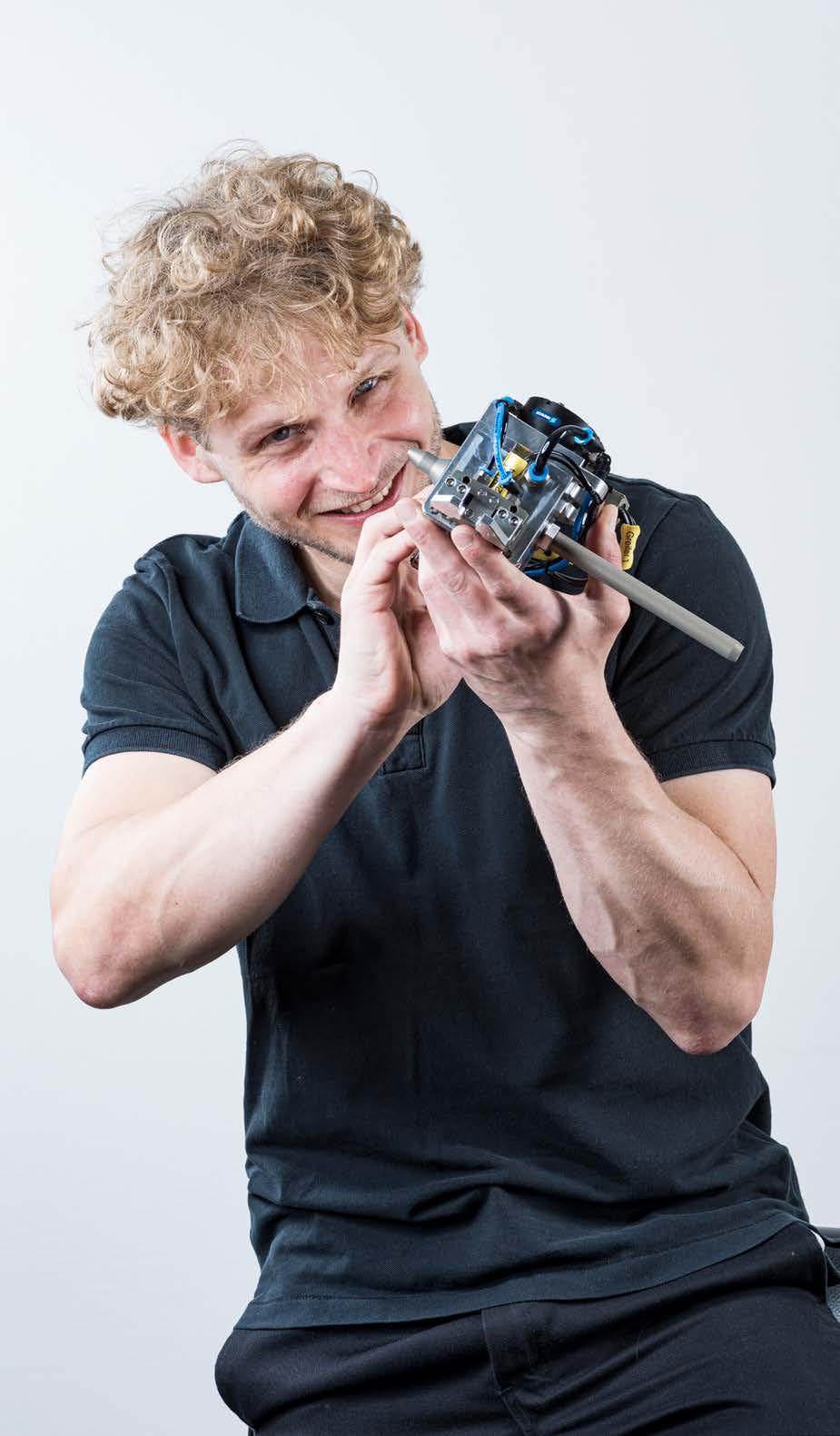
Promoting research – can be done even during Corona. The “Cadaveric Masterclass” at the digital congress of the Federation of European Societies for Surgery of the Hand (FESSH) in June was broadcast live by Medartis. A logistical tour de force.
Nextremity Solutions Inc. in Warsaw, Indiana, becomes part of Medartis. The takeover is intended to give the US business a boost, because the American market ticks differently to the European one. At last Medartis can tap into this potential.
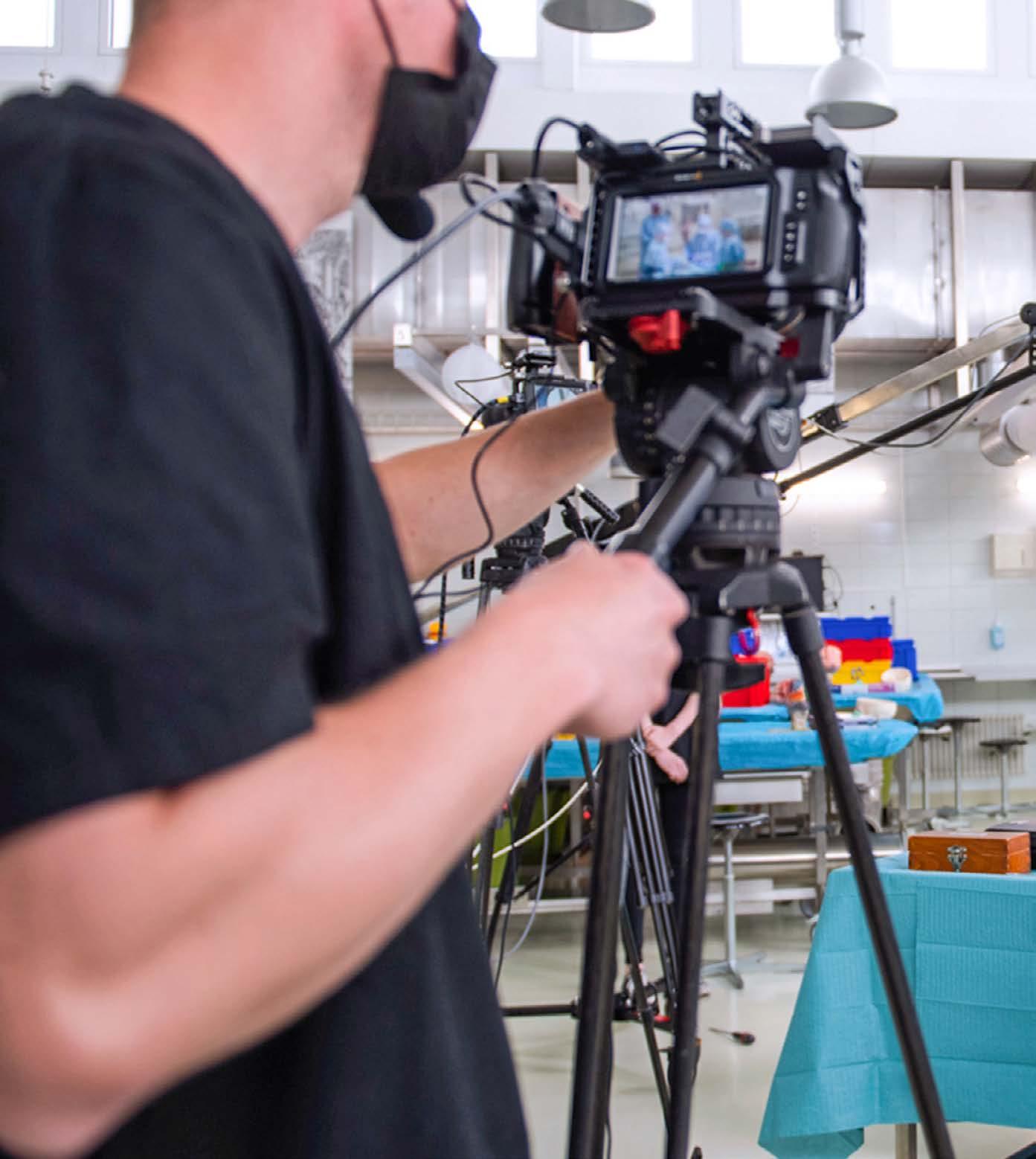
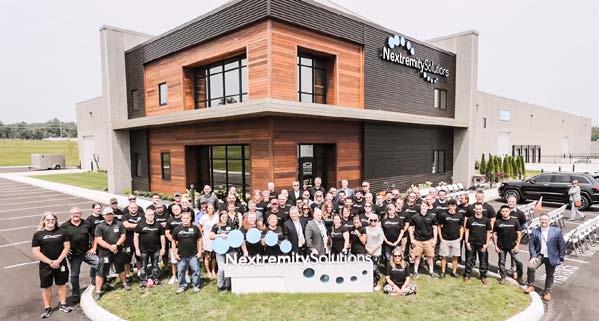
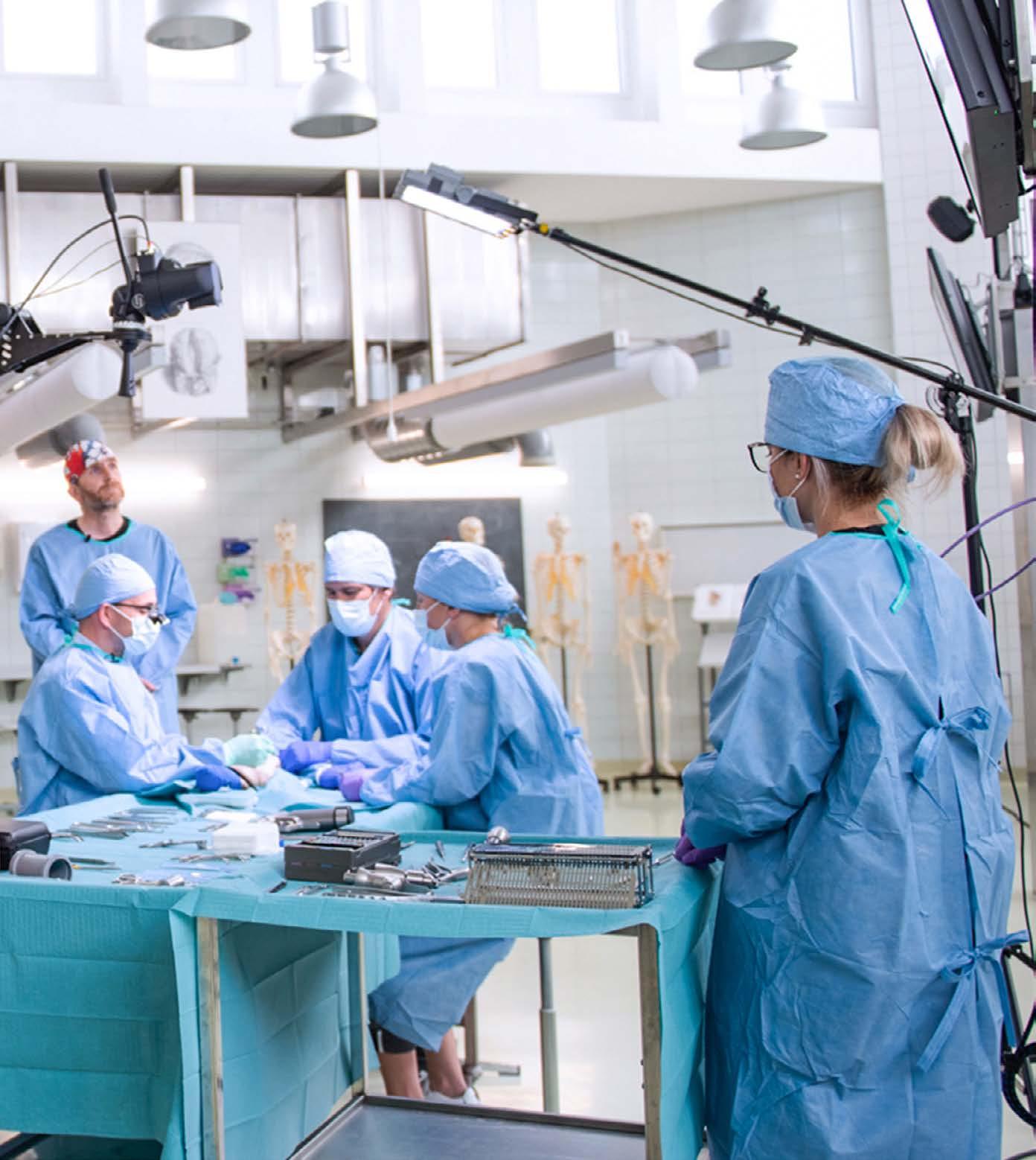
1997 Thomas Straumann founded Medartis AG at the beginning of November with his best friend from his youth Willi Miesch – shown here in a picture taken in 1985. The focus was on oral and maxillofacial surgery.
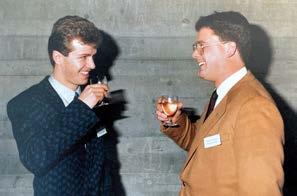
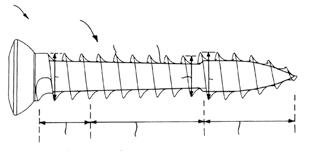
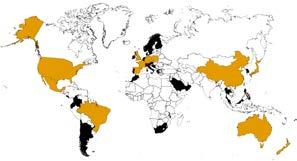
2002 Medartis presented its MODUS implant solution for the first time to an international au dience at a congress in Münster. Thomas Straumann had bought MODUS from the Swedish com pany Elekta and had it optimised by his development engineers.
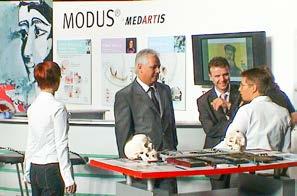
2002 Initially distributed by Straumann Holding AG, Medartis itself now took on the sale of its implants. It founded a subsidiary in Umkirch, then in Vienna, Lyon, Batley and Philadelphia. Over the years, subsidiaries followed in the most important sales markets.
2004 Together with renowned surgeons, Straumann and Mi esch founded the International Bone Research Association (IBRA) in Zurich on 25 Septem ber. Two years later, the first scientific seminar and the first general assembly (pictured) took place at the University Hospital in Bern.
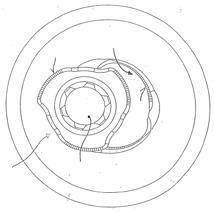
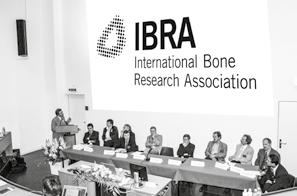
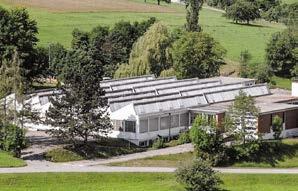
2004 TriLock was launched: the first multidirectional, angular-stable locking system of its kind. The implant solu tion APTUS, which Medartis launched in the same year for hand and wrist surgery and later for the lower extremities, is based on this technology.
2005 Medartis started its own production. A modern production facility for screws and plates was built in the empty halls of the family-owned and befriended Tschudin + Heid company in Bretzwil, Basel.
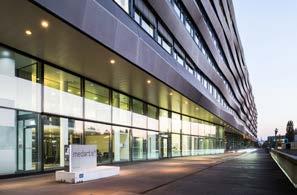
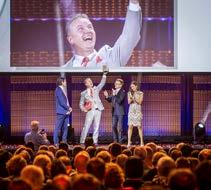
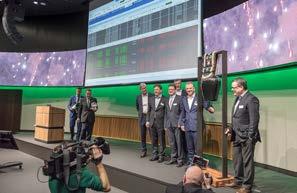
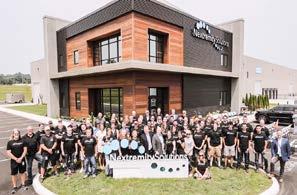
2008 Medartis launched another technology that set new stand ards in the operating theatre: SpeedTip, probably the world’s sharpest screw. Equally appreci ated by surgeons: the screw head design TypeHexaDrive, thanks to which the screw ad heres to the screwdriver.
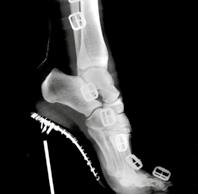
2009 Everyone under one roof: Medartis, as the first main tenant, moved into the modern Stücki Business Park in Basel’s working-class district of Kleinhüningen. Today, the Busi ness Park is home to numerous life science companies.
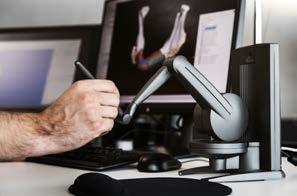
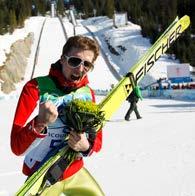
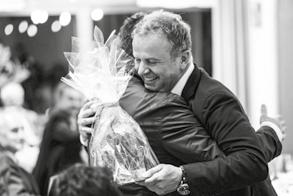
2010 Medartis expanded the range of application of its im plants to the lower extremities (foot and ankle). In the upper extremities, implants for the elbow were added.
2010 Simon Ammann flew to the Olympic gold medals number three and four in Van couver. This was also a highlight for Medartis because it had contributed significantly to the double gold win, thanks to the development of a new type of ski binding.
2015 Willi Miesch received several awards for his work at Medartis: He received the “KMU-Entrepreneur prize North West Switzerland” (2005), the “Prix SVC” (2015, picture) and the “EY Entrepreneur of the Year” award (2016).
2017 With the acquisition of the Basel-based start-up Mimedis, Medartis was preparing for the future in terms of digital case planning. In addition, it reached the turnover mark of 100 million Swiss francs for the first time.
2018 Medartis went public on 23 March 2018. With an additional 142 million in equity, the company was preparing for its next growth phase. Thomas Straumann, Dominik Ellenrieder and Willi Miesch remained the main sharehold ers.
2019 Willi Miesch stepped down as CEO. His successor is the experienced Johnson & Johnson executive Christoph Brönnimann. Shortly afterwards, Thomas Straumann handed over the Chairmanship of the Board of Directors to Marco Gadola, who has successfully led the Strau mann Group first as the CFO, and then from 2013 as the CEO.
2022 The American company Nextremity Solutions became part of Medartis. It offered a second manufacturing facility and products for the lower ex tremities, focusing on the needs of the US orthopaedic market. The acquisition paved the way for access to the world’s largest med-tech market.
From head to toe
– the Medartis
Cranium
Elbow
Hand
Foot
CMX Mandible
CMX Orthognathic
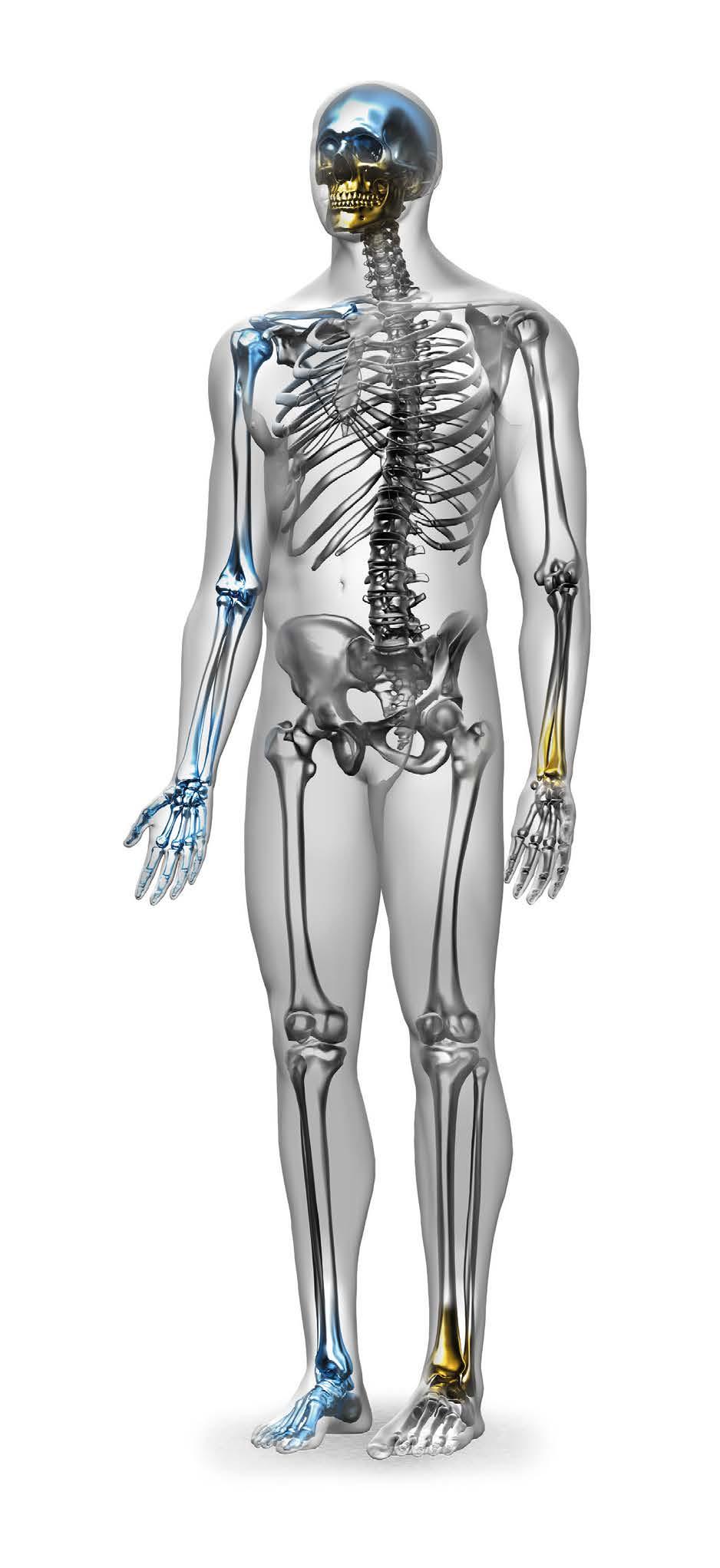
CMX Wrist
CMX Ankle
When I started working with Medartis 20 years ago, the company did not have a presence in the United States yet. At the Hospital for Special Surgery in New York, we were the first to use the Medartis Distal Radius System and the Small Fragment Set for hand fractures.
I was immediately impressed by the quality of the implants and the instruments. The system was better than anything else on the market. Word quickly got around about how good the implants were and also about the excellence of the sales staff.
I developed a close relationship with the founder Thomas Straumann and his CEO Willi Miesch and became a consultant to the company. Together with Richard Gelberman, a hand sur geon, we developed very successful modifications to the distal radius set. I participated in many courses and lectures about the treatment of various types of fractures and the results that we achieved. I am retired now and look back on these pioneering days with a great sense of satisfaction.
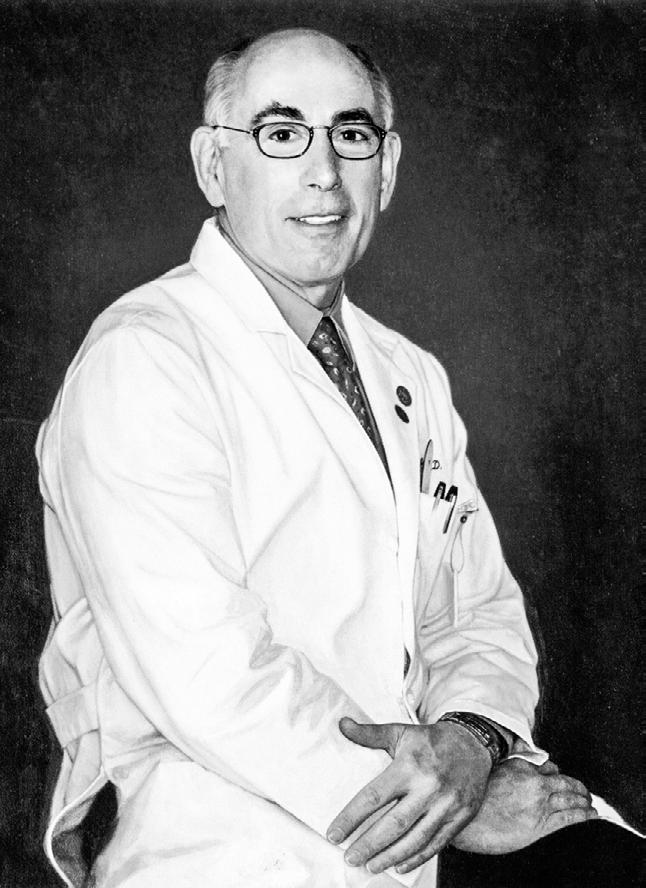
Customers and partners talk about Medartis
I still remember the first meeting with the former Medartis CEO Willi Miesch about 10 years ago. He suggested that I develop an innovative product line for feet and ankles, together with Medartis. During the follow-up discussions with him and Thomas Straumann, it quickly became clear to me that the chemistry was right and that we were pursuing the same goal. Ultimately, we must keep focusing on the patient’s well-be ing. For me as a user, first-class service and support are of course also crucial. Everything was right.
Initially, we used hand surgery tech nology and generic plates. After that, we implemented anatomical and specific plates and screws for the foot and ankle area. It has always been a great honour for me to implement this. I am still actively involved today with the goal of helping Medartis become the world market leader in my favourite discipline as well as in hand surgery.
As an academic orthopaedic surgeon and biomechanics engineer, I have spent a lot of time on research and develop ment projects. From the very beginning, working with a manufacturer like Medartis, which places high value on good engineering as well as high Swiss manufacturing quality, seemed to me like an ideal combination.
I wish Medartis much success for the next 25 years. May it continue to con sistently uphold its strong core values.
I started working with Medartis 13 years ago. At that time, I was still training to become a technical operating theatre specialist when I got to know Medartis’s user-friendly systems. The logical handling and functionality facilitated my entry into the professional field of osteosynthesis.
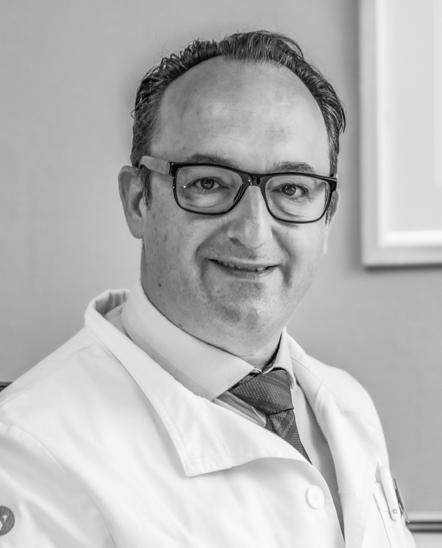
Later on, as the specialist responsible for hand surgery, I discovered that the friendly customer-care was not only orientated towards the handling of the products, but also towards the service and communication with Medartis. Whether orders are planned or urgent, the cooperation and support is always accommodating, honest and solutionoriented. As a customer, I feel valued and well advised.
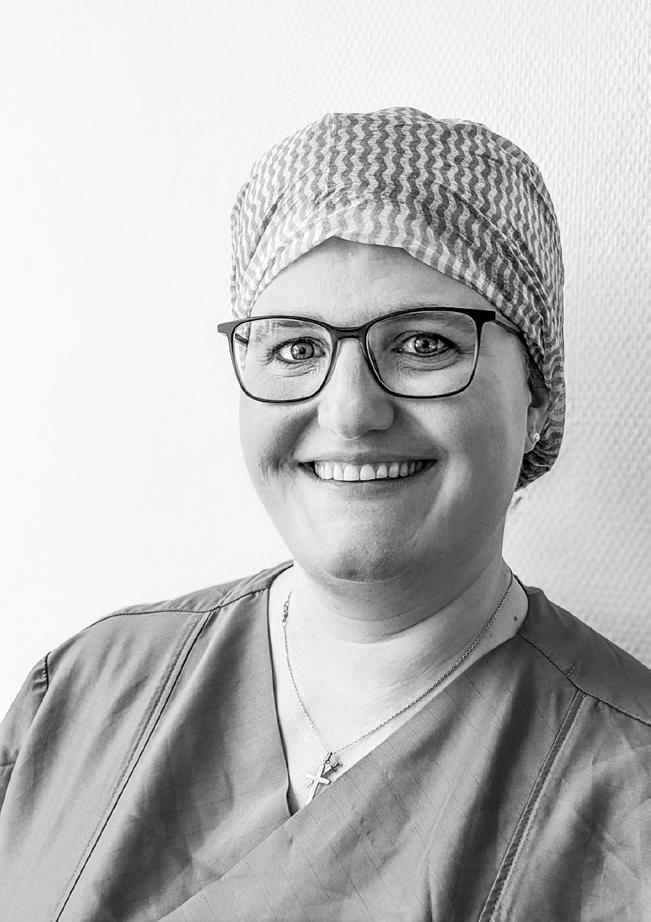
standing the theory behind the products so that I can make the best use of them.
I can find out what the design limitations are and why they haven’t incorporated all my ideas. Medartis products are very pleasant to use and are ultimately beneficial for my patients and their care. I look forward to developing the next generation of hand systems.
I have been using Medartis products since returning to Australia as a young, inexperienced orthopaedic surgeon after my first Fellowship. My first impressions were the incredible ease of use of the products and the accessibility and help fulness of the sales staff. The systems were so well labelled and presented that it was easy and efficient to instruct the nursing staff or young trainees on how to use them intra-operatively. The in struments allow one to use the products really easily. The company’s support staff is accessible, knowledgeable about their products and incredibly helpful, even when I ask the same questions over and over again (sorry, Jason Brown!).
Over the past decade, the products have evolved along with my practice, with new and exciting additions to the portfolio, filling gaps and completing my operations. It is great to see how the company strives to develop its products.
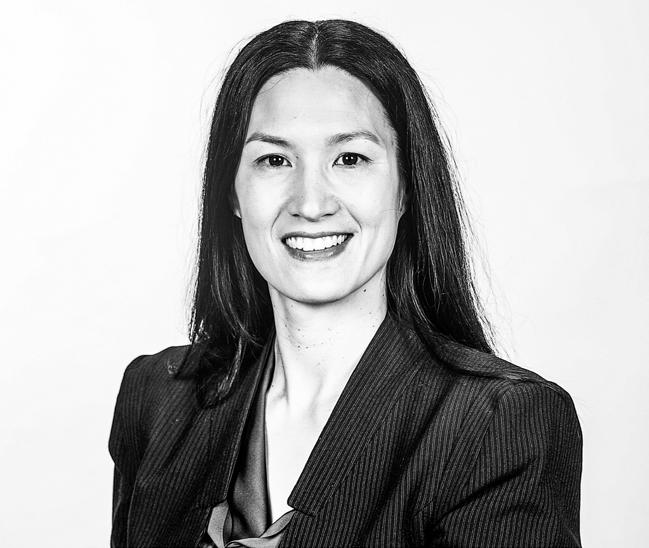
The representatives are always responsive to feedback, to my ideas and suggestions, which they pass on to their engineers for consideration, especially to Matthias Walter. Matthias’s visits to Australia are very helpful for under
As a surgeon, I am responsible for my patients every day in terms of their safety and consistently high-quality treatment. To achieve these goals, I need reliable partners.
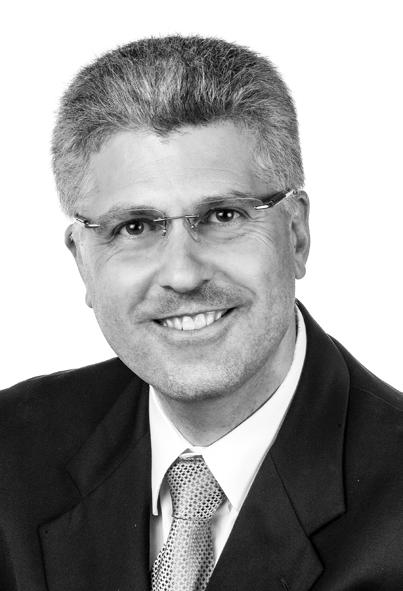
The company Medartis, with which I have been associated and have been cooperating since its foundation, delivers in the areas of product quality, reliability and innovation. So far, I have never been disappointed, neither by any of the company’s products, nor by its service quality, and I experience innovative im plementation of technical and logistical solutions every day.
I wish to continue, above all, with the cooperation between Medartis and myself in the future, which has been so very successful thus far.
For the treatment of deformities, malpo sitions or bone tumors, patient-specific templates and osteosynthesis systems are needed to perfectly restore anatomy and function. These templates are used intra-operatively to enable high preci sion during the surgery and contribute to shorter operating times in the theatre. From the beginning, we worked with Ralf Schumacher of CMX, who was an early supporter of innovative surgeons and understood their needs before the era of medical additive manufacturing. This fruitful collaboration led to success ful projects and rapid implementation of research results from the lab to manu facturing.
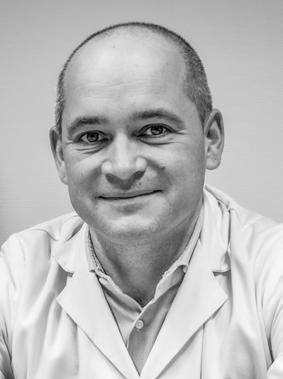
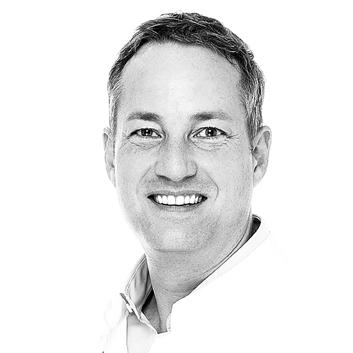
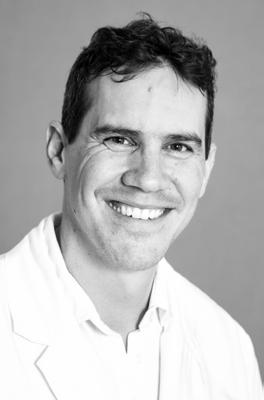
Reliable business partners are of great strategic importance, and this is one of the main reasons for maintaining a relationship of more than 20 years with Medartis. In this team we have an ally of dedicated people who know and understand our needs as distributors. In addition, it is worth noting that their products are innovative and of the hig hest quality, a fundamental requirement for helping to improve the quality of life of our patients. For 20 years we have experienced constant growth in Colom bia, which today makes us an important commercial agent in the health sector, thanks to this great alliance.
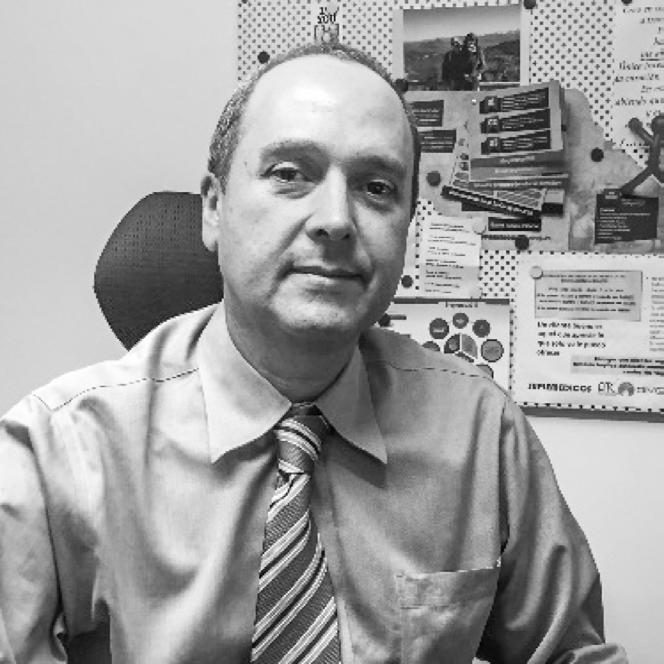
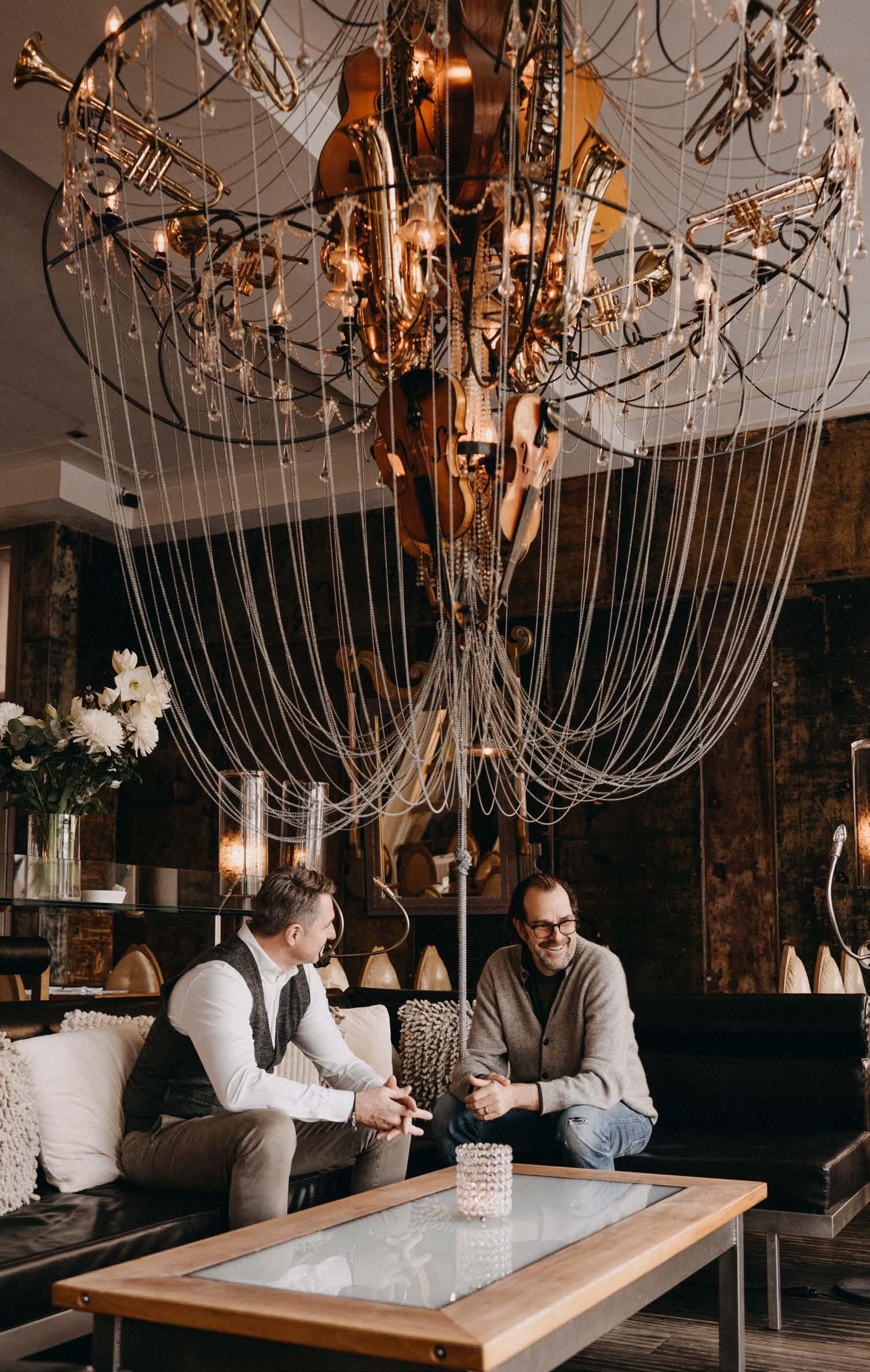
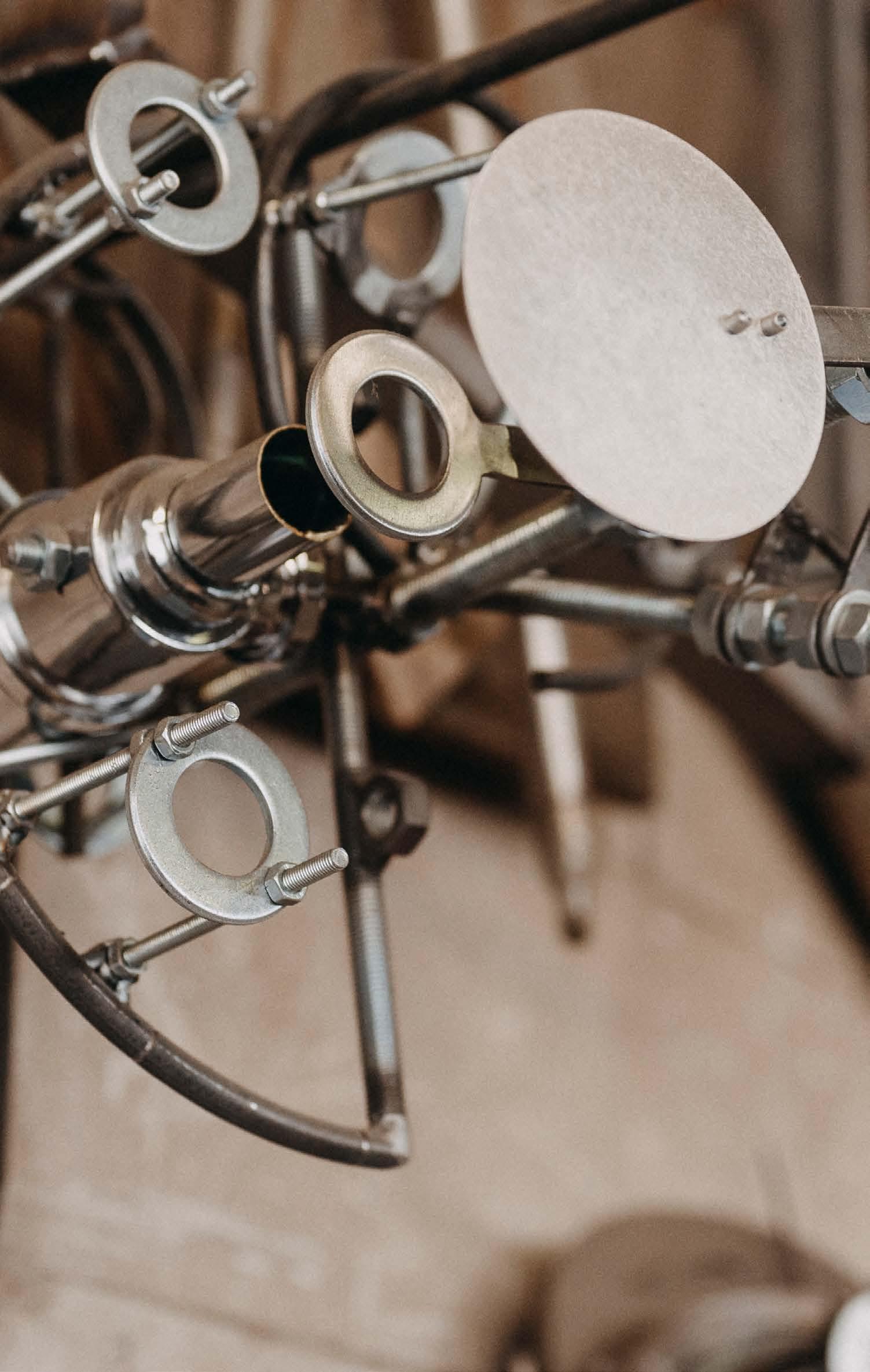
How does creativity come about? Why do we need visions? And how can a business be developed from it? At the foot of the Matterhorn, Medartis CEO Christoph Brönnimann meets artist, visionary and hotelier Heinz Julen from Zermatt, Valais.
video
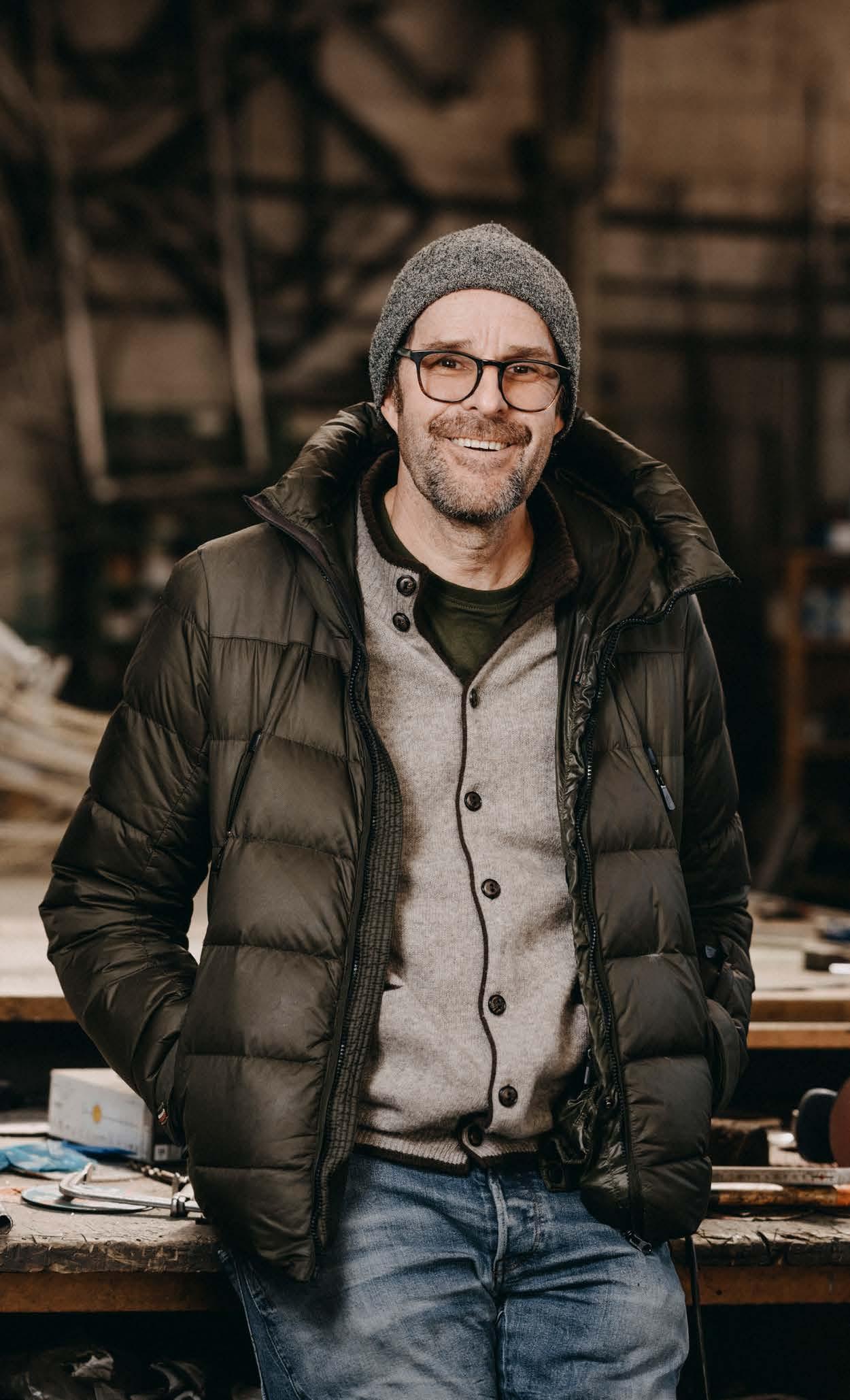
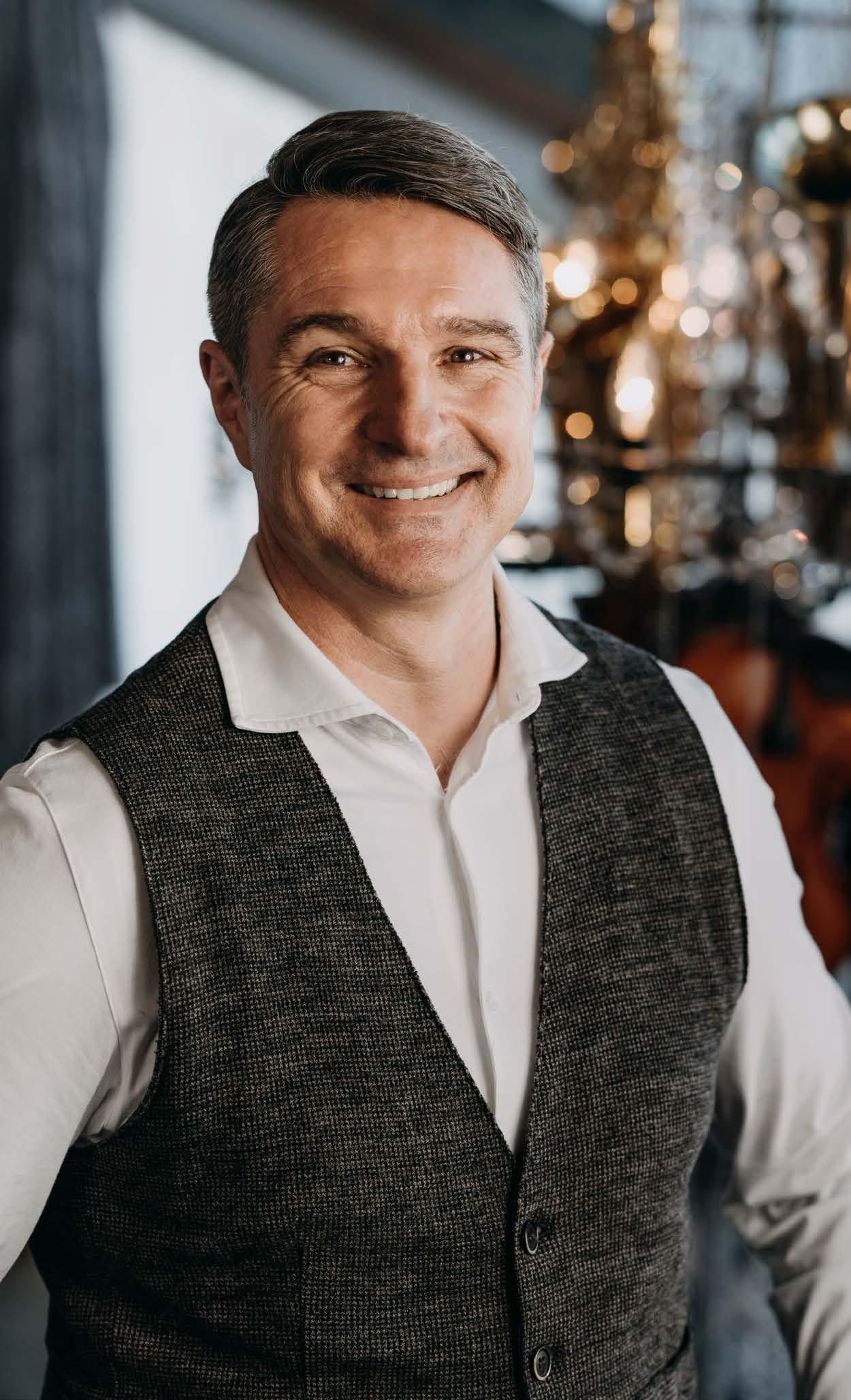
Heinz Julen Let’s be on first name basis, I’m Heinz.
B Thank you, I am Christoph.
J What made you think of coming here to meet me? We hardly know each other, or do we?
B I know you better than you know me. In 1981, when I was 15, I moved from Basel to Visp with my family, where my father ran the Lonza plant. Since then, I’ve regularly visited Zermatt and of course I’ve seen what you’ve built up here. We are almost the same age. First of all, you created quite a stir as an artist, then you or ganised concerts, opened the legendary “Vernis sage” in 1991 and co-initiated the music festival “Zermatt Unplugged” in 2007. This creativity, power and energy interest me. I’ve wanted to talk to you about it for a long time.
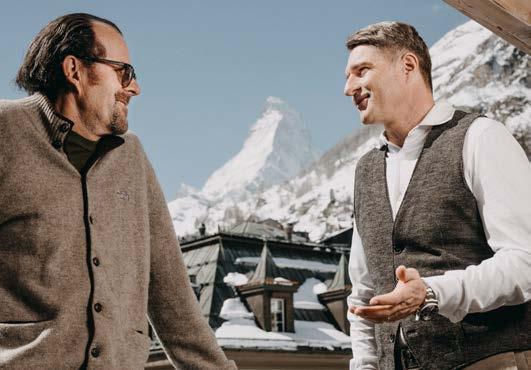
Two biographies, one place: Zermatt, the world-famous town at the foot of the Matterhorn, where Heinz Julen grew up as the youngest member of an old-established family. The family still had cattle and spent the summer in the Alps in Findeln, where his parents also ran a restaurant. Heinz Julen spent the summers of his childhood with his
parents and three sisters in the Alps, surrounded by a dozen four-thousandmetre peaks, tourists who travelled from afar, frugal Simmental cows and lush pastures.
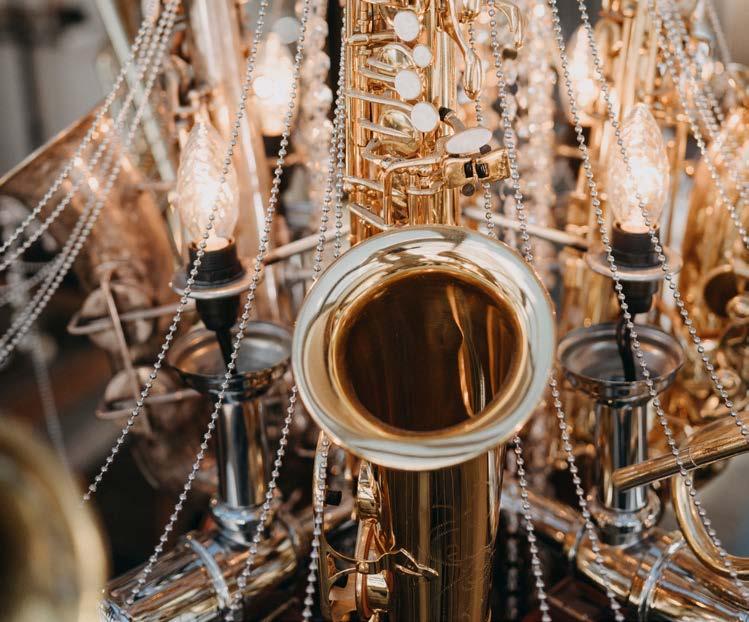
B Here in the lobby of your Backstage Hotel, almost every chair, every lamp, every picture and the architecture as a whole is yours. Where do you get your creativity from?
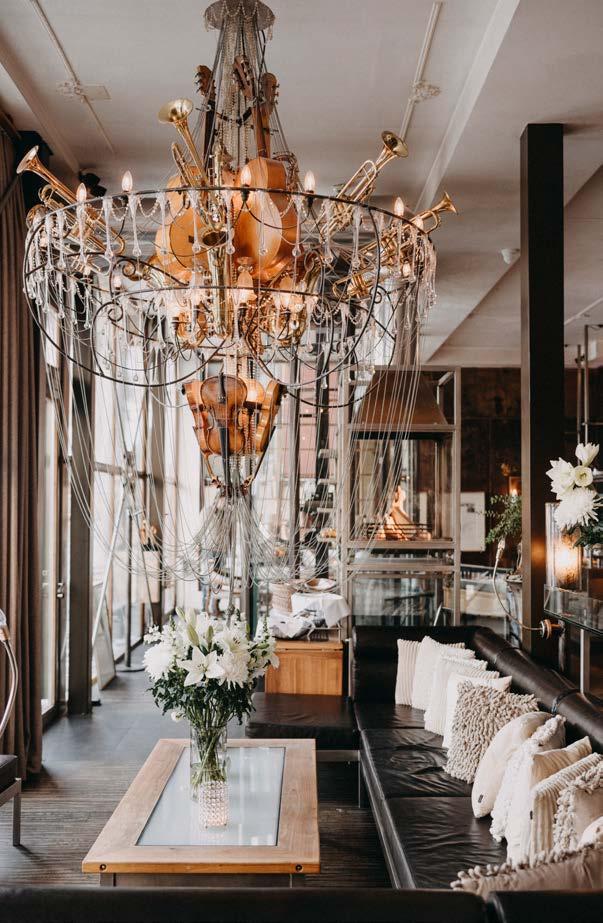
J Some people think you are born creative. Whether that is true or not, I can only say that I was often alone as a boy. My parents worked a lot and my sisters and I had to help out. But we also had a lot of free time and I didn’t have any playmates. My three sisters had other play interests and they had each other. So I let my im agination run wild, built little huts out of grasses, cloths and old wood, and decorated them inside with objects made of old cutlery, cow horns or other things that I found.
B Does creativity come from being alone?
J For me, creativity is a process that must work its way from the inside out. It is about a journey towards finding oneself, maybe even to love oneself. Whitney Houston sang, “Learn ing to love yourself, is the greatest love of all.” But when the artwork is finished, it needs to be shared and communicated. That’s why I was never just an artist, but also an exhibitor, a host, an organiser.
Heinz Julen is not without controversy in Zermatt. Even as an artist, he caused a stir in the early 1990s with his “house of altars” – installations that combined everyday objects with sculptures of Jesus. In Zermatt, where most people are Catholic, many saw this as blasphemy. “Art shock from the Valais” was the headline of the Blick Newspaper. A village fountain, designed by Julen and called “Abundance” was demolished by unknown persons in a night and fog action. Later, Julen would continue to argue with municipal representatives, building regulatory bodies and cultural commissions about details in legal para graphs, permits and subsidies.
B Every vision provokes resistance. How do you deal with that?
J My driving force has never been provoca tion, but a childlike naivety: the will to discover the world anew. I start with a situation or a need and create a solution for it: a chair, a lamp, a bed, a room, a piece of architecture. I try to think out side the norms and therefore often get on the wrong side of them.
B Standards and laws also play an important role at Medartis. For me, the attraction lies in finding creative solutions within these regulato ry boundaries and thus pushing the standards to the limit. But I agree with you: at the beginning of a creative process, the mind and spirit should be free – until they reach the limits of what is doable.
J Sometimes it’s worth breaking through the boundaries, which can also be the boundaries in the mind. Let me give you an example: At one point our consultant in the gourmet restaurant “After Seven” came to me and said: “The break fast room here on the first floor is so beautiful, why can’t we use it for the restaurant in the evening? For logistical and economic reasons, this suggestion was nonsense, because the kitchen upstairs was much too small for the res taurant business. But then we thought about it some more and considered how it could work: The chefs would prepare the “mise en place” in the large kitchen on the second basement floor and transport the prepared dishes by lift to the first floor in the late afternoon, where the dishes would later be completed and served. Against all reason, we implemented this, and it created a whole new set of possibilities: Aromas flowed through the house, the guests met the chefs in the lift, and, with a bit of luck, they got to sample a bite off the platters. This gave them the feel ing of being “backstage” in our star restaurant, which in turn fits perfectly with our hotel con cept. Sometimes little treasures are hidden in the uneconomical.
B But it all started out with a simple problem: a beautiful room with a kitchen that was too small. For us, such problems arise from visiting
leading physicians and operating theatre staff around the world to watch them do their work. What medical problems are unsolved? How do we come up with new solutions? Sometimes it helps to think outside the box, to leave the op erating theatre and the prototype workshop and to visit a construction fair, for example. There, our engineers explore the latest trends on topics such as fixation or drilling. Then we perfect the ideas and adapt them to create medical tech nology.
J Does Medartis provide any room at all for “uneconomical” processes?
B Yes, of course. In product development, there has to be the freedom to tread completely new paths, and to take the risk of failure. This is done according to the principle of trial and error. Sometimes you go one step forward and two steps back. Production, on the other hand, is completely different. There you have to focus everything on profitability at the Swiss location and that means high capacity utilisation, auto mation and high quality output with low wast age. To achieve this, innovations are constantly needed: for example, we have developed an au tomated measuring cell that uses robotic tech nology to check the proportions of our screws across all dimensions and this allows us to carry out quality control 24/7.
In October 1990, Heinz Julen’s parents’ house on Zermatt’s village square burnt down. In the basement of the ruined build ing, Heinz Julen opened the “Vernissage” in 1991 at the age of 27, a club with cult status that has hosted hundreds of concerts, exhibitions, parties and cinema screenings to date. It was the beginning of a cultural turning point in Zermatt.
B Speaking of profitability – today you are no longer just an unconventional artist, but also the father of three children and an entrepreneur with over 70 employees. Did you find the transi tion to entrepreneurship easy?
J Yes and no. Yes, because I like being a host, which is only possible with employees. No, be cause I had a hard time with numbers and busi ness plans. I first had to learn that in order to manage a space sustainably, it must be profit able. Nevertheless, I would still say that in the beginning, the vision, rather than any economic considerations, should be foregrounded.
B What is your vision?
J I want to put Zermatt on the cultural map, or – as the journalist Mark van Huisseling once wrote – to “animate” it with art and culture. With the “Vernissage” I was in the red for years. But then things started to look up, and not only did I benefit from that, but Zermatt did too. The Zermatt Unplugged Festival began here at the Vernissage. Since then, hundreds of interna tional stars have come to the mountain village – not least, by the way, visual artists! It is a small
sensation that Peter Doig, who is one of the most sought-after international artists, is exhib iting here in Zermatt and not only in New York, London or Zurich.
B This is an interesting parallel to Medartis’s development. Thomas Straumann, the founder of Medartis, also needed a lot of staying pow er and perseverance to see his vision through. Nobody wanted to give him credit at the begin ning, and the competition seemed overwhelm ing. For 15 years, Medartis invested heavily in its growth and made losses. Nevertheless, Thomas Straumann fully trusted his friend and CEO Willi Miesch and the Medartis team, until the prod ucts became established thanks to their inno vative technologies, precision and new fields of application.
J What was Mr Straumann’s vision?
B The same one that still drives us today: As a leader in innovation, Medartis develops cutting-edge technology and solutions for os teosynthesis to provide optimal treatment for patients with complex fractures or deformities of the head, hand and foot. I suspect that there was another, very personal factor that has driv en Mr Straumann: In founding Medartis, he has returned to a business area that his father had started in the early 1970s and that was sold af ter his death. So Medartis in a way is a contin uation of a family tradition that has firmly an chored the company’s DNA to this day.
J I also see myself following in the tradition of my father. He was a farmer, restauranteur, mountain guide, cable car owner, ski school owner and a filmmaker – a self-made man, just like me. He believed in me, even when it came to choosing a career. I didn’t want to do a tradi tional apprenticeship, I wanted to become a ski instructor and a mountain guide or follow my ar tistic talents. Trust is an important prerequisite for creativity – on the one hand in oneself, on the other hand in the environment.
Unlike Heinz Julen, who did not opt for a traditional qualification like an appren ticeship, Christoph Brönnimann’s CV is full of accolades. Christoph Brönnimann wrote his Matura at the Kollegium Spiri tus Sanctus in Brig, studied chemistry at the ETH Zurich, served in the elite unit of the Swiss army up to the rank of com pany commander and, on the side, also played handball in the top Swiss league.
J How did your parents influence you?
B It’s certainly no coincidence that I stud ied chemistry like my father and worked in the pharmaceutical industry for a long time. He also taught me from an early age to take on leader ship roles. Especially in handball, I learned later how important it is to have a vision, to set high goals and to find ways of achieving them as a team. Only together could we hold our own in in ternational competitions against higher ranked teams. It is the same at Medartis: alone I can
only achieve so much. Every single employee is important and makes a significant contribution. So leadership also means sharing knowledge and visions. It would be risky if the company were too dependent on just one individual. That might distinguish us from a company with the brand “Heinz Julen”.
J My company is indeed very dependent on me. That makes it difficult to pass it on at some point. I find that thought disturbing at times.
Focussing only on the successes, every career reads like a story about a stairway to higher places. In the process, it is often forgotten that crises and failures also play a decisive role in shaping someone’s personal course in life. At the end of the 1990s, Julen and a partner planned their biggest project ever: the 40-million-franc “Into the Hotel”. The idea behind the partnership: Julen would provide the land, the concept, the architecture, the furniture; and the partners – a Bernese industrialist family – the necessary funds. And indeed, here, above Zermatt, a premi um boutique hotel was being constructed, with meditation rooms made of black marble, beds that could align themselves with the sun, with places for quiet con templation amidst granite stones. The hotel was open for seven weeks in 2000 – even Robbie Williams is said to have been there. Then Julen and his partners had a fall-out. Not only did they send a fleet of bulldozers, but they also confront ed Julen with a 12-million-Euro lawsuit. The hotel was closed, and Julen’s life work was brought down by a demolition crew.
In the same year, Christoph Brönnimann started working for the prestigious con sulting firm Arthur Andersen. A year later, the firm attracted the attention of the US justice system in the wake of the Enron scandal because of falsified balance sheets. Enron was dissolved in 2001 and Arthur Andersen’s firm in 2002. Chris toph Brönnimann never had anything to do with the client Enron, but the scandal cast its shadow – even on uninvolved people like Brönnimann. After working for PWC, Synthes, DePuy Synthes and Johnson & Johnson, in 2019 he was look ing for a new challenge. He wanted to get out of the world of large corporations. One option was to manage the huts provided by the Swiss Alpine Club (SAC). But then Medartis came knocking on his door.
Back then, it was still manageable to get a grip on Medartis, while also being highly innovative. Medartis wanted to take a leap into the next growth phase, together with Christoph Brönnimann. This, too, became an adventure and continues to be one, until today.
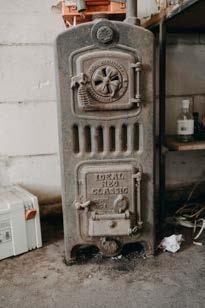
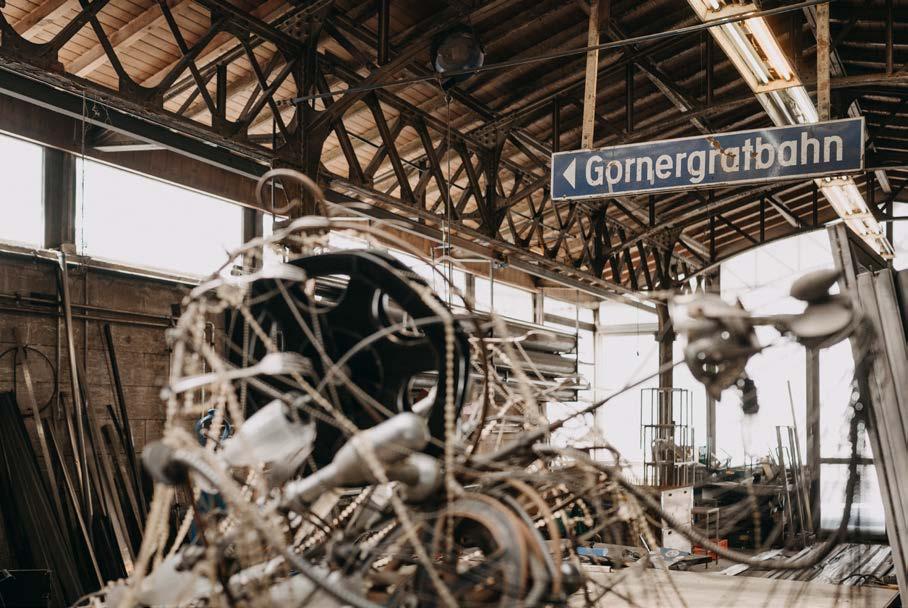
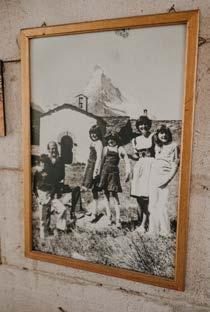
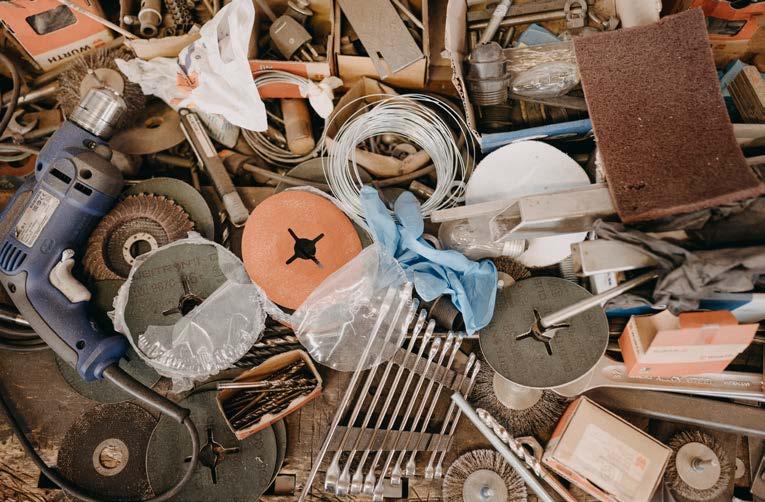
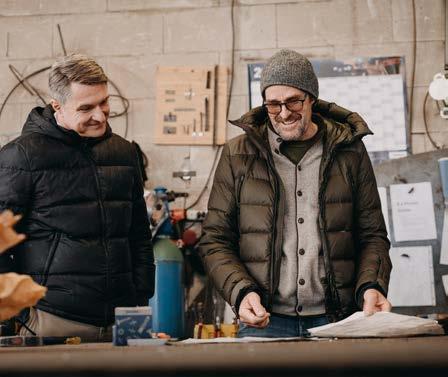
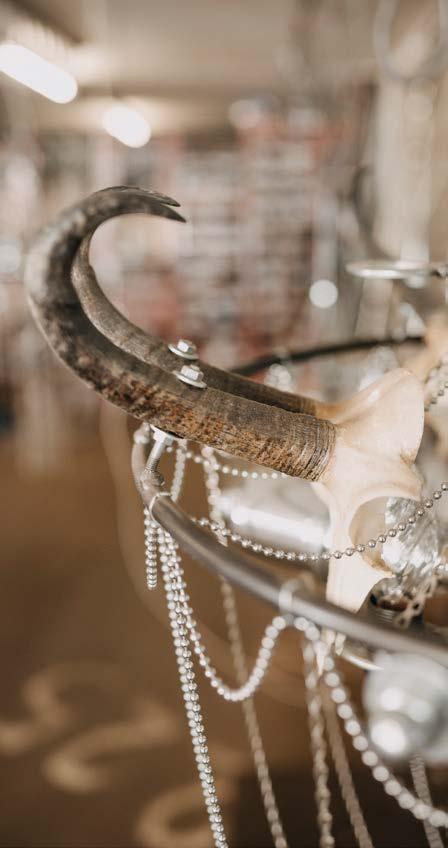
Heinz Julen also overcame the crisis of his life. He was able to reach an out-of-court settlement with his former partners. The irony of this story is that after the dis mantling of “Into the Hotel” he was invited to the Malmö Art Museum to pres ent his sketches, plans and models – as an artist. And that had always been his dream as a young artist: to one day have an exhibition in a renowned art house.
It’s midday and the construction noise has died down on the village square in front of the Backstage Hotel. Construc tion crews have been setting up tents and stages all morning, because tomorrow the “Zermatt Unplugged” festival begins:
120 shows with 58 artists in six days. The mirror balls will not stop spinning at the “Vernissage”, where the festival started in 2007.
J It’s showtime tomorrow, I won’t close an eye for a whole week.
B I really wanted to go to a few concerts, like every year. But because of our general meeting and an investors meeting, I have to get back to Basel today. We’ll see each other again next year.
J At the latest!
YoungStars They are the same age as their employer and thus belong to the selfie generation. 25-year-old young talents from Medartis locations around the world talk about the corporate culture, where they get their ideas from and things that should never be missing from the workplace.
Emily Donoghue Customer Service Specialist UKAs a member of the UK customer service team, bringing in new ideas is an important part of our job. We discuss how we can solve the problem of ensuring that our customers’ needs are met. I’ve been with Medartis for just over a year now and I enjoy every single day, the new challenges, the opportunity to be crea tive and not be slowed down. Hard work is appreciated and I enjoy the Medartis family that I am now part of.
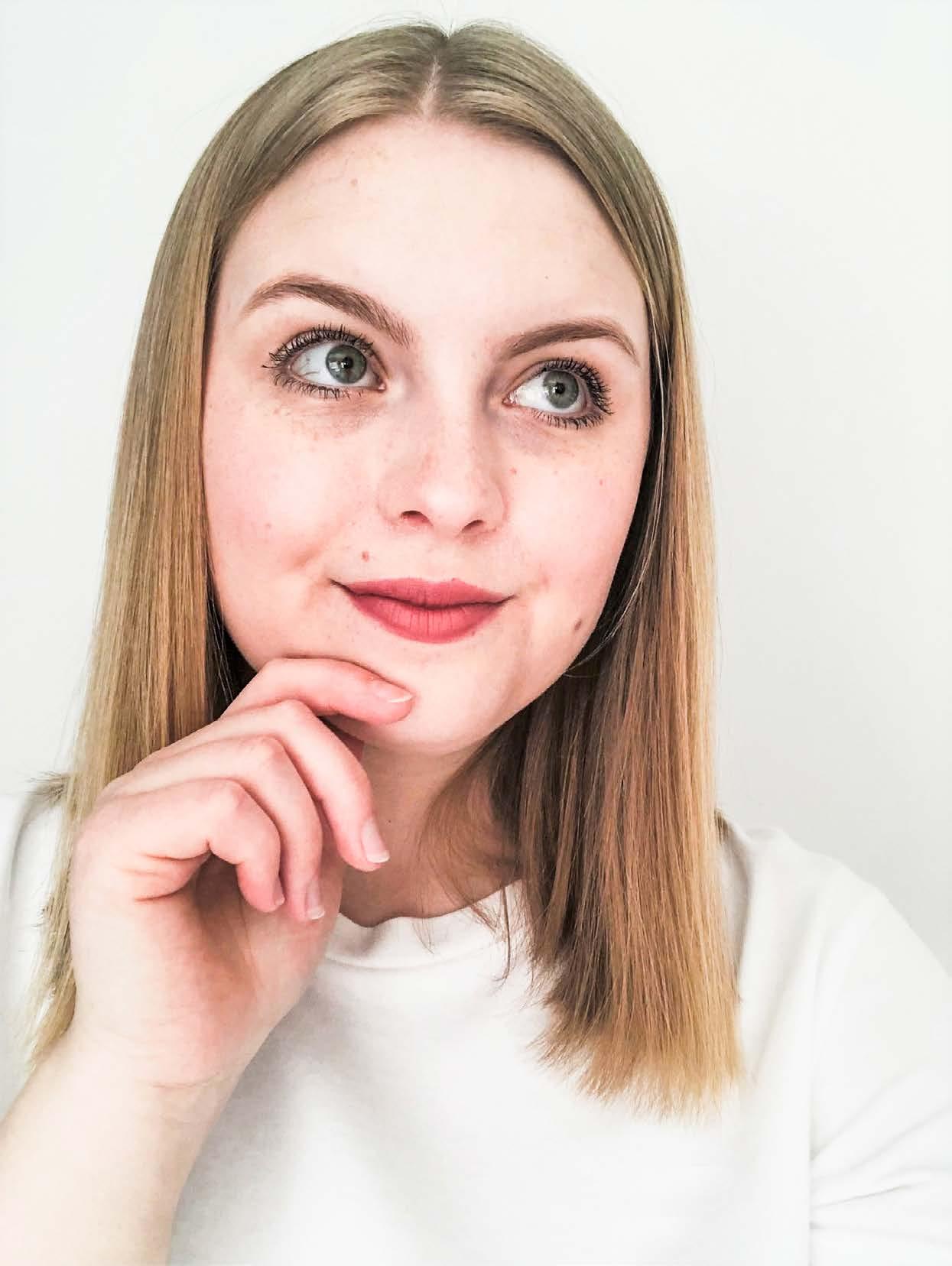
The culture at Medartis is motivating and teamwork is key. The innovative nature of Medartis means you learn something new every day and I love learning all the time. I also have a great team that allows me time for my family (including my dog) even during our busiest times.
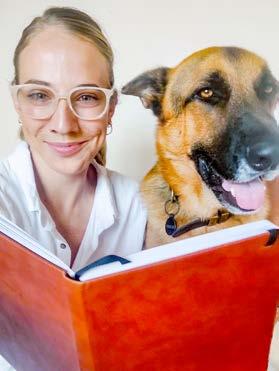 Léa Da Silva Marketing Assistant France
Léa Da Silva Marketing Assistant France
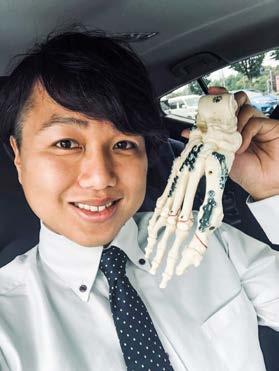
I would like to introduce you to Oscar, my best friend at the office. He is the most loyal employee when it comes to testing plates and screws on his head. His smile and funny nature make training sessions with him a real pleasure. He also loves selfies. I can’t wait for you to meet him!
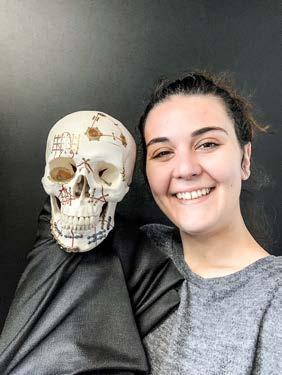 Akio Matsui Sales Representative Japan
Akio Matsui Sales Representative Japan
I have been working with our General Manager for almost two years now and I would like to thank him for his trust. He has entrusted me with many things and his advice is both helpful and encouraging. Let’s work together to expand Medartis in Japan!
Julian Sotelo Polymechanic Screw Manufacturing Switzerland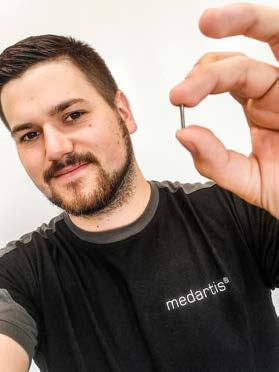
There is no doubt about my favourite product. The TriLock A-5750 screw accompanies me almost every day and I know its dimensions inside out. Inconspicuous, delicate and manufactured with utmost precision.
Ellen Dudzinski Product Manager USA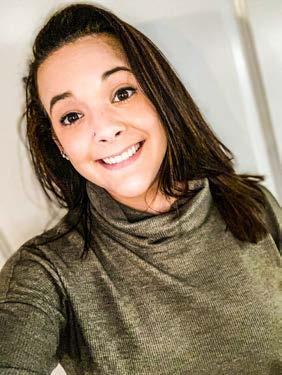
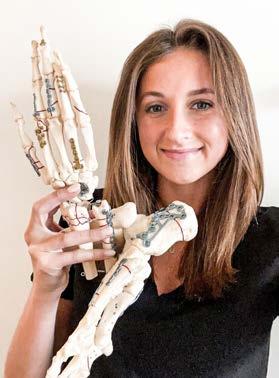
The culture at Medartis is refreshing. I have attended meetings with some of the most senior members of the company and I’m encouraged to voice my ideas. As a young professional, this is very encouraging and pushes me to do my best every day.
Fabian Wildi Polymechanic Screw Manufacturing SwitzerlandEight years ago, when I started my apprentice ship as a polymechanic at Medartis, my parents gave me a starter gift: this mug with the logo of my favourite football club on it, FC Basel. Since then it has been my faithful companion and is indispensable at work. Every working day starts with a cup of coffee from this mug.
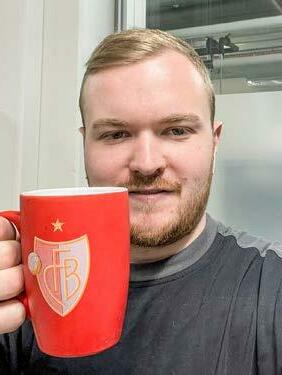 Kailynne Davis Sales Representative USA
Kailynne Davis Sales Representative USA
Whenever I think of Medartis, I think of my grandmother. My family used to call her the “bionic woman” because she had an inordinate amount of “hardware” throughout her body. When she talked about her experience, she was always enthusiastic, not only about the tech nology, but also about the competence of the surgical team. I hope I can help another grand mother as I did mine!
Unbelievable! Medartis is full of surprises – also in terms of numbers. Here are the most impressive figures about the company.
is the number of radius plates in the Medartis’s range to suit every anatomy.
Every 6 th fracture in the surgical emergency department is a fracture of the forearm (distal radius) close to the wrist. It is one of the most com mon fractures.
We live a can-do attitude, we are able to make decisions and keep our commitments.
is how high Medartis’s share rose from a low of CHF 33,2.
is the number of plates Medartis sells in a year for the treatment of distal radius fractures alone.
is the smallest tolerance in production, i.e. the per mitted deviation from the defined dimension.
We believe in a collaborative and inclusive work environment where everyone can voice their opinion and contribute actively.
> 500 N (or > 50kg) is the load bearing capacity of an upper arm implant before it starts to deform.
seconds
is how quick it takes for the smallest cortical screw to be produced; the longest compression screw takes 16 minutes and 12 seconds.
M CHF
is the cost of the entire Machine Park unit at the Headquarters in Basel. It is permanently modern ized to improve through put times and efficiency.
The five colored icons represent Medartis' corporate values, which it represents internally and externally and which shape its identity.
We grow and develop by learning from experience and from each other.
tons is the amount of titani um Medartis uses for implants every year. The production residues are recycled elsewhere
is the current number of stock keeping units in the product range.
Excellence is in our DNA We develop innovative technologies and deliver high quality solutions that make a difference to our patients and customers.
Speed and agility is our credo
We adapt quickly, execute tasks with boldness and have a strong sense of urgency.
The 0.1mm
mesh plate is the thinnest Medartis plate – as thin as a razor blade.
The youngest patient with a Medartist implant is 17 years old, while the oldest is 99.
mm is the length of the smallest Medartis screw – that corresponds to the width of a match.
is the number of bones in the human body. A baby is born with even more, about 350.
Hochbergerstrasse 60E 4057 Basel Switzerland +41 (0)61 633 34 34 info@medartis.com www.medartis.com
Publisher: Medartis AG, Hochbergerstrasse 60E, 4057 Basel
Project management and coordination: Fabian Hildbrand, Medartist AG Concept, research and editing: Dr. Christoph Kohler, Colin Bätschmann, Widmer Kohler AG Design: Jiří Chmelik, Noir Associates GmbH
Prepress: Christin Stiller, Medartis AG
Image editing: Jan Neversil, Eduard Lorenz, Medartis AG Druck: Gutenberg Beuys Feindruckerei
Videos: Alexander Zibold, Medartis AG
Translation (German-English): Dr. Katalin Morgan Copyright : Medartis AG ISBN 978-3-033-09410-9
The images used are from the Medartis archive.
Exceptions: Agata Serge (Preface, p. 2, 29)
Andi Cortellini (p. 6)
Basler Zeitung (p. 35)
Eduard Lorenz (p. 5, 9, 37, 41, 55, 75)
Ivan Steiner (p. 16–27, 84–91)
iStock by Getty Images (p. 35)
Keystone-SDA (p. 53, 78)
Stefan Jaeggi (p. 34)
YoungStars: self-portraits (p. 92–93).
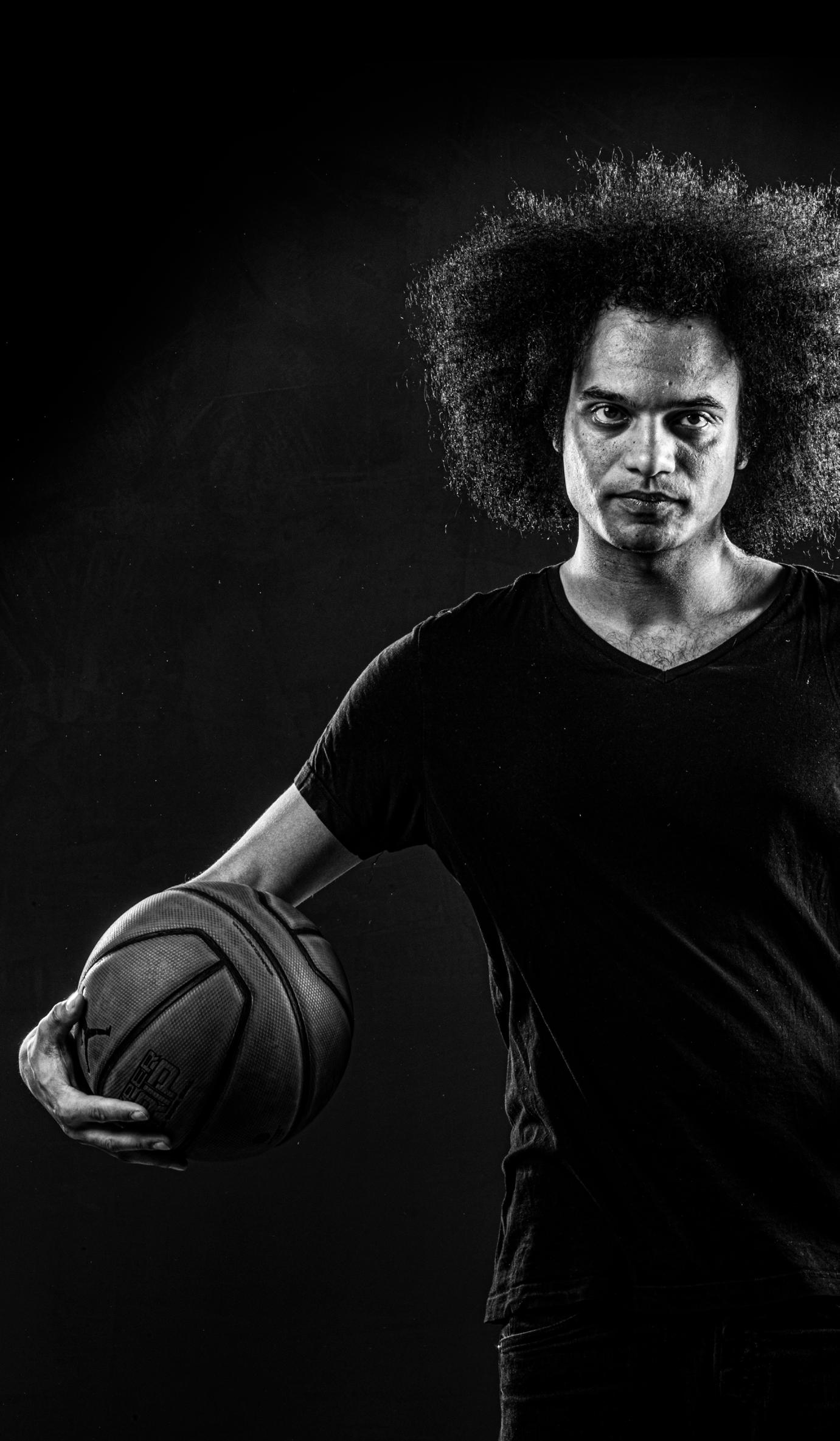
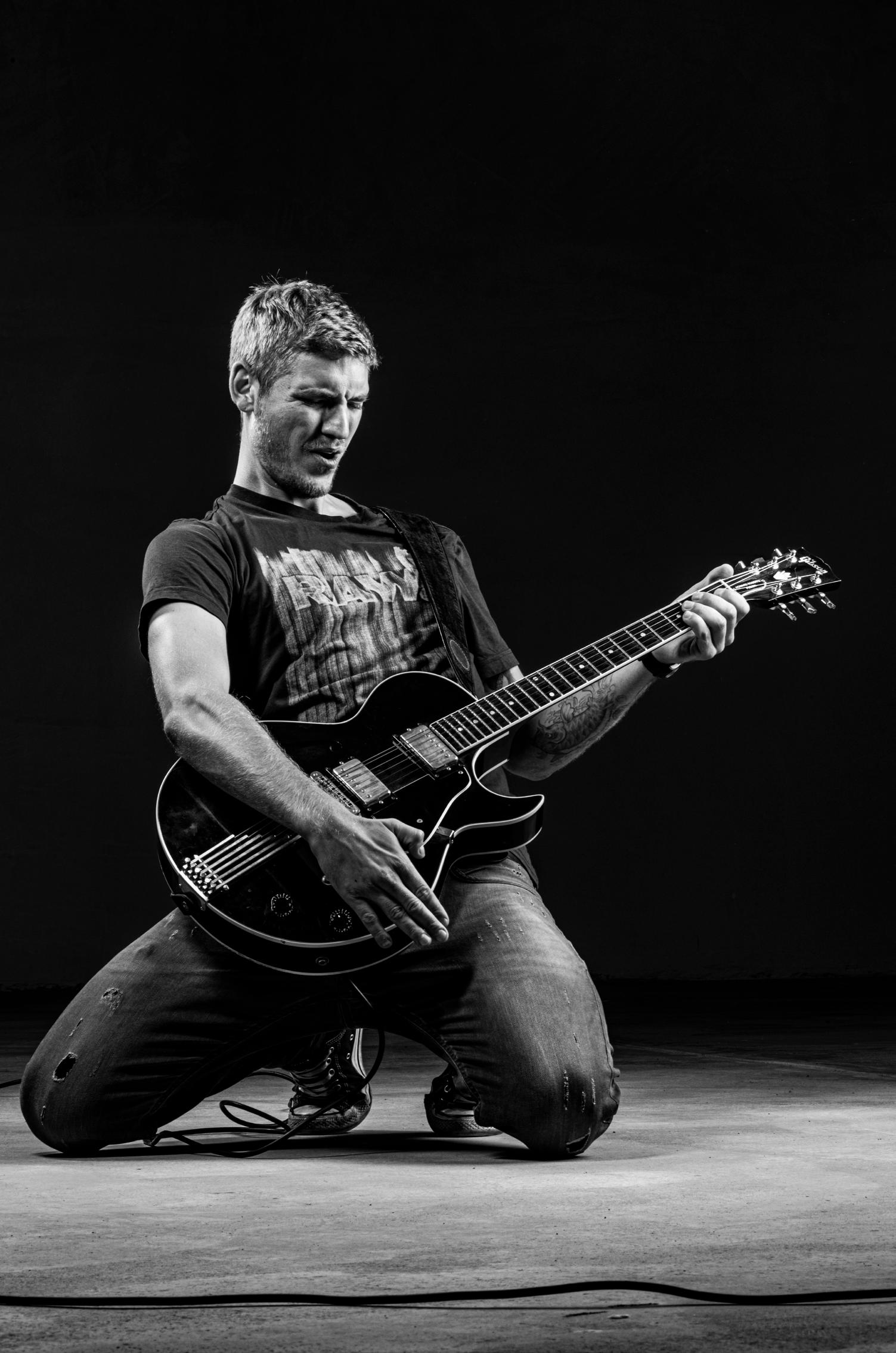
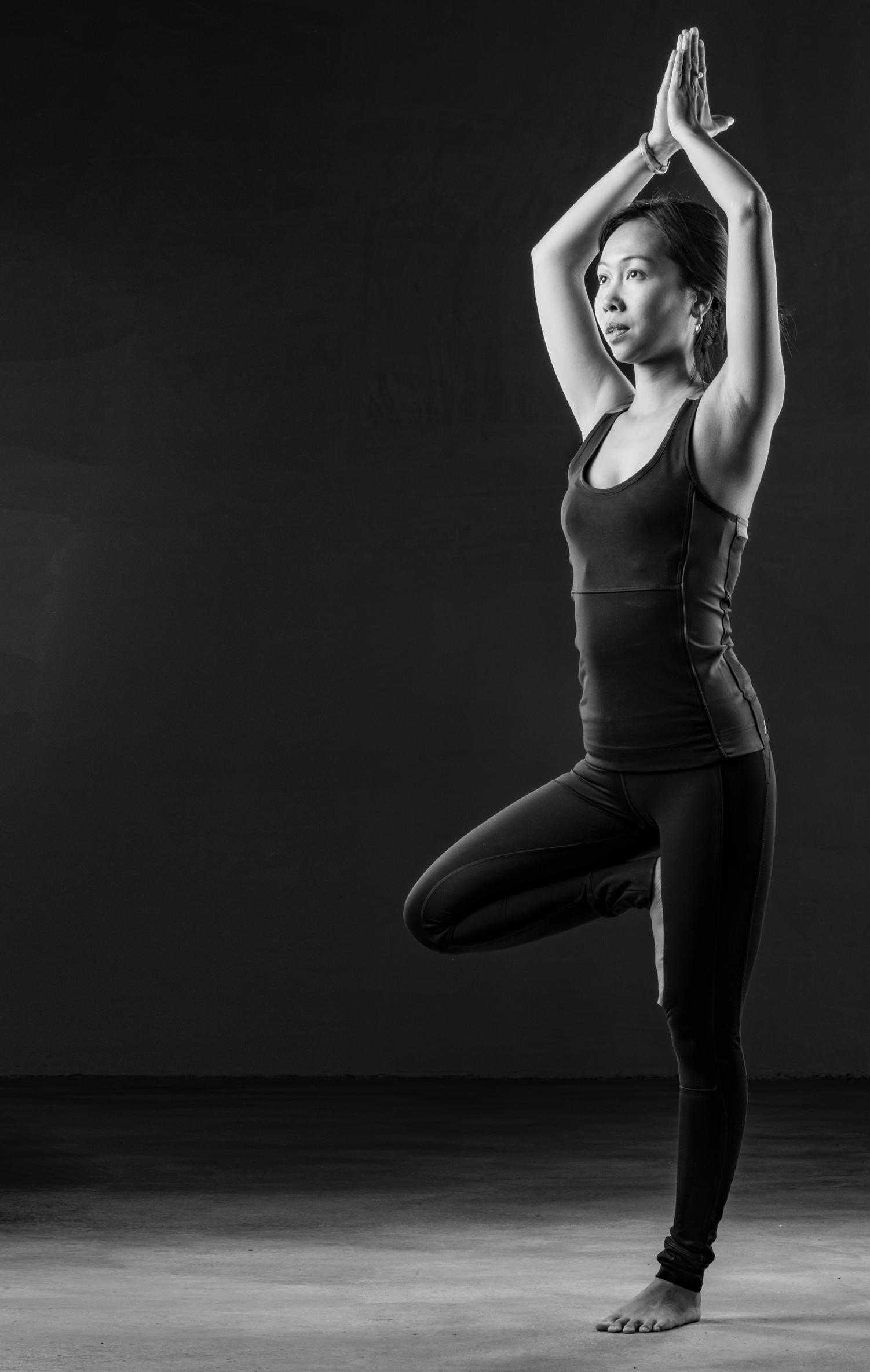
In 1997 Thomas Straumann had a bold idea. Together with his best friend from his youth Willi Miesch, he founded Medartis AG and entered the fiercely competitive market of osteosynthesis head-on. With clever ideas and a hands-on approach, they soon impressed surgeons all over the world. Medartis grew and so did its product range, from head to toe. Thanks to pioneering technologies, the former start-up developed into a global innovation leader in the osteosynthesis market.